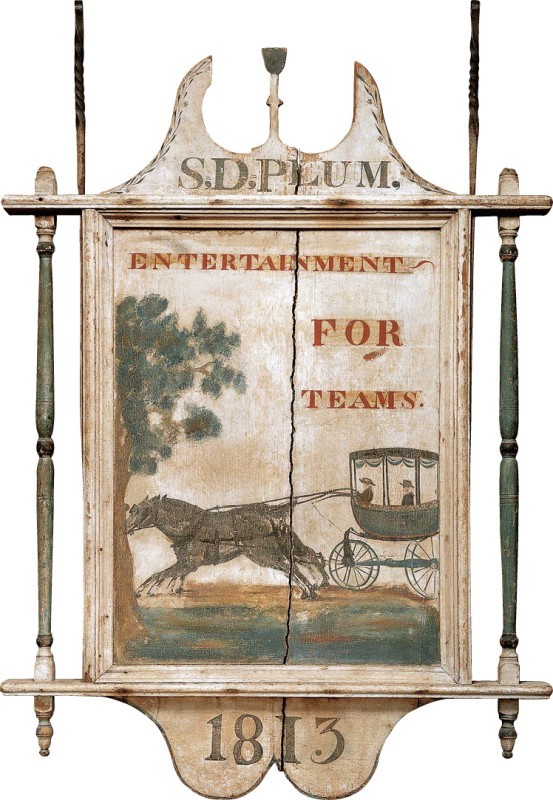
S. D. Plum tavern sign (double-sided, recto), probably Meriden, Connecticut, 1813. Paint on pine with iron. H. 51", W. 34", D. 3". (Courtesy, American Folk Art Museum, gift
of Ralph Esmerian, acc. 2013.1.55; photo, 2000 John Bigelow Taylor; Art Resource, New York.)
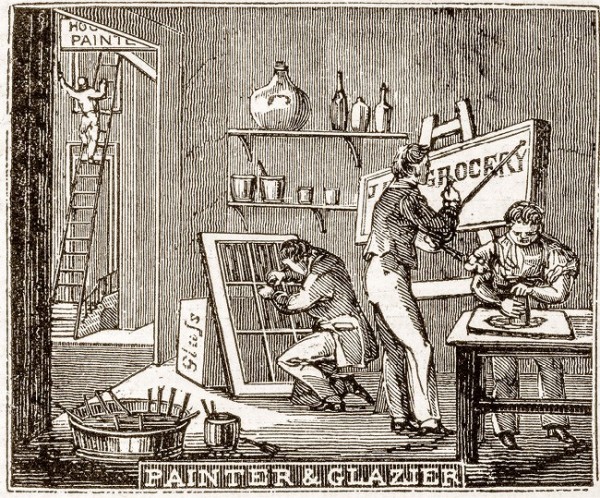
Shop of the Painter and Glazier, in Edward Hazen, The Panorama of Professions and Trades (Philadelphia: U. Hunt, 1839), p. 215. (Courtesy, Winterthur Library, Printed Book
and Periodical Collection.)
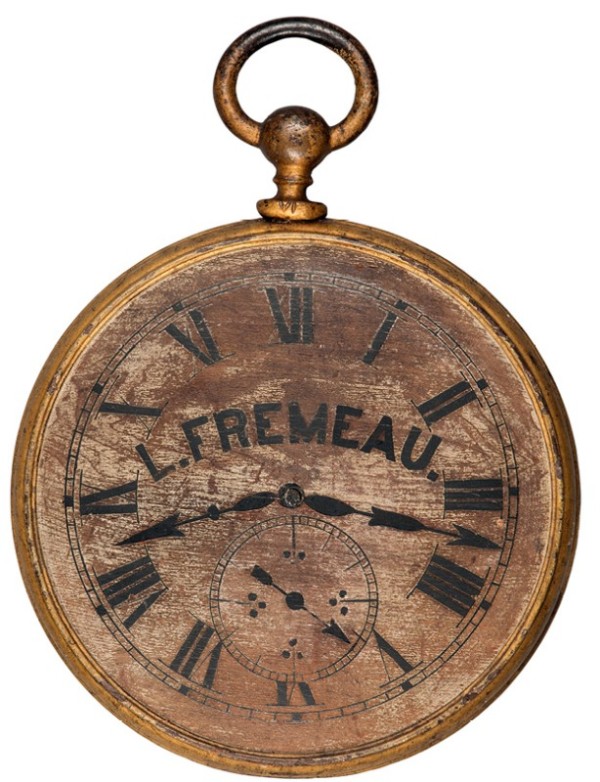
Jeweler’s trade sign, Louis Fremeau, Burlington, Vermont, nineteenth century. Carved and painted wood. H. 22", Diam. 15". (Courtesy, Collection of Shelburne Museum, gift of Mrs. Louis Fremeau, acc. 1958-5.2; photo, Andy Duback.)
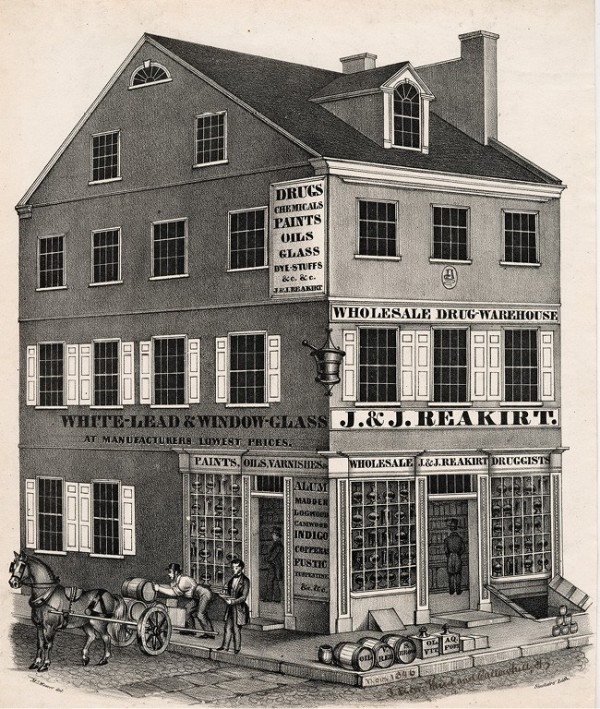
Drug and paint store, J. & J. Reakirt, Philadelphia, Pennsylvania, ca. 1844. Lithograph drawn by Mathias S. Weaver, printed by Thomas Sinclair. H. 16", W. 13". (Courtesy, The Library Company of Philadelphia.) The building exhibits several types of signs: informational boards fixedflat against the external structure, information painted directly on an exterior surface, and a three-dimensional mortar and pestle suspended at the second-story level at a corner of the building.
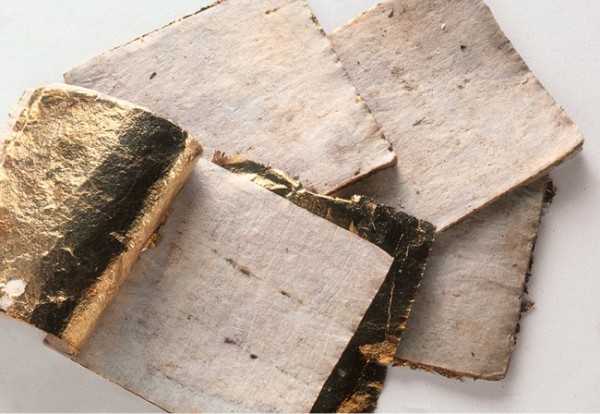
Books of gold leaf, probably England, 1800–1830. Gold leaf interfaced with laid paper. H. 3 9/16", W. 3 13/16" (closed booklet). (Courtesy, Monmouth County Historical Association, Freehold, New Jersey; photo, Winterthur Museum.)

Detail of a delegation of Native Americans to Philadelphia, New Lutheran Church, in Fourth Street Philadelphia, drawn, engraved, and colored by William Russell Birch (1755–1844) and Thomas Birch (1779–1851), published in The City of Philadelphia . . . as It Appeared in the Year 1800 [hereafter Birch’s Views of Philadelphia] (Philadelphia: W. Birch and Son, 1800), plate 6. (Courtesy, Winterthur Library, Printed Book and Periodical Collection.) The scene describes a method of hanging shop signs above the walkways of the city. The male figure with an outstretched arm at the right front is said to be Frederick Augustus Muhlenberg, speaker of the U.S. House of Representatives.
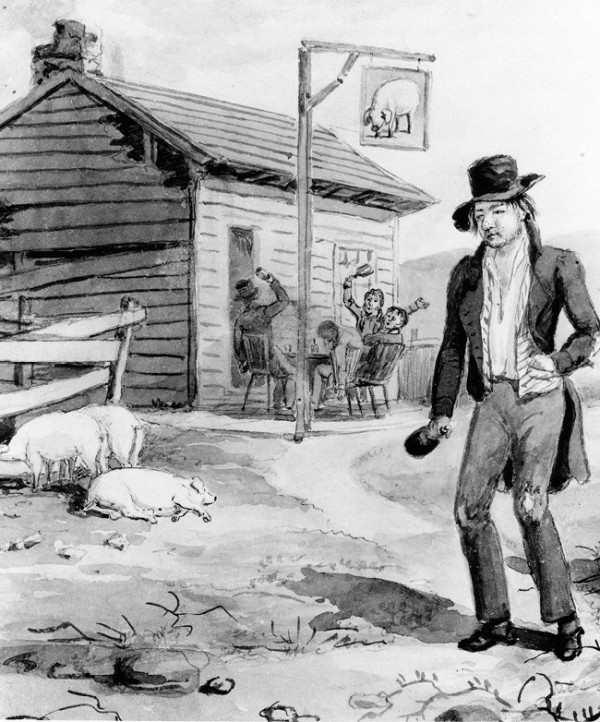
Detail of Virtue and Vice, Sobriety and Drunkenness, Thomas Birch, Philadelphia, ca. 1830. Ink and watercolor on paper. H. 10 1/16", W. 14 7/16". (Courtesy, Winterthur Museum,
acc. 67.0131.)
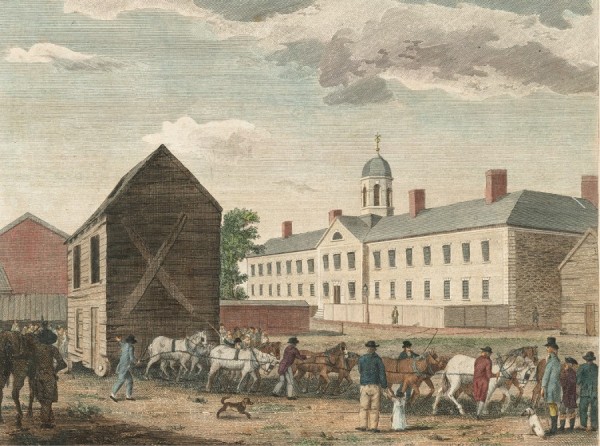
Moving a building in Philadelphia, Goal, in Walnut Street Philadelphia, drawn, engraved, and colored by William Russell Birch and Thomas Birch, published in Birch’s Views of Philadelphia, plate 24. (Courtesy, Winterthur Library, Printed Book and Periodical Collection.)
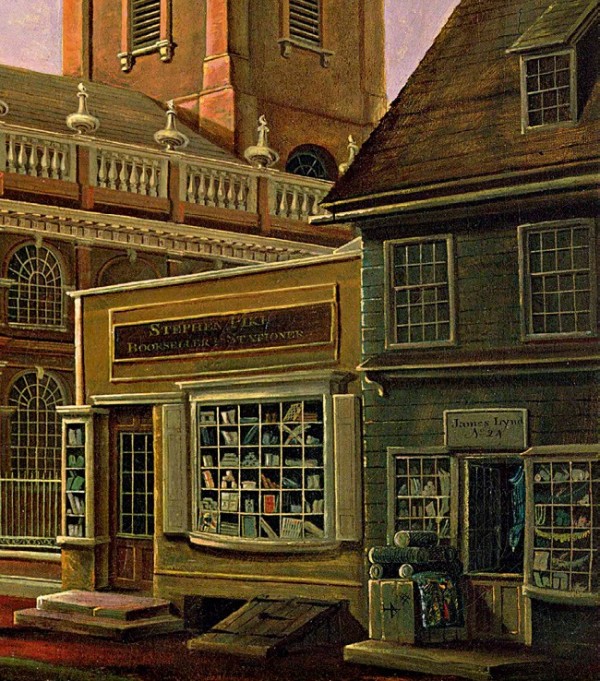
Detail of shop facades adjacent to Christ Church, Philadelphia, from Christ Church, 1811, by William Strickland (1787–1854), Philadelphia, Pennsylvania, 1811. Oil on canvas. Overall H. 48", W. 52". (Courtesy, Historical Society of Pennsylvania Collection, Bridgeman Images.) The shop facades detail a show box next to the shop door at the left and interior display shelves at transom levels in the bow window and the windows of the adjacent building at the right.
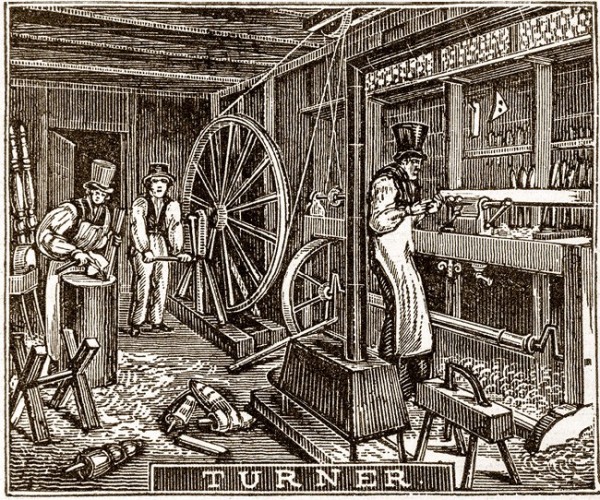
Shop of the Turner, in Edward Hazen, The Panorama of Professions and Trades (Philadelphia: U. Hunt, 1839), p. 219. (Courtesy, Winterthur Library, Printed Book and Periodical Collection.)

Shop of the Hatter, in Edward Hazen, The Panorama of Professions and Trades (Philadelphia: U. Hunt, 1839), p. 52. (Courtesy, Winterthur Library, Printed Book and Periodical Collection.)
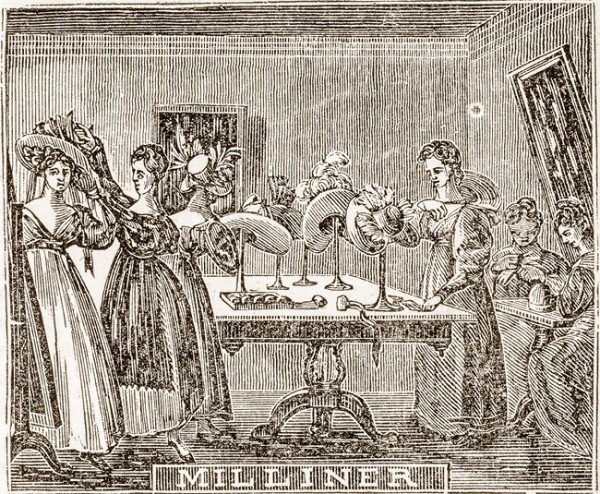
Shop of the Milliner, in Edward Hazen, The Panorama of Professions and Trades (Philadelphia: U. Hunt, 1839), p. 61. (Courtesy, Winterthur Library, Printed Book and Periodical Collection.)
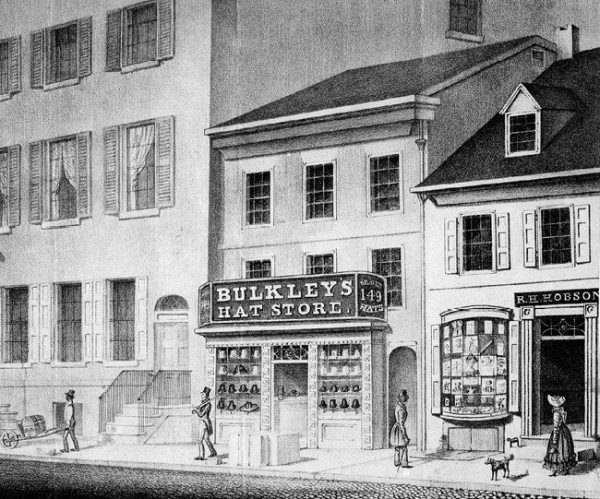
Detail of the Hat Store of C. and J. H. Bulkley, Philadelphia, Pennsylvania, ca. 1833. Lithograph printed by Childs and Inman. H. 7 1/2", W. 10 1/2". (Courtesy, The Library Company of Philadelphia.) The right-side return of the sign reads “BEAVER HATS.”
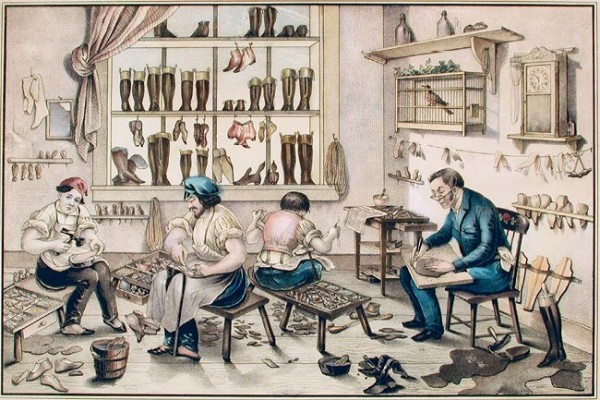
The Shoemakers, New York, ca. 1855. Chromolithograph printed by E. B. and E. C. Kellogg. H. 8 1/2", W. 12 1/2". (Courtesy, Connecticut Historical Society, acc. 1982.7.8.)

Lewis Miller (1796–1882), Jacob Nell, Barber, Shaving Nicklas Huber, York, Pennsylvania, ca. 1815–1825. Small ink and watercolor drawing and text on paper. (Courtesy, York County History Center, York, Pa.)
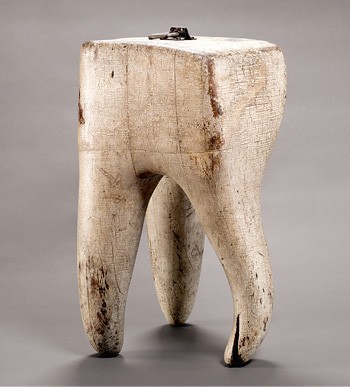
Dental trade sign of large tooth, date unknown. Carved and painted wood. H. 23 3/4", W. 12 1/2", D. 13 1/2". (Courtesy, Collection of Shelburne Museum, gift of Julius Jarvis, acc. 1962-181.)
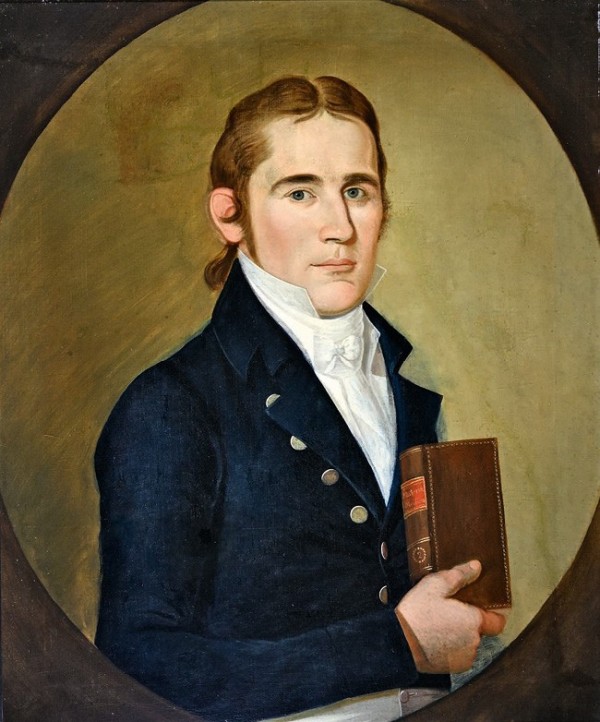
William Jennys (1774–1858), Portrait of Dr. John Brickett [1774–1848], Newburyport, Massachusetts, ca. 1805–1807. Oil on canvas. H. 29 1/2", W. 25". (Courtesy, Collections of the Museum of Old Newbury.) Dr. Brickett also was an apothecary and is portrayed holding a leather-bound volume of Materia Medica.
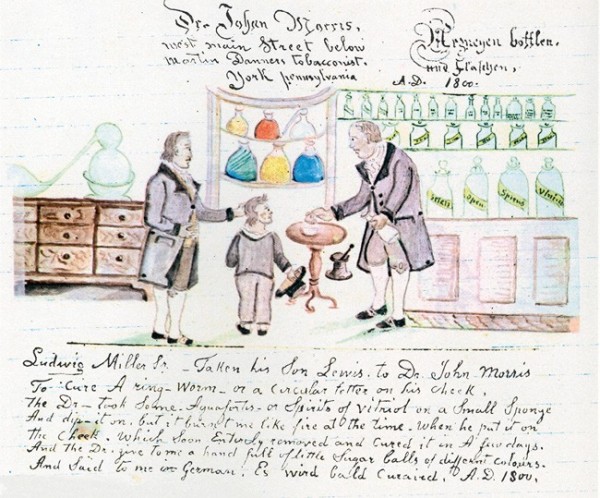
Lewis Miller, Office of Dr. Johan [John] Morris, York, Pennsylvania, 1800. Ink and watercolor drawing and text on paper. (Courtesy, York County History Center, York, Pa.) Pictured are Dr. Morris, Lewis Miller Sr., and his young son Lewis, later the chronicler of York.
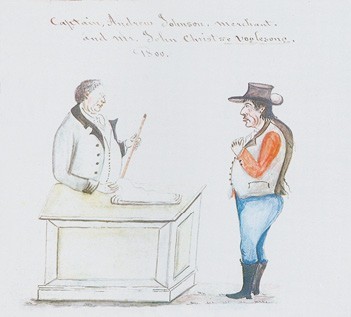
Lewis Miller, Store of Captain Andrew Johnson, Merchant, York, Pennsylvania, 1800. Ink and watercolor drawing and text on paper. (Courtesy, York County History Center, York, Pa.)
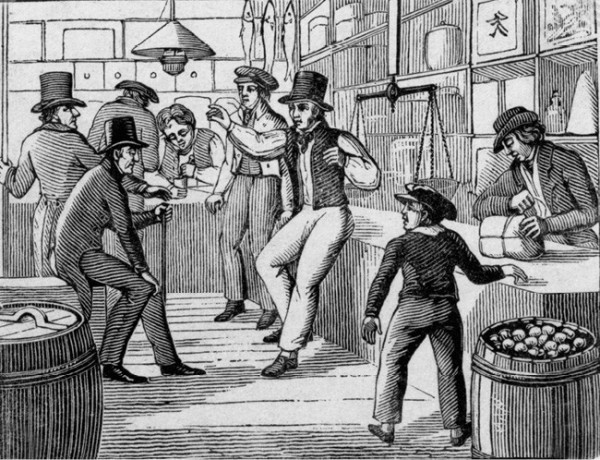
Alexander Anderson (1775–1870), [A Rural Grocery Store], northeastern United States, ca. 1825–1850. Wood engraving. (Courtesy, The Miriam and Ira D. Wallach Division of Art, Prints, and Photographs: Print Collection, “Scenes of daily life in nineteenth-century America,” The New York Public Library Digital Collections, 1794–1870.)

Shop of the Tailor, in Edward Hazen, The Panorama of Professions and Trades (Philadelphia: U. Hunt, 1839), p. 59. (Courtesy, Winterthur Library, Printed Book and Periodical Collection.) The owner of the shop or a clerk is using a desk at the extreme left.
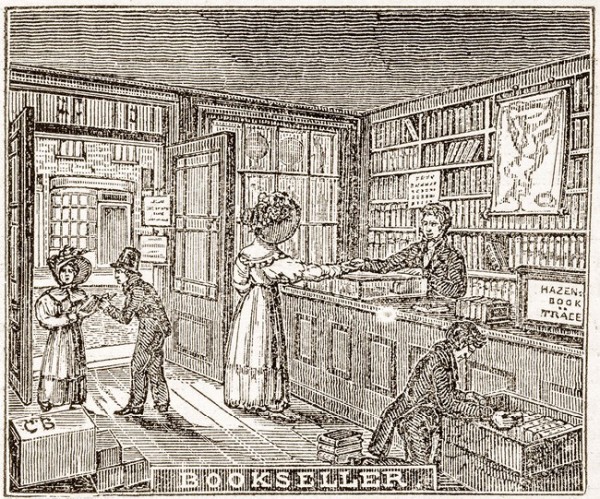
Shop of the Bookseller, in Edward Hazen, The Panorama of Professions and Trades (Philadelphia: U. Hunt, 1839), p. 195. (Courtesy, Winterthur Library, Printed Book and Periodical Collection.)
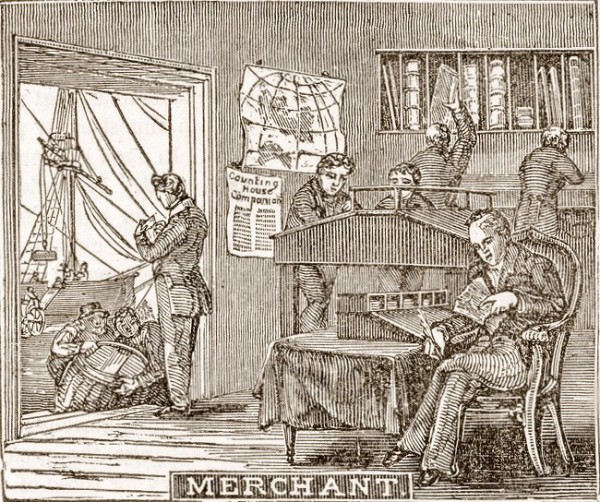
Counting House of the Merchant, in Edward Hazen, The Panorama of Professions and Trades (Philadelphia: U. Hunt, 1839), p. 109. (Courtesy, Winterthur Library, Printed Book and Periodical Collection.) The double-sided slant-top desk on tall legs was of a size to accommodate up to four clerks. A small portable desk with slanted writing surface and pigeonholes on the table below was available for additional use. The large case mounted on the wall held ledgers and other account books for easy reference at a counter along the wall.
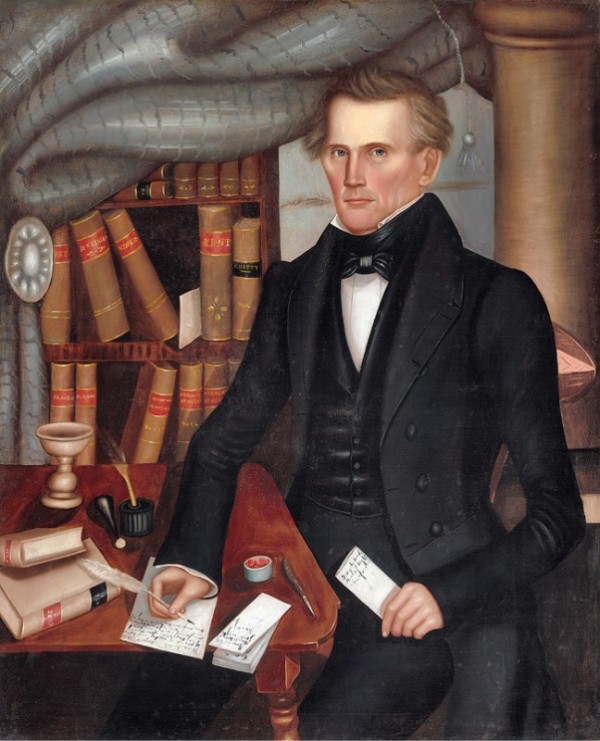
Horace Bundy (1814–1883), Vermont Lawyer, Manchester, Vermont, 1841. Oil on canvas. H. 44", W. 35 1/2". (Courtesy, National Gallery of Art, acc. 1953.5.4.) The anonymous lawyer’s law books are handy in the bookcase behind him. His writing equipment is at hand: a sharpened quill pen, an inkpot with an additional quill pen, a tall cup-shaped sander containing blotting sand to dry his writing, a small pot containing red sealing wax, and a personal seal with a bulbous handle, the seal at the opposite end containing the lawyer’s initials or a device.
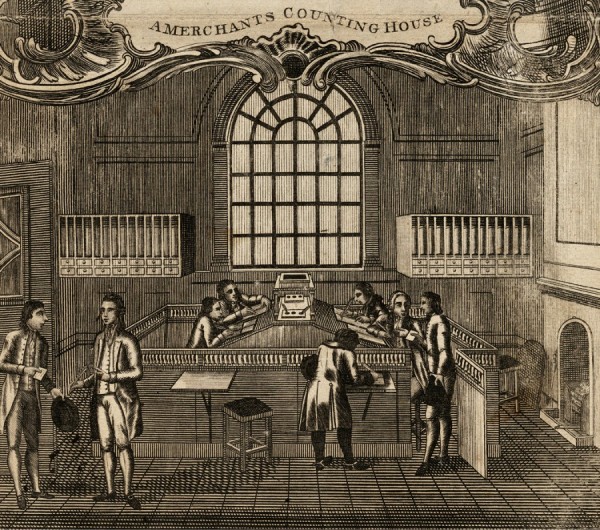
Detail of A Merchant’s Counting House, Philadelphia, Pennsylvania, ca. 1790–1800. Engraved by Alexander Lawson (1773–1846), published by T. Dobson, PR 031. (Courtesy, Bella C. Landauer Collection of Business and Advertising Ephemera, New-York Historical Society, 98124d.) A desk with a double-sided slant top accommodates four clerks within a gated enclosure. Small writing tables are attached to the gated wall, and two large cases on the back wall hold account books. [New-York Historical Society is now known as New York Historical.]

Ralph Earl (1751–1801), Portrait of Elijah Boardman (1760–1846), New Milford, Connecticut, 1789. Oil on canvas. H. 83", W. 51". (Copyright © The Metropolitan Museum of Art, bequest of Susan W. Tyler, 1979, acc. 1979.395; Art Resource, New York.) Boardman was a dry goods merchant in Connecticut. Green baize covers the slanted writing surface of his tall bookcase-desk.
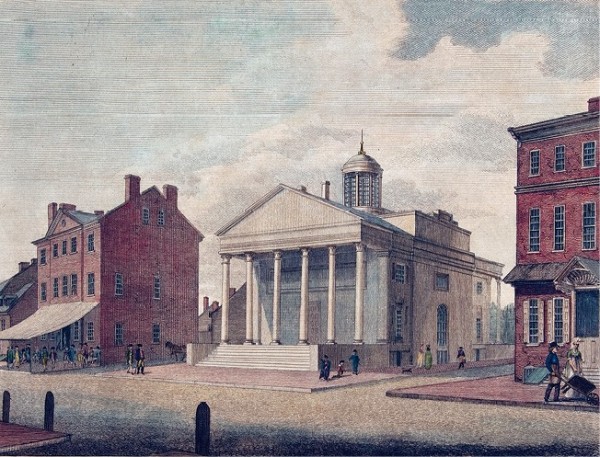
Bank of Pennsylvania, South Second Street, Philadelphia, drawn, engraved, and colored by William Russell Birch and Thomas Birch, published in Birch’s Views of Philadelphia, plate 27. (Courtesy, Winterthur Library, Printed Book and Periodical Collection.) The bank was designed by Benjamin Henry Latrobe (1764–1820) in the new Greek Revival style and built between 1798 and 1801. The building to the left with the front awning is City Tavern which, like the Tontine Coffee House in New York, served as a merchant’s exchange.

Lewis Miller, Interior of York Bank, York, Pennsylvania, 1812. Ink and watercolor drawing and text on paper. (Courtesy, York County History Center, York, Pa.) Pictured are John Schmitd [sic], cashier, and the Reverend Daniel Dunn, patron.
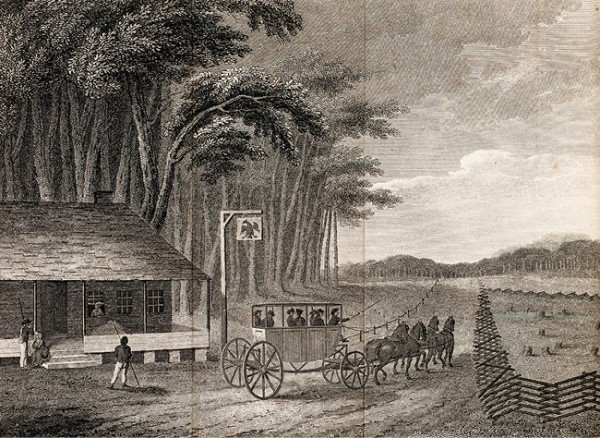
American Stage Waggon, drawn by Isaac Weld, engraved by James Storer, published by I. Stockdale, London, 1798. Illustrated in Isaac Weld, Travels through the States of North America and the Provinces of Upper Canada and Lower Canada . . . 1795, 1796, and 1797, 2 vols. (London: John Stockdale, 1800), 1: frontispiece. (Courtesy, Winterthur Library, Printed Book and Periodical Collection.)
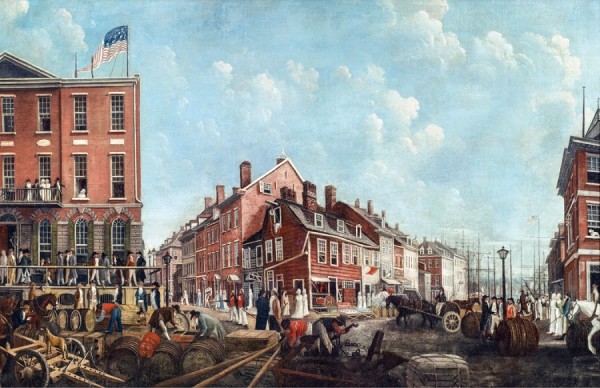
Francis Guy (1760–1820), The Tontine Coffee House, New York, New York, ca. 1797. Oil on linen. H. 43", W. 65". (Purchase, the Louis Durr Fund, New-York Historical Society, acc. 1907.32.) The Coffee House was located at the intersection of Wall and Water Streets adjacent to the East River.
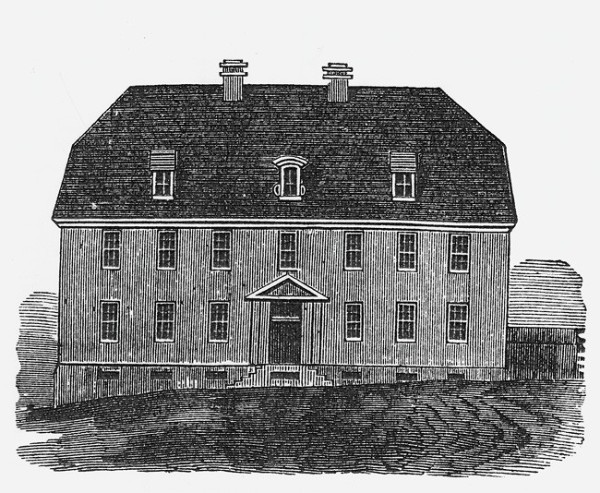
The Sun Inn, Bethlehem, Pennsylvania, in William C. Reichel, The Old Sun Inn at Bethlehem, Pa., 1758 (Doylestown, Pa.: W. W. H. Davis, 1876), frontispiece. (Courtesy, Moravian Archives, Bethlehem, Pennsylvania; photo, Winterthur Museum.)
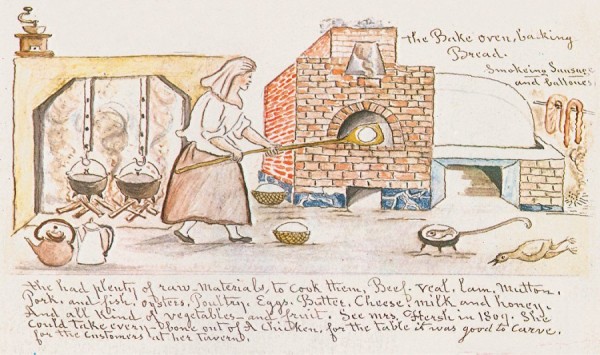
Lewis Miller, Mrs. Hersh’s Tavern, York, Pennsylvania, 1809. Ink and watercolor drawing and text on paper. (Courtesy, York County History Center, York, Pa.) Pictured is a kitchen in a hostelry of German-American background. Food is being prepared in large kettles, long-handled frying skillets, and a bake oven, where the cook-proprietor is using a long-handled wooden peel to insert a loaf of bread for baking after the dough has risen in its cloth-covered basket like those in the middle ground.
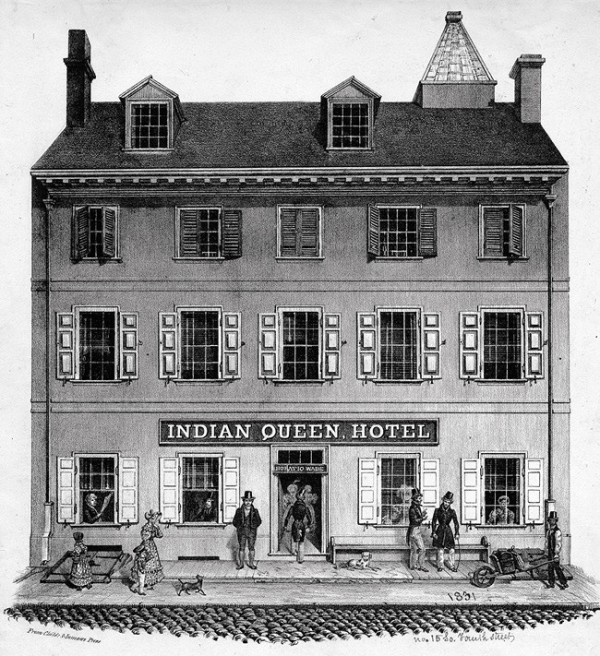
Indian Queen Hotel, Philadelphia, ca. 1831. Lithograph printed by Childs and Inman. H. 12 3/8", W. 11 1/2". (Courtesy, The Library Company of Philadelphia.) Several decades after the visit of Francisco de Miranda to Philadelphia, the Indian Queen Inn became a hotel at the same location, Fourth and Chestnut Streets.
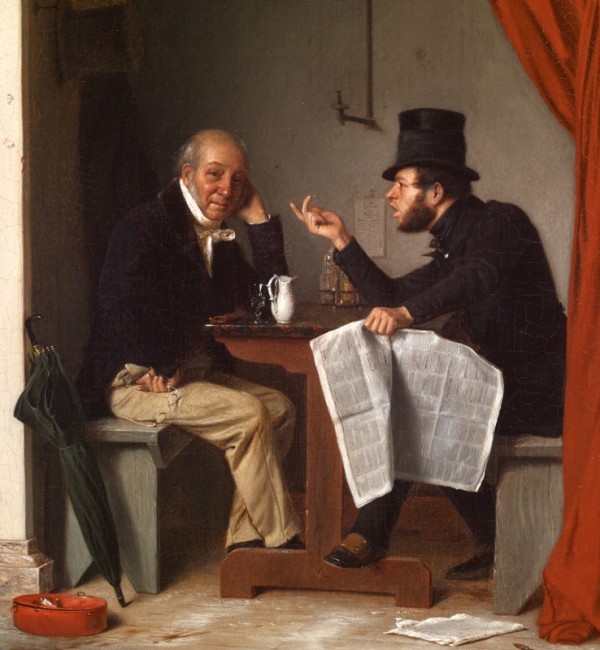
Richard Caton Woodville (1825–1856), Politics in an Oyster House, painted in Düsseldorf for a Baltimore patron, 1848. Oil on canvas. H. 16", W. 13". (Courtesy, The Walters Art Museum, Baltimore.) The setting here closely matches the description of the three-sided booths in the Golden Tun Tavern, Philadelphia, each booth also furnished with two benches and a table and a curtain on a rod at the front that could be drawn for privacy. The lighting fixture is an intrusion of the later period of the canvas.
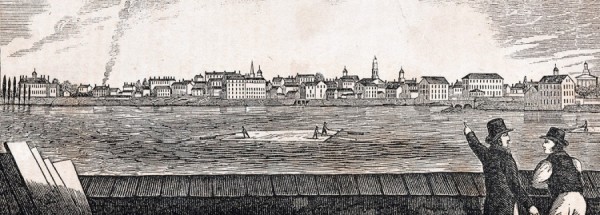
South View of Trenton, N.J., in John Warner Barber and Henry Howe, Historical Collections of the State of New Jersey (Newark, N.J.: Benjamin Olds, 1844), facing p. 280. (Courtesy, Winterthur Library, Printed Book and Periodical Collection.) The two rafts of timber manned by helmsmen on the Delaware River probably are destined for a Philadelphia market.
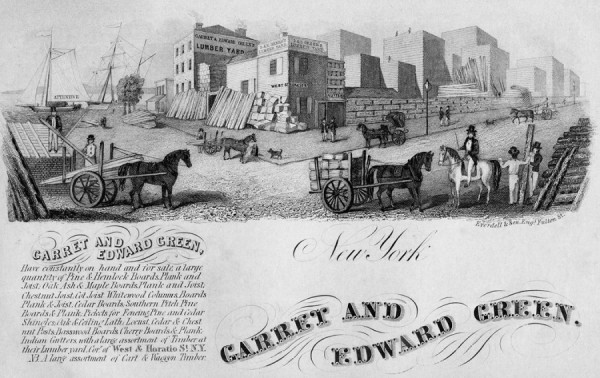
Handbill, Garrett and Edward Green, New York, New York, ca. 1845. Engraved by Everdell and Son. H. 5 1/4", W. 8 3/8". The mammoth size of this facility speaks to the rapid expansion of the city before the mid-nineteenth century.
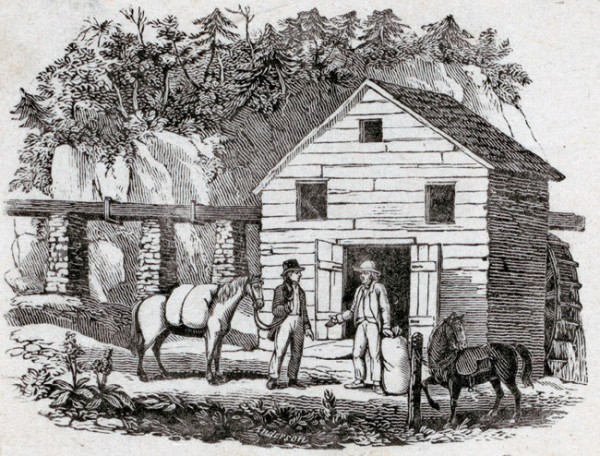
Alexander Anderson (1775–1870), [A Rural Gristmill], northeastern United States, ca. 1825–1850. Wood engraving. (Courtesy, The Miriam and Ira D. Wallach Division of Art, Prints, and Photographs: Print Collection, “Scenes of daily life in nineteenth-century America,” The New York Public Library Digital Collections, 1794–1870.) The power source for the gristmill is just visible behind the building: a large vertical overshot waterwheel placed in motion by water carried to it in an elevated millrace from the water source.
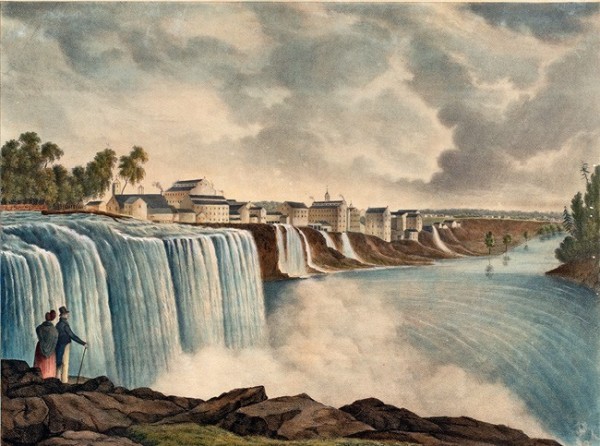
The Upper Falls of the Genesee River at Rochester, N. Y., from the East Bank Looking N.W., Rochester, New York, 1835. Drawn by J. Young, lithographed by J. H. Bufford, published by C. and M. Morse, PR 020. (Courtesy, Collection of Geographic Images, New-York Historical Society, 98180d.) From a small village established at the start of the nineteenth century, Rochester increased rapidly in area and population after 1825 following the opening of the Erie Canal. Wheat, already being grown in the Genesee Valley, quickly became a leading crop when the power of the falls of the Genesee River was harnessed. That power supported the vastflour milling complex shown here, among other businesses. [New-York Historical Society is now known as New York Historical.]
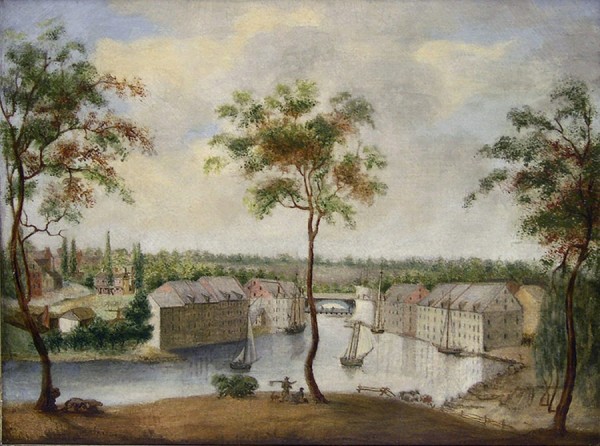
Bass Otis (1784–1861), Brandywine Mills, Wilmington, Delaware, ca. 1840. Oil on canvas. H. 31 1/4", W. 40 3/8" (framed). (Courtesy, Delaware Historical Society, gift of H. Fletcher Brown, 1941.051.)
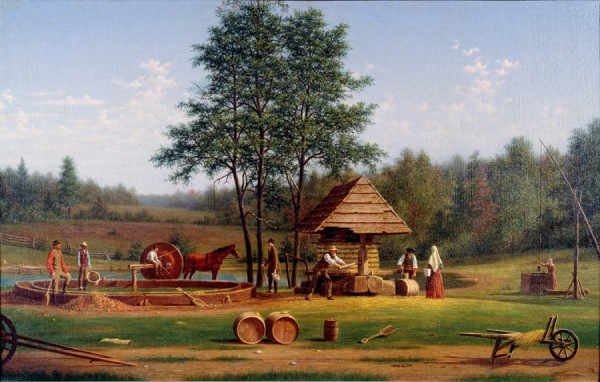
William Moore Davis (1829–1920), Cider-Making on Long Island, ca. 1865–1875. Oil on canvas. H. 19 3/4", W. 29 3/4". (Courtesy, Fennimore Art Museum, Cooperstown, New York, gift of Stephen C. Clark, acc. 368.1955; photo, Richard Walker.)
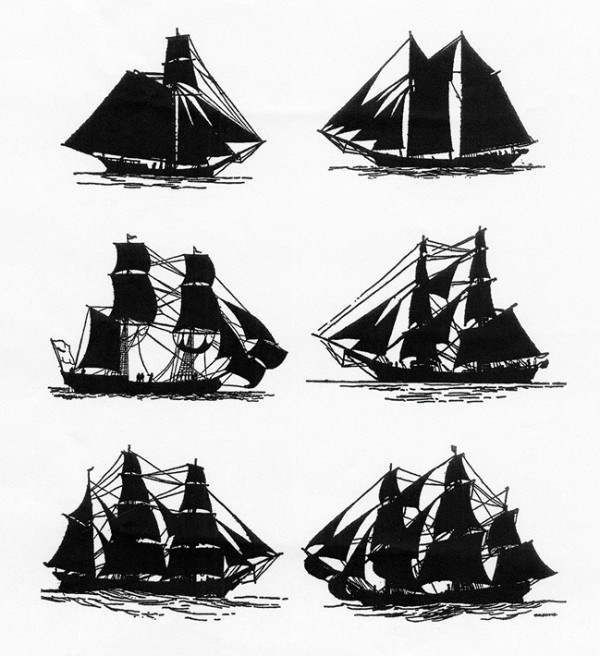
Principal types of American sailing vessels, 1760–1840. Composite from Charles G. Davis, Shipping and Craft in Silhouette (Salem, Mass.: Marine Research Society, 1929), figs. 8, 17, 23, 28, 51. (Courtesy, Peabody Essex Museum.) The distinctive shape, number, and arrangement of sails and masts differentiate types of vessels without reference to the hull.
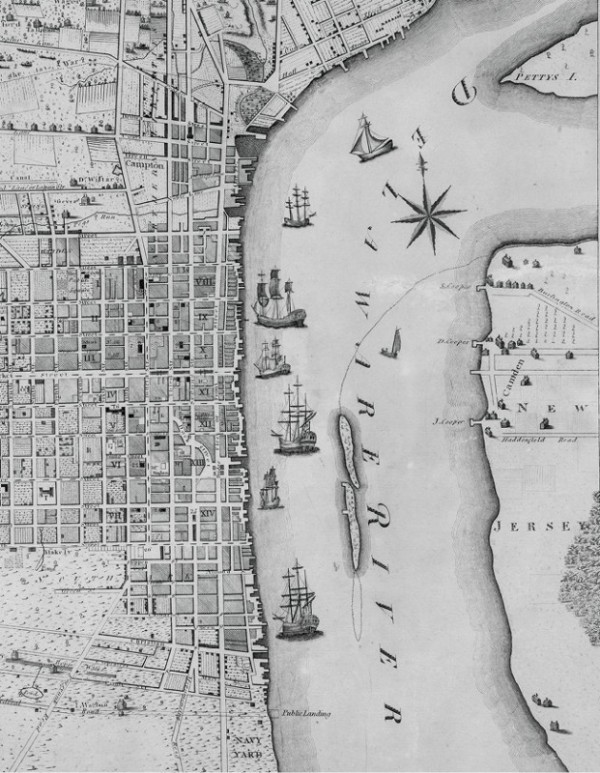
Detail of a Plan of the City of Philadelphia and Its Environs, Pierre Charles Varlé, cartographer, Robert Scot, engraver, Philadelphia, Pennsylvania, 1802. Line etching on laid paper (state two). Overall H. 20 1/2", W. 27". (Courtesy, Winterthur Museum, acc. 1960.0358.001 A.) The city’s many shipping wharves along the Delaware River, including parts of the Northern Liberties and Southwark, speak to the flourishing state of Philadelphia when it served as the national capital from 1790 to 1800.
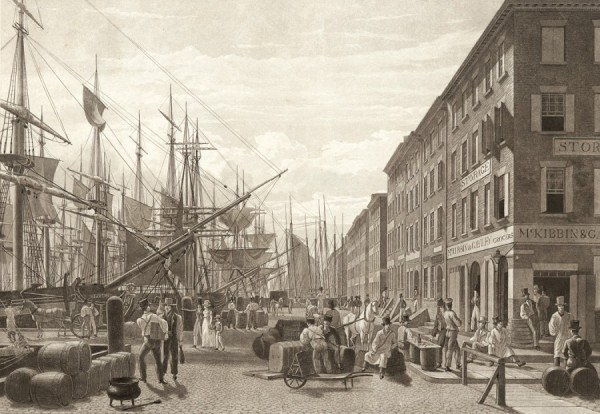
South St. from Maiden Lane, New York, New York, ca. 1834. Aquatint drawn and etched by William J. Bennett (1787–1844) after the engraver’s painting, published by Henry J. Megarey. (Courtesy, The Miriam and Ira D. Wallach Division of Art, Prints, and Photographs: The I. N. Phelps Stokes Collection of American Historical Prints, The New York Public Library Digital Collections.) The site on South Street is on the East River looking south from Maiden Lane, where two blocks farther along the waterfront the observer could view the Tontine Coffee House a short distance up Wall Street and perceive the full impact of America’s leading business center.
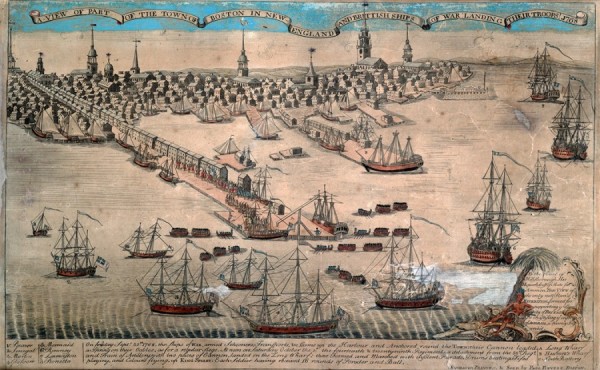
A View of Part of the Town of Boston in New-England and Brittish [sic] Ships of War Landing Their Troops!, Boston, 1770. Line engraving by Paul Revere (1735–1818). H. 8 5/8", W. 15 3/8". (Courtesy, Boston Athenaeum, George Francis Parkman Fund purchase, 1955, acc. 1955.2.) A sizeable row of storehouses stood on Long Wharf from before the Revolution.
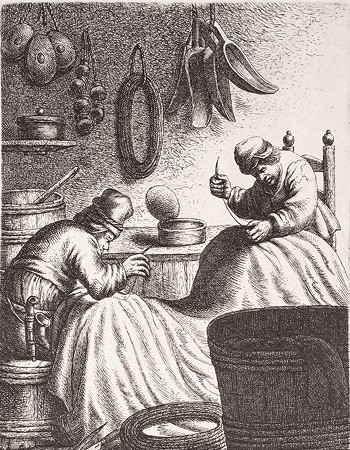
Sailmakers, in Jan Joris van der Vliet, [Book of Crafts and Trades] (Holland, 1635; reprinted in Harry Bober, Jan Van Vliet’s Book of Crafts and Trades [Albany, N.Y.: Early American Industries Association, 1981])), pl. 11. (Photo, Winterthur Library.) Although this is an early representation of the craft of sail making, craft procedure was not significantly changed by use of a sailmaker’s bench for seating and easy access to the tools of the trade.
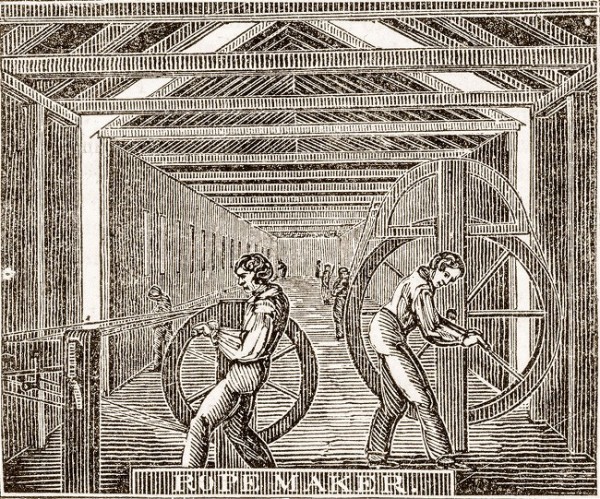
Facility of the Rope Maker, in Edward Hazen, The Panorama of Professions and Trades (Philadelphia: U. Hunt, 1839), p. 56. (Courtesy, Winterthur Library, Printed Book and Periodical Collection.)
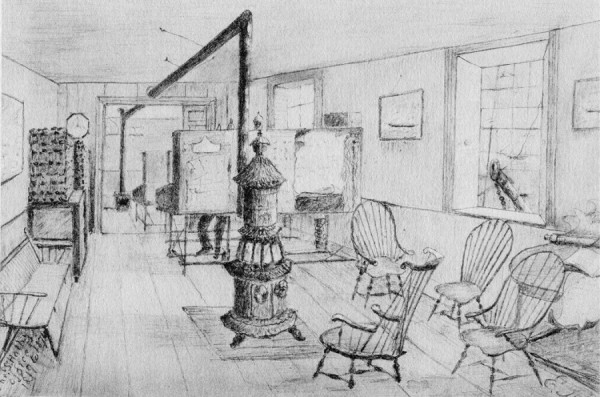
Office of Humphrey Hathaway, at the Head of Rotch’s Wharf, New Bedford, Massachusetts, ca. 1873, depicting a scene of 1819 or later. Pencil sketch on paper by Edward S. Russell. From Horatio Hathaway, A New Bedford Merchant (Boston: Merrymount Press, 1930). (Courtesy, New Bedford Whaling Museum, Estate of Thomas S. Hathaway.) This counting room adjacent to the wharves probably was typical of a moderate to large coastal facility of the early nineteenth century. The two long desks with their bookcases and slanted writing surfaces could accommodate two or three clerks each. By the late eighteenth century iron stoves had replaced the hearth as the heat source. Here, the forward area of the room with its Windsor seating, maps, and a telescope provided a convenient place for sea captains, clients, and others to meet and acquire news about markets, shipping conditions, and related subjects.
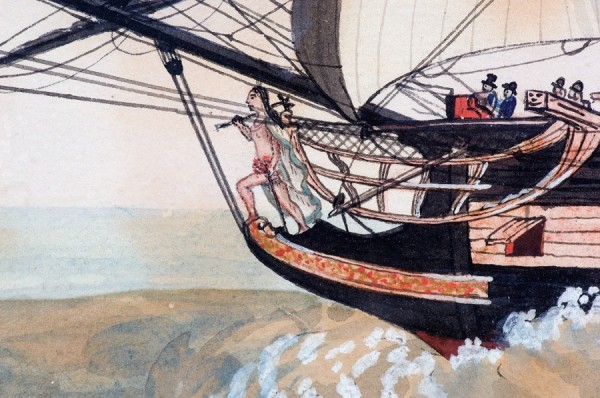
Joseph Howard (1780–1857), detail of bow of the frigate U.S.S. Essex, Salem, Massachusetts, after 1799. Gouache and watercolor on paper. Overall H. 19 3/4", W. 27 3/4". (Courtesy, Peabody Essex Museum, gift of John P. Howard, 1888, acc. M167.) Displayed in this detail are several carved and painted features that customarily were part of the overall design of a large vessel: a figurehead, here in the unusual form of a Native American, and whose left leg is bent at the knee in a “walking attitude”; a trail board, one of a pair, mounted on the sides of a vessel below the figurehead and extending the full or partial length of the vessel; a catface, a whimsical depiction of the facial features of a wild cat on either blunt end of a cathead.
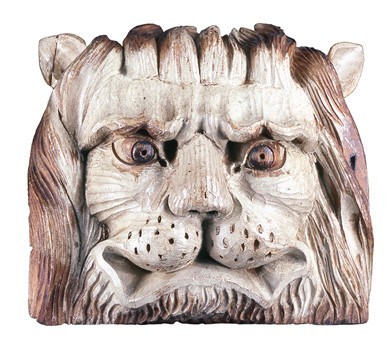
John H. Bellamy (1836–1914), carved lion’s head made as a catface for one end of a cathead, Portsmouth, New Hampshire, 1859. Pine. H. 13", W. 14". (Courtesy, Old Sturbridge Village.) A note pasted on the back of the image reads: “This piece was carved by John H. Bellamy, at 77 Daniel Street, January 1859.”
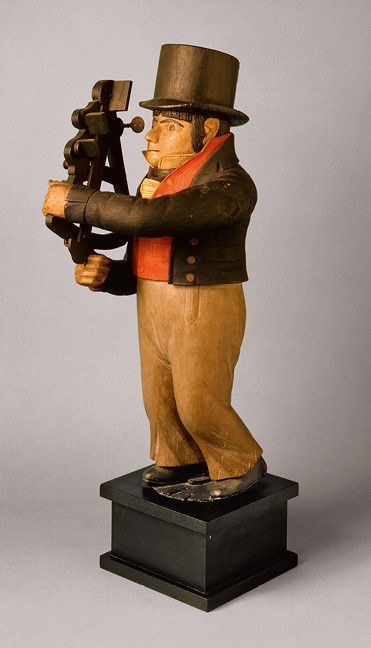
Samuel King (1749–1820), Little Navigator, Newport, Rhode Island, ca. 1810. Carved and polychromed wood shop sign. H. 24". The sign hung over the shop door of James Fales, nautical instrument maker of Newport and later over the shop of James Fales Jr. of New Bedford, Massachusetts, ca. 1830–1880. (Courtesy, New Bedford Whaling Museum.)
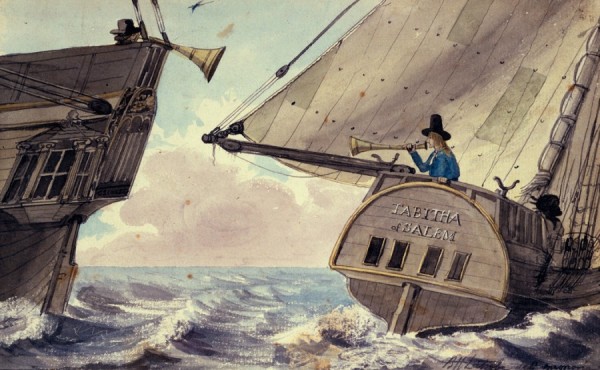
Benjamin Henry Latrobe (1764–1820), A Conversation at Sea, Virginia or Philadelphia, March 10, 1797. Watercolor on paper. (Courtesy, Maryland Center for History and Culture.) When two vessels met at sea, the use of speaking trumpets permitted the exchange of news and information.

Ship Montesquieu off the Harbor of Macao, anonymous, Philadelphia, 1812. Oil on canvas mounted on wood. H. 20 3/4", W. 27". (Courtesy, Girard College History Collections, Philadelphia, Pa., acc. 0063.) This ship was one of a variety of vessels owned by Stephen Girard (1755–1831); the figurehead of the ship was carved by William Rush (1756–1833).
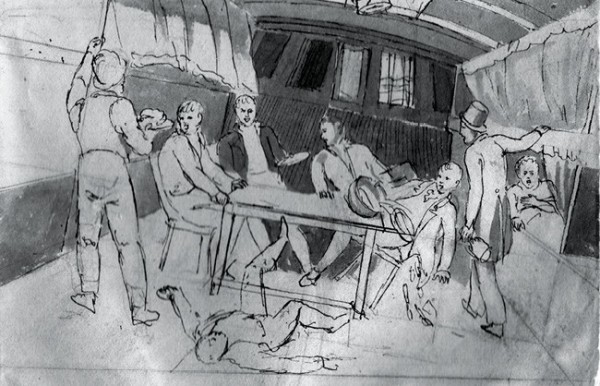
John Lewis Krimmel (1786–1821), Cabin of a Sailing Vessel, Philadelphia, Pennsylvania, 1812–1813. Ink, ink wash, and pencil on paper. H. 4 3/8", W. 6 1/4". From Krimmel, Sketchbook 2, 1812–1813, p. 11. (Courtesy, Winterthur Library, Joseph Downs Collection of Manuscripts and Printed Ephemera.) The water through which the vessel is sailing has become rough, and it is playing havoc with activity in the cabin.
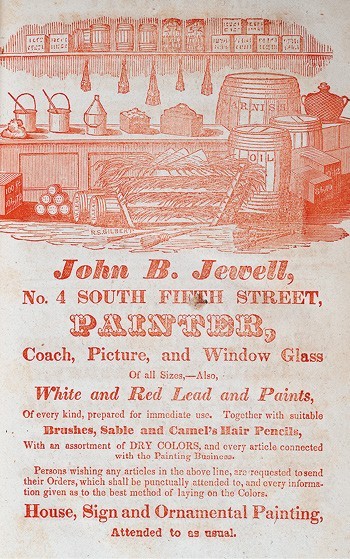
John B. Jewel, advertisement. From Desilver’s Philadelphia Directory and Stranger’s Guide for 1837 (Philadelphia: Robert Desilver, 1837), n.p. (Courtesy, Winterthur Library, Printed Book and Periodical Collection.)
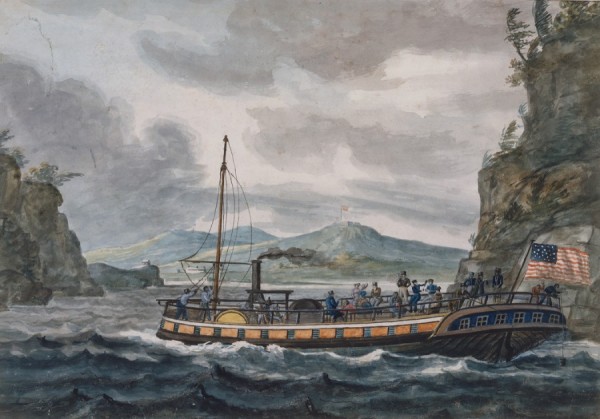
John Lewis Krimmel, Steamboat Travel on the Hudson River, Philadelphia, Pennsylvania, 1812–13. Watercolor and gouache on white wove paper. H. 10", W. 14 1/2". (Courtesy, Metropolitan Museum of Art, Rogers Fund, 1942, acc. 42.95.7; Art Resource, New York.) While traveling in America from 1811 to 1813, Paul Petrovich Svinin (1787/88–1839) assembled a portfolio of 52 watercolor views of North America, some purchased from Krimmel, including this view of an early steamboat. Carried back to Russia, the portfolio eventually came into the possession of an American following the tumult of the Russian Revolution. By 1930 the portfolio was in the possession of R. T. Haines Halsey, from whom in time it was transferred to the Metropolitan Museum of Art, where Halsey was founder of the American Wing. See also Anneliese Harding, John Lewis Krimmel: Genre Artist of the Early Republic (Winterthur, Del.: Winterthur Publications, 1994), pp. 238–49.
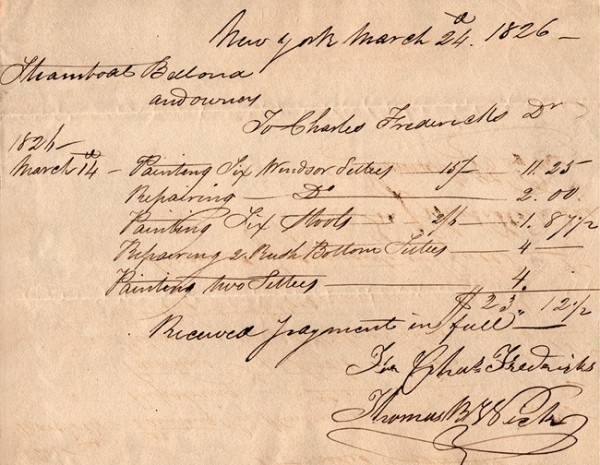
Charles Fredericks, bill to steamboat Bellona, New York, March 14, 1826. (Courtesy, Winterthur Library, Joseph Downs Collection of Manuscripts and Printed Ephemera.)
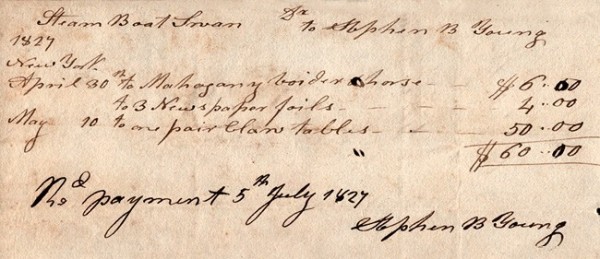
Stephen B. Young, bill to steamboat Swan, New York, April 30–May 10, 1827. (Courtesy, Winterthur Library, Joseph Downs Collection of Manuscripts and Printed Ephemera.)
THIS STUDY IS BASED ON a large body of written material providing insight into the myriad jobs performed by cabinetmakers, carpenters, painters, and allied artisans to meet the needs of fellow craftsmen, retail businesses, the professions, merchants, and the maritime community during a period of growth, expansion, and technological change in America. Location frequently played a part in a woodworker’s success, whether in a rural or an urban environment. The rural craftsman frequently possessed a homestead and farmed his land to help support his family. His land might supply timber used in his trade or as barter in supplement to foodstuffs and other commodities. Frequently his customer base was limited, however, and his distribution area relatively modest. Handyman skills could broaden his income. The urban craftsman had other opportunities and faced somewhat different circumstances. His customer pool often was larger, and in a coastal area it often extended to the maritime community. He frequently lived and worked in rented space without sufficient ground to make a garden, acquiring foodstuffs to feed his family by purchase, sometimes by barter. To pursue his trade, he purchased wood from a local board yard or independent supplier and other materials from specialty shops. Competition frequently was keen, and it increased markedly during the early nineteenth century.
Identifying the Business Site
Integral to establishing a new business was the need to acquaint potential customers with its location. This could be achieved by word of mouth in a small community. In a large urban area, however, even a published notice might not suffice. Jacques-Pierre Brissot de Warville described a common problem when visiting Philadelphia in 1788: “the streets are not inscribed and the doors not numbered.” A business newcomer of modest means might identify his location relative to an established business, public building, or the residence of a prominent individual. Many owners identified their place of business with a sign. Early signs frequently were suspended from the facade of the business structure; later signs usually were installedflat against the front of the building.[1]
The common material of the sign was a wooden board, frequently fitted with a plain or decorative framework. A white pine board was the common choice in New England; yellow (tulip) poplar was more prevalent in the Middle Atlantic region and parts of the South. Secondary woods in the framing might include ash, oak, chestnut, or maple. Signs of the late colonial and early federal periods often were of vertical rectangular form, many with a pediment at the top and a shaped skirt at the bottom (fig. 1). Somewhat less common was the horizontal rectangular sign; oval or shield-shape signs were rarer choices. In 1812 William Chappel of Danbury, Connecticut, made special note when he produced an “Ovil sign” for a customer. Relatively uncommon until the early nineteenth century was “painting a sign on tin,” a job recorded in 1816 by Allen Holcomb of New Lisbon, New York, for Dr. Walter Wing. By the early nineteenth century the broad distribution of large sheets of tinned iron made this option possible.[2]
Business signs of the late colonial and early federal periods frequently were pictorial. Aside from the occasional name or business of the proprietor, lettering was minimal, since literacy was not universal. The pictorial subject of the sign usually identified the nature of the business. For instance, in 1751 at Philadelphia the sign of the “Tent” identified the shop of Thomas Lawrence, an upholsterer on Second Street, who supplied both household furnishings and military equipment. Ironmonger Peter T. Curtenius of New York chose a “Golden Anvil and Hammer”; elsewhere in the city baker William Mucklevain displayed a sign depicting “Three Biskets.” An unusual request by Truman and Company, apothecaries of Providence, Rhode Island, was recorded by William Allen, a local painter and gilder. After “Painting a Sign board” in May 1785, Allen also painted “an Owl to stand on ditto.” The complete job cost the proprietors 24s. ($4.00 in later decimal currency). In the following decade Boston painters Daniel Rea Jr. and George Davidson had calls to paint signs identifying a variety of trades (fig. 2). Simon Hall visited Rea in July 1791 for a job described as “painting a Beauro . . . mehogony and Writ’g S. Hall, Cabinet maker on the Sides,” indicating the sign was a board for hanging, the printed letters and image visible from either side, a common practice. William Williams engaged Davidson several years later to paint his “Sine hat Boxes and a Wooden Hatt.” The wooden hat appears to have been three-dimensional and was either fixed to the top of the signboard or suspended from the bottom. The cost at £5.2.0 ($17.00 in decimal currency) was relatively substantial. Windsor chair maker Reuben Sanborn also engaged Davidson to prepare his sign featuring a “gold chair.” The cost at £5.8.0 ($18.00 in decimal currency) identified work executed in gold leaf, probably on two sides of a suspended board rather than as a three‑dimensional object. Sanborn’s business site at this date (1799) was Doane’s Wharf, a location where he could easily participate in the export trade in vernacular chairs.[3]
Pictorial symbols painted on hanging boards and the occasional suspended three-dimensional object continued in use for business signs into the early nineteenth century. Thomas Boynton of Windsor, Vermont, painted and gilded a sign for silversmiths Johonnot and Smith in September 1815 and then made a “label” lettered “Walk In.” The partners called on Boynton again in December, paying $6.00 for a job of “painting and gilding a watch for a Sign” (fig. 3). A popular insignia of the barber’s trade was the white-painted pole spirally ornamented with a red band, the red color describing the earlier historical role of barbers as surgeons and bloodletters. Samuel and Daniel Proud of Providence, Rhode Island, recorded “making a Barber Pole” for Phillip Lewis, and a pole valued at $1.50 was in the 1832 estate of William Taylor, a barber of Boston. Pifer Washington Case of Johnstown, New York, had occasion to paint a barber pole for a customer several years later. Whereas cylindrical barber poles were shaped on a turning lathe, George Ritter, a cabinetmaker of Philadelphia, used hewing and shaping tools to fashion a large boot in 1835 for Levick and Jenkins, shoe dealers. The boot, made of yellow poplar, is described as “2 feet 3 [inches] long, the foot 18 inches long . . . 8 in[ches] thick.” The job would have required one or two sizable pieces of timber. Given its dimensions, the boot probably functioned as an outdoor sign rather than as an indoor feature. It may have hung suspended from the second story or been fixed on a ledge above the entrance. By this dateflat, lettered signs fastened to the business facade had become common advertising pieces, and street names and numbered buildings were common in communities of reasonable size.[4]
Following the War of 1812 use of signage fixed to a building facade, and sometimes along a side, increased measurably as trade began to grow andflourish (fig. 4). Nevertheless, the hanging sign still remained a choice in some locations for several decades. As late as 1820, when William Wood Thackara visited the small community of Tisbury, Massachusetts, on Martha’s Vineyard, he remarked that the “sign boards over the shop doors hang out as ostentatiously as though the place contained many thousand inhabitants.”[5]
Most fixed signs were wider than their depth, the size determined by the message. A sign made by Timothy Gladding for Peter Gansevoort in 1831 at Albany, New York, for a charge of $1.25 was of modest length and contained the client’s name and occupation: “Examiner in Chancery.” Requiring more extensive work was a sign constructed at Philadelphia in 1828 by George Ritter for John Jordan, a grocer (see fig. 2). The job, which cost $4.00, was described as “a sign Board 8 feet 3 inches Long [wide] by 18 inches wide [tall] with Walnut Doughftails in Back side & two mouldings on the edge.” The dovetails were dovetail keys inserted across the narrow dimension of the wood in shallow slots to strengthen the board and control warping. The moldings on the edges addressed the same issues besides adding a decorative element. Ritter later made a small sign with “moulded edges” for Dr. George F. Alberti. The “4 rose blocks for sine board” turned in the shop of Thomas J. Moyers and Fleming K. Rich at Wythe Court House, Virginia, in January 1838 at a cost of fifty cents were either for the four corners of new work or to refurbish an older sign. The actual surface pattern of the “rose” is unknown, although the modest cost and production method suggest a simple design, likely of concentric circles rather than carved petals.[6]
Once a proper board for a sign was in hand, decoration began with a “priming” coat of paint to cover any irregularities in the wood, followed by one or two coats of the desired ground color. A simple painted border could serve to frame the lettering and any images on the signboard. Although most grounds were plain, there were ornamental options. Grounds could be enhanced with smalt, a pigment made principally of finely pulverized cobalt blue glass strewed “on any ground of oil-paint while wet, where it makes a bright warm blue shining surface.” George Rutter, a painter of Philadelphia, advertised in 1791 “Signs done with the best Strewing Smaltz.” Frédéric Louis Moreau de Saint-Méry, a temporary resident of Philadelphia in the mid-1790s, commented on the city’s artisans “who make a specialty of painting remarkably beautiful signboards with backgrounds of different colors, speckled with gold or silver.” While in Philadelphia, Moreau de St. Méry opened a printing, stationery, and bookshop at the corner of First and Walnut Streets and commissioned a signboard in English and French.[7]
Most signs were printed with serif letters (see figs. 1, 2, and 4); a few employed cursive lettering that resembled handwriting. Lettering was executed in plain paint contrasting in color with the ground, or in gilt. The charge for the work frequently was calculated by the number of letters. In two separate transactions, William Gray of Salem, Massachusetts, charged 2d. per painted letter and 9d. per gold letter, although prices for both types of work were variable, based on letter size. “Shading,” recorded in Vermont by Thomas Boynton, made letters bolder by creating a sense of depth achieved by bordering parts of the letters with a contrasting color (see fig. 36). On occasion a finished sign was priced by the foot, as occurred in 1837 when William Wilson of Lowell, Massachusetts, charged 3s. per foot for a twenty-four-foot sign. John Doggett of Roxbury, Massachusetts, upon completing a job of gilding a sign, appears to have priced his work by the number of gold leaves or books that were used. His bill of $5.50 to Captain Jesse Doggett in 1808 for gilding his tavern sign, the “Ball and Pin” (skittle), was based on the five and one half books of gold leaf the job required (fig. 5). Doggett’s tavern may have been accompanied by sufficient exterior grounds to accommodate the game of ninepins in fair weather.[8]
Little is written about the application of a protective varnish coat to a sign once painting and gilding (if present) were complete. Sparse evidence still remains on some preserved signs, although the practice probably was more common than indicated. The cost was minimal, and it probably was included as part of the cost of overall decorative work. Windsor and fancy seating, except perhaps for the cheapest production, was routinely finished with a coat of “chairmaker’s varnish,” whether plain painted in the eighteenth century or decorated in the early nineteenth century. Varnish protected the chair’s finished surfaces from the wear of use just as a varnish coat could protect an outdoor sign from the abuse of weather. Luke Houghton, a cabinetmaker and chair maker of Barre, Massachusetts, recorded a fifty-cent charge to Kendall and Baker in 1816 for varnishing a sign, probably one already in use and in need of minor refurbishing.[9]
Once a signboard was completed, it required installation. Craft accounts and other records suggest how this was accomplished. Jacob Mordecai, when recalling his youth in pre-revolutionary Philadelphia, described a sign for the fashionable retail shop of George Bartram: “the Golden Fleece, a gilt lamb suspended half way across the pavements in 2d Street near Carter’s Alley.” The support appears to have been a horizontal arm fixed to the building (fig. 6). A similar arrangement was recorded in 1815 by Thomas Boynton at Windsor, Vermont. After supplying Frederick Pettes, innkeeper, with a “Sign Stage House” for $3.00, Boynton added another fifty-cent charge for “painting arm and hanging d[itt]o.” Not identified but part of this work were “the Irons” necessary for hanging the sign. These metal straps with eyelets at the top to engage metal hooks on the arm were fixed to the side edges or the top of the sign (see fig. 1). An alternative method of installation involved a freestanding post with or without an arm at the top (see fig. 7). An early record is Joseph Bolton’s work in 1762 of hanging a sign from a post in front of the shop of Stephen Collins, an up-and-coming storekeeper/merchant in Philadelphia. Later, in 1789, Gershom Jones, a pewterer of Providence, Rhode Island, hired Job Danforth Sr. to make a signpost and install his sign.[10]
Two methods of preparing posts are indicated in records. Paul Jenkins of Kennebunk, Maine, recorded hewing a signpost, whereas Moses Parkhurst of Paxton, Massachusetts, described “turning sign posts.” An indication of the time required to prepare some signposts is noted in the accounts of William Fifield of Lyme, New Hampshire, when in 1821 he recorded “1 Day work on Sign post.” Installation of a long,flat sign to be mountedflush against a building was a different challenge. After William Wilson made a ten-foot sign for customer W. C. Burrows at Lowell, Massachusetts, in 1837, he used a “Crain” to help secure it in place. At this date the crane would have been a human-powered hoisting device. Not all signs were as professional as those described. John Bernard, a Briton traveling in the Carolinas about 1800, commented on the common rural ordinary (tavern): “You might always know an ordinary, on emerging from the woods, by an earthen jug suspended by the handle from a pole . . . or a score of black hogs luxuriating in the sunshine and mud before the door” (fig. 7).[11]
Maintenance at the Business Site
Miscellaneous woodworking and related work at the business site was an ongoing call; many jobs were incidental in nature, while others were more extensive. An infrequent request was for “moving” the shop. Of two recorded late eighteenth-century jobs—one in Hartford, the other in Danbury, Connecticut—one required a full day and the other a half day of the craftsman’s time. The modest costs indicate the moves involved transferring shop contents to other facilities rather than physically moving the structures. If the work had represented physical moves of the shops, the craftsmen involved probably would have provided “roolers [rollers] for mooving bildings,” such as those purchased in 1820 by Zachariah Chafee, a mason of Providence, Rhode Island, from Samuel and Daniel Proud (fig. 8). An extensive job of a diVerent type, completed by Thomas Christy at Boston, Massachusetts, in 1782 for Moses Grant, an upholsterer and shopkeeper, involved “putt’g a new front To the shop he improved belonging to his Father.” Outdoor activity by craftsmen in other locations included work on a shop roof and a job that required “three days a Shingling Store” accompanied by “pa[i]nting Coving.” Constructing new or replacement steps at a business site was a recurring request in all areas, from Gloucester, Massachusetts, to Newport, Rhode Island, to Middletown, New Jersey. Some steps were painted; others, apparently, were left in the wood. Henry Wansey, an English visitor to America during the mid-1790s, commented when visiting Philadelphia: “Almost every house of trade has an assent of steps to enter, and a sloping cellar window or door to receive goods” (see figs. 4 and 9).[12]
Two unusual references of mid-eighteenth-century date posed an initial interpretative challenge. A customer at Reading, Massachusetts, requested Peter Emerson to make “Bords for Shop winders [windows],” the cost amounting to a significant £1.5.0 ($4.17 in later decimal currency). Abraham Dennis of Newport, Rhode Island, engaged Job Townsend Jr. for a similar job: “Fixing a Board on his Shop window.” What was the purpose of the boards? Both references became clearer in the early nineteenth‑century accounts of George Ritter of Philadelphia when Abel Wyman, a shoe dealer, engaged the cabinetmaker for “Making, painting & fixing two show Brackets at front door of Store.” Made of pine, these tall, slim boxlike containers with shelves were used to display merchandise similar to that available in the store. A single show box at the front door of a shop is depicted in figure 9, where it is accompanied by a large bowed shop window, describing in its particular character the purpose of the boards for shop windows. Horizontal shelves for displaying merchandise were fixed to the interior woodwork, each shelf positioned at a transom level of the window. In 1791 when working for the local merchant Charles Shoemaker, Philadelphian David Evans described a similar job as “4 Shelves for Store Windows.” Two shelves for displaying footwear are installed at transom level in a large window viewed from inside a shoemaking shop (see fig. 14).[13]
Aside from carpentry, exterior shop and store work called for painting. A substantial job of “painting Shop twice over” for John Munroe of Barnstable, Massachusetts, at a cost of $7.50, probably engaged the painter Nathaniel Holmes the better part of one week (see fig. 2). The work was accompanied by priming a blind, or outside shutter, and “finding paint.” After “grinding green and puting it on,” Holmes continued by painting the door, shop steps, and pump, probably with the same green. Of particular note because of its rare mention is work undertaken by Thomas Boynton in painting and then “Pencilling Store front” for G. W. and C. F. Merrifield, printers at Windsor, Vermont. The principal tool used for this work was a fine-tipped camel’s-hair brush, called a pencil, with which a skilled painter could create decorative work consisting of thin straight or curved lines to emphasize structural features, such as a doorway or window, or create the illusion of paneled features.[14]
A cheap way of brightening outdoor walls or common structures was by using whitewash, a mixture of lime and water. A better quality of work employed Spanish whiting or oyster-shell white mixed with size and water. Frederick K. Coady, a craftsman of upstate Ogdensburg, New York, recorded at least two instances of whitewashing, one at a customer’s store, the other at a shop. Miscellaneous jobs performed by woodworking craftsmen included a variety of incidental tasks. Job E. Townsend installed a lock on the “Store Door” of Phillip Morss (Morse?) in 1788 at Newport, Rhode Island, and William Wilson supplied “1 Door plate” priced at twenty-five cents some years later for the shop and office of A. W. Moulton at Lowell, Massachusetts. The plate may have resembled those advertised in 1791 at Philadelphia: “Japanned Plates for Window Shutters, Doors, &c. elegantly wrote or printed in Gold Letters.”[15]
Interior work at the business site was as varied as exterior work. Grocer Richard P. Foulke of Philadelphia had substantial “Carpenters work” done at his store at the “Corner of filbert street and 8th” in 1822 by Joseph Dives. Record of an exact business address for a customer, as here, is a rarity in craftsmen’s records. Jobs involving windows and doors actually fall into a category of inside-outside work. Richard Blow, a storekeeper and merchant in Norfolk, Virginia, engaged Hatter and Miller in 1783 for a job at the store that included glazing eighty-five lights (window panes), for which the workmen cut sixty-four new panes of glass and supplied the putty (see fig. 2). Similar jobs elsewhere were more modest by comparison. Pease and Fowler of Middletown, Connecticut, engaged Elizur Barnes to set two squares of glass in the shop door. A rowdy youth led Silas E. Cheney, a cabinetmaker of Litchfield, Connecticut, to charge the father twelve cents for “your boy breaking Glass out [of] Shop.” Owners of facilities other than stores and shops also called on skilled artisans for related work. Proprietors of the Levi Shephard and Sons factory at Northampton, Massachusetts, employed Harris Beckwith in 1805 to make “two Window frames and Sashes for the factory.” Two years earlier Beckwith had worked for Job White making “A Door for your Shop” then “Caseing and hanging the same.”[16]
Structural work within the shop accounted for a variety of other jobs. A customer of Job E. Townsend at Newport, Rhode Island, hired him for “Putting up a Pertiation in the Shop.” Another customer requested that he move a partition to another location in the shop. Both jobs were priced in the general range of three dollars, aside from materials, and likely required several days of the craftsman’s time. During the same period (ca. 1800), Townsend also worked at the shop of Edward Stanhope “Cutting a hole for a Stove Pipe.” The dimensions of this type of job were stated in more detail by Job Danforth Sr. at Providence, Rhode Island, when working at the shop of Robert Adam: “cutting holes in thefloor and Roof . . . for your Stove pipe.” During the late eighteenth century, metal stoves rapidly replaced the hearth as the heat source for craft shops and stores. Metal stoves burned fuel more efficiently, were freestanding, and radiated heat in all directions (fig. 10; also see fig. 47). Another job, described by Horace Beckwith of Northampton, Massachusetts, as “two days Work in your Blacksmith Shop Layingfloor,” cost Charles Chapman twelve shillings. The six-shilling wage per day, as indicated, was a good average pay for a skilled craftsman during much of the period under discussion. When the British currency system was replaced with a decimal system in the 1790s, six shillings were equated with one dollar throughout the United States, except for New York, where the figure frequently was eight shillings New York currency.[17]
Interior painting was a recurring need in many places of business. After the extensive glazing work at Richards Blow’s commercial facility in Virginia, Hatton and Miller followed with “painting ye inside of ye Store.” Successful retailers found that their premises required periodic refurbishing, much as proprietors of well frequented inns and taverns needed to remain alert to the maintenance of their properties. During the early 1840s several facilities in the town of Windsor, Vermont, aflourishing and handsome commercial center on the Connecticut River, benefitted from the services of Thomas Boynton. Innkeeper Samuel Patrick hired him to paint the “south room and dining roomfloor in [the] Tavern.” The $4.50 charge was covered in part by an earlier credit for Patrick who had supplied Boynton with “1 Cord of wood, 1/2 Bass wood” and “a turkey for thanksgiving.” A substantial job took Boynton to the Windsor Tavern Company, where he was engaged in a process he termed “Stamp painting” in the “2d & 3d Entry Halls” and the “Dining room and setting room.” This work was followed by “varnishing [the] 2d Hall” and “Varnishing [the] Dining room and reading roomfloors with 3 gall[on]s [of] varnish.” While on the premises, Boynton also lettered and numbered doors, hung bells, and provided a “Sign Windsor House.” The complete job amounted to $68.68. At Ogdensburg, New York, in 1842 Frederick K. Coady painted thefloor twice at G. N. Seymour’s store. An uncommon call earlier the same year found him papering the shop of S. B. Strickland.[18]
Supplying the Specific Needs of Business
The accounts of foreign visitors to America and commentary by residents attest to the substantial variety of trades practiced in the American colonies prior to the Revolutionary War. Following the conflict, corresponding documents describe the rapid expansion and proliferation of craft shops and large and small businesses in concert with the expansion of mercantile activity, both domestic and foreign. This section will focus on the activities cited most frequently in the material gathered for this study—whether pertaining to trades, shops, stores, professions, merchandising, or commerce—to understand better the woodworker’s critical role in supporting and shaping the business community.
Craft Shops
Hatters
Work for hatters, and to a lesser extent for milliners, was a frequent call at the woodworking shop. George G. Channing of Newport, Rhode Island, grandson of William Ellery, a signer of the Declaration of Independence, recalled the early nineteenth-century years of his youth and noted that beaver hats were costly and worn only by a few gentlemen. Continuing, he identified the felt hat made from less costly fur “stiffened with paste and glue” (later with gum shellac) as the common head wear of men and boys. Wind, dampness, and rain took their toll, and under those conditions, owners were required to “block out” the bodies and rims of their hats or they assumed “the most grotesque and forlorn shapes imaginable.”[19]
In June 1773 Samuel Williams, a Philadelphia “joiner” with a board yard on Fourth Street between Market and Chestnut, advertised “4 inch poplar plank for hatters,” describing the material of hat blocks used locally. Purchased individually or by the dozens from woodworkers everywhere, the cylindrical hat block was an essential commodity. Hatters used them in large numbers: blocks to shape the body of the hat; separate blocks for the dyeing process; other blocks for the finishing process. The more than 200 “Colouring Blocks” purchased by hatter William Washburn of Kingston, Massachusetts, between 1824 and 1827 from Nathan Lucas were for use in the dye bath. Two Connecticut woodworkers, Jeduthern Avery and Samuel Durand, specifically identified a “hat block for finishing hats on.” Sales of hat blocks to Thomas Tilestone, a hatter of Windham, Connecticut, by Amos D. Allen identify block size and fabrication methods: “6 Hatblocks sawed 7 In across at the band, 7 ½ at top, 5 In high” and “1 Hatblock made of seasoned stuf glued and Turned 6 ½ Deep, 7 by 7 7/8.” The cost of a hat block ranged from fifteen to fifty cents depending on size, fabrication, use, and other factors. On occasion, alterations were made to hat blocks already in use, as recorded in Maine by Paul Jenkins.[20]
The hatter’s bow, a rod with an attached string, was an essential tool in creating the body of a hat. The bow string, plucked through use of a wooden pin, created vibrations aligning the foundation fibers into a pad. Covered with a damp piece of linen and compressed with a hatter’s basket—aflat piece of woven work—the pad was exposed to moisture and heat and the fibers gradually matted by hand into a felt forming the body of the hat. The hatter then applied the stiffening, which was solidified in a steam box. One or more layers of fur for the nap were prepared in the same manner, following which the nap was raised with a brush or toothed instrument. The hat was then placed in the dye bath, after which it was washed and dried and turned over to a finisher. Figure 11 provides a visual description of the hat-making process. In the right foreground a workman uses a hatter’s bow, while the background shows other workmen shaping mats in hot water baths. The large wheel is the dyeing mechanism fitted with many blocks on which the hats are hung. The wheel, turned with a crank, immerses part of the hats at a time in the dye bath until they are properly colored. Beyond hat blocks, craftsmen supplied several tools of hat making. Samuel Wing of Sandwich and Abner Taylor of Lee, Massachusetts, made hatter’s bows; Taylor also bored blocks for brushes used in raising the nap. The Proud brothers of Providence and Job Townsend Jr. of Newport, Rhode Island, recorded sales of bow pins. At Philadelphia the accounts of Daniel Trotter list sales of hatter’s baskets and bows.[21]
Although bonnet making was a trade that gave employ and even ownership of a business to many women, the craft was dominated by men. Just as wooden hat blocks were critical to fabricating male head wear, shaped wooden blocks for forming the crowns of women’s cloth hats were critical tools of the millinery trade. Buckram, made of hemp or coarse linen stiffened with sizing, was the common choice for the crown. To this was attached pasteboard or buckram edged with wire to form the front part of the hat, according to prevailing fashion. A cloth lining and a finish cover of silk, satin, muslin, or the like, completed the basic work prior to the application of ornament, such as ribbons, lace, artificialflowers, feathers, and other materials (fig. 12). Many women’s hats were made of straw; some were of domestic fabrication, although Leghorn hats imported from the vicinity of Livorno, Italy, were exceedingly popular. Straw for use in hats was cut to length, whitened (bleached), split, and pressed using a simple machine. The splits were braided into plaits, which were then sewed together to form a hat. American merchants imported both finished hats and plaits for domestic assembly.[22]
Documents identify a variety of woodworking shops that supplied tools and materials for the milliner’s trade. Elizur Barnes of Middletown, Connecticut, sold a customer “Bonnet blocks For Daughter” in 1822. The same decade Deborah Chamberlain purchased “2 bunet blocks” directly from Allen Holcomb at New Lisbon, New York. Two craftsmen, George Landon of Erie, Pennsylvania, and John Cate of Wolfeboro, New Hampshire, sold bonnet blocks produced on turning lathes. Accounts of other craftsmen address the woven hat trade. Solomon Cole of Connecticut provided several customers at Glastonbury with “splits” for bonnets. Two accounts identify a machine to process straw splits: Abner Haven of Framingham, Massachusetts, repaired a machine already in use, whereas Elisha Blossom Jr. of New York constructed a “Mill for pressing split straw” priced at $8.00 for Miss Zebiah Richards. The mill likely had rollers operated by a hand crank. Elizur Barnes went a step further in “Fixing a Box for Bleaching Bonets” for Miss Johnson, milliner. Edward Hazen notes in his discussion of the milliner’s trade that “great quantities of straw are . . . plaited in families, especially in the New-England states, and sold to neighboring merchants, who, in turn, dispose of it to those who form it into hats.” The accounts of Abner Taylor of Lee, Massachusetts, may actually reference this cottage industry in an 1812 charge of $1.75 to a customer for “womens work on bonnets.”[23]
Whereas both hatters and milliners sold many hats individually to customers—and occasionally small boxes to store them—a significant part of the hat business was in quantity sales, which required boxes or cases to transport the merchandise to retail facilities. At about thirty cents apiece, individual boxes for women’s hats were cheaper than those for men, which cost approximately fifty cents apiece, probably reflecting the differences in size of the products. Several hat boxes made of chestnut in eastern Connecticut by Perez Austin cost seventy-five cents apiece, although it is possible that each held more than one hat. Reflecting quantity sales, Austin also charged Joseph Simms $2.50 for “Carrin [carrying] Hats to Norwich,” likely for deposit at a retail facility for distribution or with a coastal trader (fig. 13). The dimensions of a large box to hold men’s hats for broad distribution was recorded by George Ritter at Philadelphia in the 1820s: “a Hatt Box 3 feet 8 long by 2 feet 2 high and 2 feet wide having eight divisions to contain 2 doz Hatts.” In the same decade Nathan Cleaveland of Franklin, Massachusetts, made a significant number of bonnet cases, large and small, for Davis Thayer and Company, charging by the box or the time spent making boxes. On one occasion Cleaveland charged fifty-six cents for “half a days work making Bonnet Cases.” A month later he posted a ninety-two-cent charge for “half a days work myself and Apprentice makeing Cases.” If similar conditions are represented, simple arithmetic indicates the apprentice’s time was charged at thirty-six cents per half day. The accounts of William Wilson, a painter at Lowell, shed light on the further accommodation of bonnets. For one customer he varnished, or stained and varnished, more than a dozen bonnet stands (see fig. 12). Another patron requested that he varnish a “Bonnet tree.” Whether the tree furnished a retail facility or a domestic setting, it served its purpose: display or temporary storage.[24]
Shoemakers
Many references to making a “shoemaker’s bench” or a “shoemaker’s seat” appear in woodworkers’ accounts, and comparison of the pricing suggests the terms identify the same equipment. Common pricing varies from 6s. to 7s. 6p. ($1.00 to $1.25), a few prices lower and several higher, including “a Shoemakers seat with a drawer” at 9s. ($1.50) made by Titus Preston of Wallingford, Connecticut, in 1807 for Phineas Pond. Three shoemaker’s seats, each with a drawer, are pictured in figure 14. Boards abutting the shop window display finished footwear, lasts (foot models) are scattered on thefloor or secured in a wall rack, and a songbird in a cage presages piped-in music of a later era. Tools and pieces of leather are scattered about the room. Edward Hazen described the shop activity in general terms: “The materials are cut out and fitted by the foreman, or by the person who carries on the business [right], whilst the pieces are stitched together and the work finished by workmen who sit upon the bench.” Insight into the preparation of the wooden lasts is recorded by David Pritchard of Wallingford, Connecticut, relative to customer James Harrison: “for the use of my Shop in part to Turn Lasts three weeks.”[25]
In making a boot or shoe of leather, the parts forming the “uppers,” precut to size, were stitched together and attached to a sole, which approximated the length and width of the customer’s foot. Inner and outer soles were attached by sewing and nailing. The workman at left is preparing a leather outer sole on a smooth stone known as a lapstone, which is balanced on his lap. Using the broad face of the shoemaker’s hammer, the leather sole is condensed and made more durable by pounding it. Either this workman or the workman facing him would have presoaked the leather they are working in the stave-formed bucket in the foreground. The workman at center left holds an awl in his right hand to punch holes in a sole to accommodate stitching. The third benchman, his back to the viewer, has shoe thread wrapped around one hand and holds a sewing “needle” fashioned from a hog’s bristle in the other hand. Common shoe thread was made from waxedflax; a stronger variety was made of hemp. The work at hand was placed between the craftsman’s knees and held fast using a shoemaker’s stirrup, a leather loop placed around the work and one knee and held taut by the foot. The benchmen at the right and center use stirrups. A quicker alternative method of fastening soles and uppers of shoes and boots employed wooden pegs, although footwear made by this system was not as durable or as easy to repair. Philip Deland, a woodworker of West Brookfield, Massachusetts, furnished “one peg bench with a drawer &c.” at $3.00 to a shoemaking customer in 1829 along with “one pegsett first rate” at thirty-four cents and a “doubble peg sett.” Deland supplied another shoemaking customer with six awl helves (handles). In Rhode Island Job E. Townsend charged 2s. 3d. (37 1/2¢) for “a Mallet for Pounding Leather.” Useful to the trade were “Boot Trees” for preserving boot shape, which Lemuel Tobey sold to a customer at Dartmouth, Massachusetts (see fig. 14, near right wall) along with a “Sho[e]makers Bench.” A “small Candle stick for shoemaker” made by Robert Whitelaw of Ryegate, Vermont, was useful in winter, when craftsmen of many trades frequently were at the bench before sunrise or after sunset.[26]
The accounts of Wait Stoddard, tanner, currier, and cordwainer (shoemaker), of Windham, Connecticut, with Amos D. Allen, cabinetmaker and chair maker, provide insight into the business of supplying a family with new footwear during a three-year period. A pair of “Calf skin Shoes” bought by Allen for himself at 10s. ($1.67) in January 1800 is described more completely in a later ten-shilling purchase: “1 pair Calf skin Shoes Lin[e]d and bound.” The binding was a thin strip of leather sewed around the top edge. A pair of “Womans Shoes” listed at 7s. ($1.17) may have been fabricated of prunella, a “twilled, worsted cloth” popular for women’s footwear, although the soles were made of leather. Slippers also are listed, one entry describing “4 pair of green slips” at 3s. 6d. (58¢). These may resemble the footwear of the workers seated on the benches in figure 14. Other entries address repairs: “new topping pair [of] boots” or “Soalling pair boots.” If an entire new sole or heel was not required, a piece of leather know as a tap might be used to renew a worn heel or sole. Stoddard supplied Allen with leather for other purposes: calf, morocco, lamb and sheep skins, and “1 Side harness leather” weighing ten pounds. Allen repaid Stoddard for services and materials with a variety of barter goods: bushels of grain, a silver watch, furniture and furniture repairs, and use of his wagon. In the early nineteenth century several communities became shoe manufacturing centers, supplying in part the export market, including Lynn, Massachusetts, where “scarcely a house . . . is not inhabited by a shoemaker,” and Newark, New Jersey, where one manufacturer employed from 300 to 400 workmen.[27]
Other Crafts
References to the interactions between woodworkers and other members of the craft community in the material at hand are scattered, although they document the nature of those contacts. Most common are references to individuals in the metal-working trades. George Ritter of Philadelphia repaired “a T-square” in 1837 for the journeyman of Nicholas Kohlencamp, a tinsmith. Several references focus on iron processing. In 1790 Job Danforth Sr. of Providence, Rhode Island, billed Amos Throop for “work Done on y[ou]r black smiths shop.” Danforth returned three years later for a job of “diging and puting a pipe to [the] water works,” identifying the power source used to operate the bellows in Throop’s forge. Water, apparently, was the power that operated the large trip hammer that William Fifield serviced two decades later at James Proctor’s iron works at Lyme, New Hampshire, a town watered by three streams that empty into the Connecticut River. At Atsion Furnace in the pine barrens of central New Jersey, work often focused on patterns for stoves and chimney backs. Two Philadelphia craftsmen, John Folwell in the 1770s and Daniel Trotter in the 1780s, supplied some of the “molds” necessary for casting. Trotter also furnished patterns for sash weights and andirons.[28]
The button, a fastener for clothing, was an item of popular request. Crafted from many materials—base or precious metal, bone, mother-of-pearl, glass, wood—the button represented a basic convenience or a fashion statement. Merchants imported quantities of buttons, and by 1798 Timothy Dwight, president of Yale College and commentator on New England society of the early republic, noted a substantial manufacture of “gilt buttons” in the town of Waterbury, Connecticut. Before the widespread availability of manufactured buttons, however, inexpensive turned wooden button molds were in the market. Ranging in price from slightly more than 1d. to 3d. (1 1/2–4¢), these disks were covered with cloth appropriate to their use. A notice for a runaway “Irish Servant Man” in the New York Weekly Journal of March 22, 1742, describes the clothes worn by the absconder: “a Felt Hat, a blue drab jacket, an outside Jacket black and white homespun drugget [a coarse common cloth] shorter than the blue one, Buttons covered with the same.” Thomas Pratt of Malden, Massachusetts, sold “fifteen buttonmolds” to a customer in the following decade for one pence apiece, but that quantity was eclipsed some years later by purchases made at Ipswich by Benjamin Ross, who likely was a tailor. From 1781 to 1783 Ross acquired 237 dozen molds at two pence per mold and thirty-four and one half dozen at three pence. He also purchased a “but[to]n hole board,” probably a gauge to size buttonholes to buttons.[29]
Craft and Profession
Barbers and Dentists
Specialized seating for barbers and dentists was uncommon until the early nineteenth century. Prior to that time chairs with tall backs to support the head were pressed into service when needed. “Elbows” to support the arms, although convenient, were not necessarily present. As dedicated chairs came onto the market, an adjustable headrest became a feature (fig. 15). Some chairs also had legs of extra length. George Landon, a cabinetmaker of Erie, Pennsylvania, sold a “Barber Chair” in August 1821 to a customer for $2.50. The cost included the 62 1/2¢ Landon credited to another individual in that month for “irons for [back of] barber chair.” Shaving customers was as important a function of the barber as was cutting and dressing hair. Smith and Lippins, black barbers at 365 Broad Street in Newark, New Jersey, near David Alling’s chair manufactory, placed an order with Alling in 1837 for a barber chair, four Windsor chairs, and two low stools to furnish or expand the seating at their place of business. A low stool could support a customer’s feet when “in the chair.” Another customer ordered a caned curled-maple barber’s chair and a “morocco” seat cushion en suite. One focus of George Ritter’s cabinetmaking business at 72 North Fourth Street, Philadelphia, a few years earlier was chairs for dentists. McElheney and Van Pelt purchased “a Dentists portable mah[ogan]y chair with fall Back hung with quadrants, & [a] circular Screw seat” at $15.00. The seat was similar to a piano stool, and the quadrants were quarter-circle metal hinges for adjusting the chair back. A related “mahagany Dentists operating chair” made for another customer for $25.00 had a “screw circular seat stuffed with curled hair & covered with black hair cloth.” Samuel C. Bunting, a merchant on Third Street, placed an unusual order for a mahogany dentist’s chair with quadrants and revolving seat that stood on a board 3 feet, 5 inches long and was equipped with a “Mah[ogan]y toe board [and] irens underneth” the seat. The chair was not unlike a seat for an invalid without the large wheels. Bunting also requested a packing box, special packing, and portage to his shipping location at 28 South Wharves, where the chair was forwarded to the customer. Shopping in urban areas in this period was accomplished principally on foot. Proximity of location and the high level of Ritter’s skill, as attested in his accounts, attracted Bunting and others to his shop. Whether in an urban setting or a town location, however, a hanging trade sign at a dentist’s door, such as that illustrated in figure 16, could be quite direct.[30]
Physicians and Apothecaries
Prior to the mid-eighteenth century gaining a medical education in America was accomplished by serving an apprenticeship with a practicing physician or surgeon. Medical ranks were strengthened in urban areas by the arrival of individuals trained in the centers of learning in Europe. Gradually the study and practice of medicine in America became systematized, with marked improvement of professional standards. Philadelphia, for example, became a center of medical activity where young men were encouraged to travel abroad to study at the important centers of Edinburgh, London, and, occasionally, Paris. Medical lectures, papers, and research began to be published regularly and disseminated. By 1756 the city’s medical profession realized a long-held goal of opening a hospital to serve the community. There followed in the 1760s the establishment of a medical school at the Pennsylvania Hospital and another at King’s College (later Columbia), New York. Members of the associated craft of apothecary specialized in preparing “different ingredients to form [medicinal] compounds,” and besides serving physicians they could prescribe treatment and distribute remedies to their own clientele. When an area was without an apothecary, local physicians supplied the medicinal needs of patients (fig. 17). Dr. John Brickett, who also was an apothecary, is seen holding a leather-bound copy of Materia Medica, describing the natural and compounded substances used in treating diseases. Colleges of pharmacy were established in Philadelphia and New York during the early nineteenth century.[31]
Nests of drawers, or cases, were common at the business site of both the physician and the apothecary. As early as 1759 Dr. John Newman ordered “a Case with 40 small Draws” for £1.12.0 ($5.33) from a member of the Lunt family at Newbury, Massachusetts. Many decades later, in 1824, Dr. Charles Dyer of Middletown, Connecticut, paid Elizur Barnes $68.00 for “a Case of apothacary in 4 parts—34 Draws in Each, Total 136 Draws at 50 ct” each. Whereas nests of drawers were popular with members of the medical community throughout New England, they also were in use in the Middle Atlantic and other regions. Wilmer Worthington of West Chester, Pennsylvania, probably an apothecary, acquired “A Medacine Case (27 Draws)” in 1826 from Amos Darlington Jr. Upon installation of a case of drawers, the proprietor of a shop arranged to have the contents labeled. Daniel Rea Jr., ornamental painter of Boston, had several calls of note. “Paint[in]g & Lableing” for Dr. William Jackson in 1792 included sixty large drawers and seventy of smaller size. A job for Samuel Miller, an apothecary, included painting, ornamenting, and labeling fifty-seven drawers. Miller also requested Rea to paint, gild, and label thirty-one bottles. Truman and Company was hired by William Allen of Providence, Rhode Island, in 1784 to paint “Specia Bottles,” large containers used for storage. The same year Samuel Blythe painted and gilded two “Canisters,” or small boxes, possibly made of metal, at Boston for Dr. William Sterns. Wooden boxes were particularly useful in the medical business for drugs, pills, salts, and the like. Robert Rantoul, an apothecary and minor merchant of Beverly Massachusetts, engaged Ebenezer Smith Jr. in 1812 to cut “14 lb Quasha wood,” a medicinal bark or wood from Surinam (formerly Dutch Guiana) used to make a tonic. A storage box would have been useful, or perhaps Rantoul had a “pair of large Drawers for Drugs,” as found on the premises of David Eaton in Chester County, Pennsylvania. By the 1840s wholesale druggists were established in commercial centers such as Philadelphia, where J. and J. Reakirt occupied a prominent corner location and displayed a hanging mortar and pestle along with theflat signage on their building (see fig. 4).[32]
When details are unavailable, the medicine chest is distinguished from the medicine case by its price, which centered in the one-dollar range. That was the cost of Dr. Dyers’ chest; his case, with its many drawers, cost $68.00, as indicated. Dr. Burley Smart ordered a “medicen chest with Lock” at Kennebunk, Maine, for $1.00 from Paul Jenkins. A more particular account of a chest describes one made for Dr. Jonathan Easton in 1798 at Newport, Rhode Island, by Job E. Townsend: “To A medeson Chest 20 Inches Long and 14 Inches Wide & 7 Deepe, In the clear [open interior] 12 Partings [partitions].” The 15s. charge ($2.50) reflects the overall size of the case and the extra work of installing the partitions. Dr. Dyer’s patronage of Elizur Barnes extended to the purchase of furniture for his establishment in the form of “a Cherry Show Case” at $6.50. Some physicians placed emphasis on other forms (fig. 18). Dr. John Morris of York, Pennsylvania, used a sturdy paneled cupboard and shelving to support his labeled bottles, large and small, and a long chest with tiers of drawers both for other medical storage and as a support for a distillation apparatus. A “large pine book case with 2 drass [drawers] & painted in Side & out” purchased by Dr. Smart from Paul Jenkins was a form found in other physicians’ offices. The 1838 estate papers of Dr. Jacob Ehrenzeller at West Chester, Pennsylvania, list a “Book case” in the “Office” valued at $10.00 and “Books in Book case” estimated at $50.00, describing a substantial medical library. A desk and portable desk also furnished Dr. Ehrenzeller’s office. Throughout the period of this study, the desk was considered essential equipment for a physician. A “Wrighting Desk & Stool” purchased from David Evans in 1790 at Philadelphia cost Dr. John H. Gibbons £2.12.6 ($8.75). With Evans’s cabinet shop being at 115 Mulberry (Arch) Street, Gibbons office at 103 Mulberry was just a short walk away.[33]
Stores and Shops
The terms store and shop frequently are defined as interchangeable words, each representing a place where goods are kept for sale. Occasionally the store is identified as a shop of large size. The following discussion will focus principally on businesses described as stores in recorded transactions with members of the woodworking community. Shops are included when the nature of their business purchases suggests, or as a directory listing or other information signifies, that substantial retail activity was pursued.
In most cases a moderate retail business is identified when either or both of two types of business furniture is indicated—the counter, such as that in the store of Captain Andrew Johnson (fig. 19), or the showcase. Peter Marselis’s work at New York in 1779 for the firm of Taylor and Bayard involved “making a Dish Counter & Shelves in their Store.” In many cases the counter may have been no more than a sturdy box open at the back, with or without a bottom. That would explain storekeeper William Barrell’s hiring John Hall, a carpenter of Philadelphia, to install a bottom in his counter, or Job E. Townsend’s work for a customer at Newport, Rhode Island, in constructing “a Draw for his Counter in Shop.” George Ritter of Philadelphia made a special drawer accommodation described as a “patent Spring thimble-drawer lock with two Keys for counter drawer,” and at Litchfield, Connecticut, Silas E. Cheney recorded another occasional job as “putting railing to Counter.” Cherry is identified in one instance as the material of the counter, although the variety of finishes described in accounts indicates that cheaper woods were more common for counter construction. Thomas Boynton recorded painting a “Counter mahogony” at Windsor, Vermont. The material of Boynton’s counter may have been white pine, a wood he is known to have used in his shop. Pifer Washington Case of Johnstown, New York, employed “Stain for Counter Tops,” although he also used “graining Color,” as did William Wilson, a painter of Lowell, Massachusetts. Both craftsmen applied a final varnish coat to protect the grained surfaces.[34]
A “Glass show Case” ordered from Philomon Robbins of Hartford, Connecticut, in 1834 by Colton and Williams cost $30.00 for the work. That was a relatively high price, although the showcase form represented a more expensive piece of equipment than the counter. Construction of Robbins’s showcase involved building sections of window sash and incorporating them into the overall design of the case. Providing some insight into the appearance of a showcase is Elizur Barnes’s description of a job undertaken the previous decade for a customer at Middletown, Connecticut: “To a Show Case with Cherry Sash front & top.” After initial construction of the showcase, there still remained the work—and sometimes the expense—of glazing the sash. Accounts suggest that some glazing was carried out by someone other than the builder. For example, Frederick Coady of Ogdensburg, New York, charged Hecock and Curry eighty cents to set “8 Lights in Show Case.” At Newport, Rhode Island, Job E. Townsend recorded “Putting Railing on his Glass Case” for Harvey Sessions. Other tasks mimic those in finishing the counter, such as “Painting a Show Case mehogony Colour” or “Staining,” with varnish as a final coat.[35]
Temporary storage was necessary in stores and shops, and installing drawers and shelves was a convenient way to accommodate some types of merchandise. Following the practice of apothecaries, William Barrell and Christopher Champlin, merchants respectively of Philadelphia and Newport, Rhode Island, installed nests of drawers. In other circumstances larger drawers were more useful. Christopher H. Talcott of Coventry, Connecticut, paid $5.00 to have drawers made for his store, and Elias Redfield of Essex acquired “six draws for shop” at a cost of $4.50. The exact purpose of the drawers is rarely identified. Edward Jenner Carpenter, apprentice cabinetmaker in the Greenfield, Massachusetts, shop of Miles and Lyons, commented in his journal in November 1844 on a job for the store of Dewey and Clark when “making 28 drawers for them to keep their groceries in.” Painting and lettering, or painting and graining, frequently followed drawer installation. For a client’s store in Albany, New York, Ezra Ames, artist and ornamental painter, completed a sizable job in 1796 described as “painting [and] lettering 70 draws” at £1.12.0, “painting & lettering 8 boxes” at 4s., and “lettering 10 barrels” at 5s., for a total cost of 41s. ($5.12 1/2, New York currency). By contrast, the cost of putting shelves in a store or shop frequently was more modest (fig. 20). Day and Pollard, storekeepers of Washington County, Vermont, paid William Ripley $1.00 for installing shelves, a typical cost for many jobs. Specific dimensions are rarely given because shelf length and number varied depending on interior space and the kinds of goods to be shelved. An 1815 account of Silas E. Cheney for Sophia Jones, proprietress of a shop at Litchfield, Connecticut, describes “makeing shelves,” supplying a “Counter,” and “fixeing Draws” all for $5.00. Apart from drawers and shelves, Job E. Townsend assisted customer Harvey Sessions in December 1821 with a “Cloth Roller” at his store in Newport, Rhode Island, by making a “New Exeltree” for the roller. The following August, Townsend was back for a job of “Putting up his Meshene for Rolling Cloth,” probably the same cloth roller assembled and used only periodically when new merchandise arrived. A third call in April 1823 found Townsend mending the “Roling Mesheene frame.”[36]
On occasion one of several case pieces stood in a store or shop to supplement the counter or showcase. Proprietors of stores doing a substantial business would have found a desk convenient (fig. 21). Three woods are mentioned for the desk in the records at hand: locust, cherry, and pine, the cherry desk the most expensive at $10.00. Minor related work included repairing a lock, replacing a desk fall (lid), or supplying a stool to use at the desk. A table could also serve as a desk or as a surface to hold merchandise. A bookcase would have been an appropriate companion to the desk. A “Book Case in ye Shop” made by carpenter Samuel Hall for David Sage at Middletown, Connecticut, in 1788 required “3 Days & half” of labor and consumed “21 feet of Pine Bords” and “80 Brads and Nailes,” with “9d worth of Glue.” Major Nathan Dillingham of Lee, Massachusetts, ordered a “deep Cupboard” for his shop in 1815 from Abner Taylor, likely as a supplement to the “large drawer & cletes” (handles) acquired two years earlier. Incidental seating in stores and shops usually consisted of a few inexpensive chairs or stools, but occasionally there was a notable exception. Amos Bradley of East Haven, Connecticut, supplied Abram and Jared Bradley, owners of a store and packet, with three chairs in 1807 priced at $1.50 each, identifying either Windsor or fancy chairs. Some thirty years later the firm of Smith and Wright, saddle and harness manufacturers at Newark, New Jersey, made an attractive choice in “6 curld [maple] counter stool[s]” purchased from David Alling.[37]
Two unusual countertop items are worthy of note. A purchase made by Benjamin Dyer from Amos D. Allen at Windham, Connecticut, in 1802 at a cost of $4.00 is described as “a Casket for shop counter, door with 12 Panes of glass 6 by 8.” Webster defines a casket as “a small chest or box for items of value.” The casket had a horizontal orientation, and given the number of glass panes and their size, the door consisted of two rows of five panes, the overall length (frame and mullions) being approximately 35 to 45 inches depending on the orientation of the panes. The “door” with lock was hinged to be raised. A similar “glass” casket of substantial size sits atop the counter near the door in the bookstore pictured in figure 22. The second countertop item was more a curiosity then a functional piece, or in the words of Webster “fitted to excite attention.” George Ritter of Philadelphia crafted the object in 1834 for $5.00 to the specification of the customer, a close neighbor identified as Mr. Clark “Bookseller 2d below Arch.” The work involved “Making a Show Book 3 feet long by 2 feet wide & 6 inches thick.” The finished product, in the form of an open book, would have been placed on aflat elevated surface to attract attention somewhere in Mr. Clark’s bookstore. Several items made for other shops assisted in day-to-day activity, including a “Letter box” described in another account as “1 Letter case with glass door.” It was made by Elisha H. Holmes for $2.75 for a shopkeeper at Essex, Connecticut. A free-standing form, probably of larger size, was a “Paper Case with Draws & Doors” priced at £2.5.0 ($7.50), made in 1790 by David Evans for a client in Philadelphia. Incidental items, such as a “Step Lather for Store” made by Evans or “candlesticks for shop” made by Holmes improved efficiency and maximized shop time, particularly in the nine-teenth century when business expanded rapidly in urban centers. During his travels in North America in 1853, William Chambers, a British citizen, noted when visiting Philadelphia “the unexpected splendour of the shops—large stores shewing a long vista of elegant counters, shelving, and glass-cases.”[38]
Countinghouses and Counting Rooms
These terms, in part, describe the business center of the merchant whose occupation was importing merchandise for domestic distribution and exporting goods appropriate for distant markets (fig. 23). The export business was conducted in several ways: directly with another merchant house abroad, through an agent (supercargo), or by the captain of the vessel containing the merchandise to be sold. In large urban centers, individuals dealing exclusively in groceries or specializing in particular foodstuffs, such asflour, frequently rose to the status of merchant in the volume of their business, requiring both specialized furniture and adequate staff. The countinghouse also was the business center of the attorney at law with a substantial practice in transacting legal business for clients before a public court of law and in drawing up individual legal documents, such as wills and deeds (fig. 24). In an economy where coin and paper money were frequently in short supply, particularly in rural areas, the merchant, large retailer, or attorney might find barter an acceptable medium of exchange.[39]
The principal furniture form of the countinghouse was the desk and its accompanying seat. Woodworking craftsmen used several terms to identify this desk; equally popular were countinghouse desk and writing desk. Two terms used much less frequently were high desk and large desk. Records at hand identify the primary wood of construction more than a dozen times within a date range extending mainly from 1784 to 1837. An exception in date is the work of Job Townsend Jr. at Newport, Rhode Island, in building a “Writeing Desk” in 1754 for John Wanton (son of Governor Gideon Wanton), whose account with Townsend was credited with mahogany. Mahogany construction is identified twice again, cherry occurs three times, and walnut and yellow poplar are mentioned once each. The most common material, with five references, is pine, a wood probably also identified in two accounts of Daniel Rea Jr., ornamental painter of Boston, who painted writing desks for a merchant and an attorney during the 1790s, one in mahogany color and the other, with its frame, in green.[40]
Documents provide insight into the appearance of the countinghouse desk through details given for building a single and a double unit. Elisha Blossom, a journeyman cabinetmaker in New York, worked at times for his uncle David Loring, a master cabinetmaker on Beekman Street, where in 1813 Blossom crafted a “Single counting house Desk” and recorded details of the job. The construction material was either pine or whitewood (yellow poplar), wood recorded in Blossom’s dealings with Loring. The “starting” cost at £2 ($5.00, New York currency) identifies a basic frame of unstated length, although probably about 3 feet, 6 inches, the “starting” size in the 1810 New-York Revised Prices for Manufacturing Cabinet and Chair Work. The desk consisted of a rectangular stand with four tall legs connected by stretchers, which supported the writing unit (see fig. 23). To the starting size Blossom added eighteen inches in length. The writing unit, or case, had aflat top at the back to which “1flap,” or sloped writing board, was attached. The center interior of the case was reinforced by a “middle end” (partition), which also provided extra support for the writingflap. Inside the divided case at the back were a total of “8 letter holes” with “8 arches,” or valances, above four small drawers. Mounted on theflat exterior top was a low gallery supported on “14 pillars.” Six screws, the heads “cov[ere]d,” secured the writing box to the stand. The finished surfaces were stained, then polished, and a lock installed. Given its approximate five-foot length and the two interior compartments, the desk would have accommodated two clerks. Blossom’s charge to Loring was £4.15.0 ($11.88, New York currency).[41]
Almost a quarter century later George Ritter of Philadelphia was engaged by William Boller, a merchant located on Front Street adjacent to the shipping wharves, to build a large two-sided countinghouse desk that cost the merchant $25.00 (fig. 25). Ritter subcontracted some of the work to carpenter Isaac Smyth, who made “the Stand for a counting house desk” with turned legs of yellow poplar scantling (see fig. 10). Smyth followed work on the stand with “plaining up the stuff for the desk & assisting in all, say one Day & half.” The “pine” desk “beveled on Both sides” was 5 feet, 8 inches long and five feet in depth. It contained “five Drawers, with locks on the four side drawers.” Two each of the side drawers with locks were located in the desk proper immediately below either beveled writing surface. The overall length and width indicate that the desk could accommodate four clerks, two on each side. The “Top of [the] Desk [was] covered with cloth & edged with a bead.” The frame supporting the desk proper was “secured together with 14 screws.” Use of two woods in the construction of Boller’s desk, yellow poplar and pine, would have been concealed when “Stained & varnished.”[42]
Other references to single and double countinghouse desks occur in records, although the documents lack the details of construction found in the cited examples. More insight is present regarding the placement and appearance of the cloth cover used on desks. Stephen Girard hired Henry Connelly at Philadelphia in 1811 to cover the “Writingflap” of his desk with cloth. The appropriate cloth was identified several years earlier at Providence, Rhode Island, when the firm of Almy and Brown paid a local craftsman to cover its “Writing Table & Desk” with baize, a woolen felted and napped fabric used on writing surfaces. The common color of the baize is described in the inventory of the business premises of John Mifflin, Esq., of Philadelphia, which itemizes “A Counting ho[use] Desk covered w[i]th Green Cloth” (see fig. 26). The same document addresses the subject of a seat to accompany the desk: “a stool & steps belong[in]g to the Desk.” Two separate items appear to be identified, suggesting the stool was exceptionally high or the user was of short stature (see fig. 25). Alternative seating identified by John Eastmond, commission merchant of Albany, New York, describes “1 double Writing desk & benches.” Not all writing desks ordered from craftsmen were for local use. In 1823 Elizur Barnes of Middletown, Connecticut, recorded an order from Josiah Williams and Company for “3 Counting Room Desks,” the total cost $42.00, with another charge of $3.50 for “Boxing 3 Desks.” Middletown’s location on a navigable section of the Connecticut River gave local merchants access to coastal and distant markets. Two Philadelphia customers of David Evans, proprietors of substantial stores in 1791, required specialized furniture. Charles Shoemaker,flour merchant, and Joseph Miller, grocer, ordered desks for their businesses, Miller’s purchase described as “a Large Pine wrighting Desk” for £4.10.0 ($15.00). Both customers and Evans were located within a short walk of each other’s place of business.[43]
Supplemental furniture providing for the smooth functioning of the countinghouse was varied—some forms more essential than others—depending on the circumstances. Countinghouse counters, cupboards, and bookcases constituted the large furniture forms. The countinghouse counter, although uncommon, appears from descriptions to have been particularly useful. William Boller, the Philadelphia merchant who purchased a large double-sided countinghouse desk to accommodate four clerks, also purchased a large twelve-dollar pine counter from George Ritter described as “6 feet long by 2 feet wide [deep] & 3 feet high containing Six Drawers 22 in long by 9 in deep, Stained & Varnished, & containing 120 feet of pine.” For a counter in place in the sizable Vermont store of Isaac Greene, Hezekiah Healy was hired to make “a Change Drawer & fix in a board for shelf.” A corner cupboard of moderate size, judging by the cost at £3.5.0 ($10.83), was built and installed in the store of merchant Richard Blow at Norfolk, Virginia, in 1783 by the partners Hatton and Miller, the craftsmen who had painted the store after extensive window glazing. Continuing their work, the men constructed a “Sq[ua]r[e] Table with 2 Drawers” for £1.14.0 ($5.67). Eight years later the partners Bonner and Lindsey built a “Counter Desk” for the store priced at £1.8.0 ($4.67).[44]
Another purchase made by Richard Blow for his store was a “Writing Desk & Book Case” for £8.16.0 ($29.33). This purchase may have been a combination stand-up writing desk with a series of open bookshelves below for ledgers. In 1789 Ralph Earl painted a portrait of dry goods merchant Elijah Boardman of New Milford, Connecticut, standing at a sturdy model of the suggested type filled with heavy business ledgers (fig. 26). Other bookcases were constructed without a desk unit. Records at hand make no mention of hardwood frames, although they describe several units with painted and stained surfaces. John Codman, a Boston merchant with an office on Codman’s Wharf, hired Daniel Rea Jr. in 1797 to paint his bookcase mahogany color. In that city several decades later Andrew Dunlap, district attorney with an office in the Old Court House, called on John Treadwell to build five bookcases at a cost of $25.00. Treadwell subcontracted the finishing to Eben Jackson, a painter, who following the then current trend grained the bookcases in imitation “Maple & Mahogany 22 yds at 50 cts [per yard] & Varnishing the same,” all at an additional charge of $11.00. Several other bookcases purchased in the 1830s appear to have been of substantial size, judging by the cost. The structure of a “Library Book Case” acquired by Owen Stover, Esq., of West Chester, Pennsylvania, for $18.00 from Amos Darlington Jr. is speculative. It likely was a broad open unit without doors or cupboard. Probably similar, with the addition of a pair of doors, was a “Book Cass for His Offis with Pannald Doors” built for John Cadwalader, Esq., later Judge Cadwalader. William Cragg of Philadelphia fabricated the case and finished it in stain and varnish for $20.00.[45]
Absent from the records at hand dealing with the countinghouse bookcase is any reference to a horizontal rectangular hanging wall case containing multiple vertical partitions for the convenient storage of current business ledgers and journals. Yet these open storage cases are pictured in active use in illustrations of the countinghouse (see figs. 23 and 25). A small bookcase made for a modest 8s. ($1.33) for Isaac Greene, who kept a large store at Windsor, Vermont, may reference this type of bookcase. Another option at first appeared viable. Boston merchant John Codman employed Daniel Rea Jr. in November 1801 and January 1802 to paint a total of six “Book Chests mehogony” color for $5.00. A chest being a box with a lid, that type of storage would appear impractical for account books in daily use. Discovery of a cogent reference in Samuel Eliot Morison’s Maritime History clarified Codman’s purchase. Within a sizeable merchant house, the author describes how clerks might at times delve into the “neat wooden chests that enclosed the records of each particular vessel.”[46]
The well-equipped countinghouse also had a case or other container to hold papers and letters. George Ritter of Philadelphia, whose account-book entries are considerably more comprehensive than the typical business record, noted dimensions for a pair of paper cases he made at $3.00 each for William Boller, merchant, in 1837: “14 inch[s] high by 14 deep & 12 inches wide, each having six pidgeon holes, Stained & varnished.” The dimensions determined the arrangement of the pigeon holes, which were stacked three over three, each opening approximately 3 1/2 inches by 6 1/2 inches, a common size since papers and letters were routinely folded and identified on the outside (see fig. 24). Several other accounts cite cases of pigeon holes, expanding the range in date and number of holes. Nicholas Skull of Philadelphia, surveyor and mapmaker, did business with John Gillingham in March 1750 to the sum of £8.12.6 ($28.75 in later decimal currency), obtaining seven cases with a combined total of 138 pigeon holes, plus two presses (cupboards) to house them. During the 1790s Robert R. Livingston, chancellor of New York State, patronized Thomas Burling and Son in the City, acquiring “a Mohog’y Paper Case of Pigeon Holes” for which he paid £4.10.0 ($11.25, New York currency). On occasion a paper case was fitted with containers. William Wragg, Esq., interacting in 1799 with Nicholas Silberg, cabinetmaker of Charleston, South Carolina, paid him to make “a large liquor case,” subsequently altered to “a paper Case with two inside Boxes.” Some “papers” housed in cases were identified as letters, as indicated in the records of Arthur Bronson, a broker on Wall Street, New York.[47]
Another storage unit found in some countinghouses was a rack. When Arthur Bronson had his letter case repaired, cleaned, and varnished in 1838, his “Check Rack” underwent the same treatment. Other records list racks for letters, a rack for a desk, and a “Book Rack for a Safe,” all priced in a moderate range. To this list is added a “mahogany rack for the seales” ordered in 1828 from George Ritter by attorney William Biddle at his business location on Walnut Street, Philadelphia. Window shades also were a necessity at many places of business, particularly during the summer season, and venetian blinds were popular with the business crowd. John Rea, specialist in upholstery and venetian blind making at Philadelphia, accommodated merchant John Slesman in 1800 by making and hanging “2 Venetian Blinds for [the] Compting house Windows.” As a specialty sideline, city cabinetmaker David Evans also made venetian blinds. Baker and Commeges placed an order in 1800 for “a blind [for] the Circular Window” at their “Compting Room” that cost $10.00 and a blind for the window fronting their store for $9.00. Evans’s business in venetian blinds continued, and in 1808 Simon Gratz and Company purchased three “Mohogony Blinds” for their counting room windows for the substantial sum of £15 ($50.00). The cost reflects the fabrication material, installation, and difficult business times during this period, when President Thomas Jefferson’s Embargo Act was in force, curtailing normal waterborne trade. Not all venetian blinds were made with mahogany slats. Painted slats were just as popular, especially those painted green, the color John Codman directed Daniel Rea Jr. to use when “Paint’g four pair of Venetian shades” for his store at Boston. The two-pound charge describes shades of modest size already in use. Amos Darlington Jr. made an unusual installation described in 1825 as “hanging gate in office” at the business premises of Joseph Peirce, Esq., of West Chester, Pennsylvania (see fig. 25). The fifty-cent charge for the work indicates that the gate was either rehung or was new and obtained from another source. Many counting rooms were not of a size to have a railing enclose the counting-room desk and the clerks who kept the accounts and correspondence of the business. A railing created a space apart from the hustle and bustle of daily activity and general business on the premises.[48]
Other Centers of Business
Banks
In 1781 the Second Continental Congress appointed the wealthy Philadelphia merchant Robert Morris as superintendent of finance. Morris immediately set about controlling waste and unnecessary spending and introducing proper administrative methods. He also recognized the need for financialflexibility and obtained a charter for the Bank of North America. David Evans supplied “Venetian Blinds” for the building almost a decade later, followed by “6 blinds for windows” in 1793 for the Bank of Pennsylvania (fig. 27). Meanwhile, with the move of the national seat of government from New York to Philadelphia, Congress chartered the First Bank of the United States in 1791, and in the same year Evans was contracted to make a “Clock Case Painted & put up in the Directors Room.” Banks were also established in other centers throughout the young and maturing nation. At Roxbury, Massachusetts, Simon Willard engaged John Doggett in 1804 to gild a “clock case for [the] Boston Bank” at a charge of $28.00. A decade later Silas E. Cheney was hired by Lucius Smith and Company of Litchfield, Connecticut, to make a “large table” for the local bank. More substantial work was carried out for the Exchange Bank on State Street, Hartford, during the 1830s by Philemon Robbins. He installed a mahogany counter top and twenty-two feet of railing and supplied two mahogany desks, the complete job billed at $46.50. The counter may have resembled the substantial specimen that furnished the bank at York, Pennsylvania, earlier in the century (fig. 28). Still other craftsmen undertook varied work for banks during the early nineteenth century. Amos Darlington Jr. of West Chester, Pennsylvania, made a small box and two venetian blinds for a local bank in 1824, followed six years later by two desks, one priced at $6.00 and the other at $12.00. Chairs purchased at the factory of Henry W. Miller in 1830 for the “Central Bank” of Worcester, Massachusetts, for $16.33 indicates they were either Windsor or fancy seating.[49]
Inns
The American inn, a public house of small to moderate size for the lodging of travelers, also included a tavern where food and drink were available. A tavern also functioned as an inn, although sometimes it was no more than a house where liquor was served, with light fare available occasionally. When domestic travelers or visitors from abroad made stops for lodging, they frequently found a mixed bag of accommodations, leading to frequent comment. The Reverend William Bentley of Salem, Massachusetts, during travel in western New England in 1793, stopped at a new house in Bernardston to which he and his party had been referred. The pastor quickly pronounced the accommodations “mean,” describing “rooms without partitions, without clean linen, & without knowledge of the persons who slept near us.” Bentley “lodged upon the bed” but “in no sense in it.” British and other European travelers were also keen observers, among them John Lambert, who with traveling companions stopped at an upstate inn at Granville, New York, in 1807, where they “were supplied with an excellent supper.” Following the meal, the party retired upstairs to:
one large room . . . [that] contained above a dozen beds, so that we each had a separate one; a thing not always to be met with at every tavern in the States. But the practice of putting two or three in a bed is now little exercised, except at very indifferent taverns, and they are chiefly confined to the back parts of the country.
The enactment of controls improved conditions. Timothy Dwight, president of Yale College, described regulation of the inns in Connecticut in 1796, where “every innkeeper . . . must be recommended by the selectmen and civil authority . . . of the town in which he resides and then licensed at the discretion of the court of common pleas.”[50]
Still, conditions were far from optimum in developing regions, as Dwight’s young niece, Margaret Van Horn Dwight, found out in 1810 when traveling from New Haven, Connecticut, to Ohio (fig. 29). The journey was rugged, with poor roads, rain, and snow; it was unpleasant, with poor accommodations in dirty conditions, sometimes sleeping on thefloor. The roads, inns, and taverns were crowded with wagoners who swore and drank excessively. Writing about this period in Ohio’s early development, a later commentator noted that community institutions offered “opportunities for social intercourse” and became a “focal point for cultural development.” The four institutions critical to this development in the “pioneer communities” of the Ohio Valley were “the tavern, the church, the school, and the county court.” The tavern often also served as a stop for the mail coach. In contrast to Miss Dwight’s experience, the duc de La Rochefoucauld Liancourt, when stopping in coastal New England in the mid-1790s in what later became the state of Maine, “was surprised to find the inns so decent and well kept, in a part of the country so remote, and so rarely visited by travellers.” Another Frenchman, the marquis de Chastellux, traveling in America during the previous decade, found on entering an inn at Morristown, New Jersey, “a dining-room adorned with looking glasses and handsome mahogany furniture,” and a table spread for dining. Near the end of his American travels, Chastellux and his party made an unexpected stop at Baron’s tavern in coastal New Hampshire due to heavy rain. They dried themselves “by a good fire, in a very handsome apartment, adorned with good prints” and mahogany furniture.[51]
The size of an inn and the type and variety of its furnishings were dictated by the nature and volume of its business. At Windsor, Vermont, a town of almost 3,000 inhabitants in 1810, patronage was good at Frederick Pettes’s coffee house and inn. The town, which was surrounded by fertile lands that supported sheep and cattle, was a center of trade along the upper Connecticut River. Its citizens were prosperous, and the town was distinguished by its sophisticated architecture. The Pettes inn and coffee house served as a community meeting place for several organizations, including the Masonic Lodge. Because the premises also functioned as a stage house, it was assured a steady stream of patrons. Furnishings appropriate for dining and lodging in the public house were supplied originally in 1801 when the building was erected. By 1813 some refurbishing, repairs, and replacements to the furnishings were required. On October 8 of that year Thomas Boynton, a cabinetmaker newly returned to his native area from Boston, painted a fireboard for Pettes. Still developing his new business in Windsor, Boynton boarded with Pettes from October through December before setting up his own household. Additional work for Pettes followed in 1814 through 1815. Miscellaneous tasks included scraping and varnishing a portable desk, painting four kegs, and mending a light stand and a cricket (low stool). Boynton also constructed a “money draw[er] with a lock” and supplied newly fashionable seating: “6 gilt fancy bamboo chairs” (probably Windsors) at $18.00, “12 rush Bottom elegant” fancy chairs at $72.00, and a “B[oar]d top rocking Chair,” a relatively new form in comfort seating at $3.75.[52]
Documented purchases made from cabinetmaker Silas E. Cheney and an estate inventory describe the furnishings of Grove Catlin’s inn in the town of Litchfield, Connecticut, the seat of Litchfield County. The area was prosperous, with soil well suited for grazing cattle, the land dotted with scenic lakes, and small rivers providing waterpower for nascent manufactures of textiles and iron. The town was the site of a law school “of great respectability” thatflourished there for almost thirty years from its founding in 1784 by the Honorable Tapping Reeve, a judge in the Supreme Court of Connecticut. Both Reeve and Catlin were significant customers of Cheney, and Cheney boarded with Catlin for several months in 1801. Catlin’s interaction with Cheney principally documents furniture maintenance and replacement for an active lodging and dining facility. In June 1809 Catlin purchased new fireboards for two hearths, although whether plain painted or ornamented is unknown. They do not appear in Catlin’s inventory of 1829, although they may have been considered part of the building. In 1811 Catlin directed major attention to the inn’s seating furniture, which comprised Windsor and fancy chairs, and he paid for minor repairs to a rocking chair. Fifteen Windsor chairs required new backs at 41 1/2¢ apiece. The repairs were followed by three coats of paint at 25¢ the chair and ornament at 10¢ apiece. Another group of fourteen chairs was repainted and ornamented at the same charges. The following year Catlin purchased one dozen new fancy chairs for the inn: ten side chairs were $2.50 apiece and two armchairs en suite were $3.50 each. In an additional purchase in 1814 Catlin acquired two spitting boxes for $1.50. These were low rectangular wooden boxes filled with sand to accommodate the popular habit among men of chewing tobacco. Catlin died in 1829; Cheney predeceased him in 1821 at about age forty-five. Listed in Catlin’s estate inventory are seventy-two chairs and two settees along with “10 sand boxes.” Lodgers and innkeeper were accommodated for sleeping by “5 high Post Bedsteads” and “10 Common d[itt]o.” A brief selection of other listed items speaks to the sophistication of the inn: “16 Bed Valances” $12.00; “17 Calico Window Curtains” (printed cotton) $4.25; “1 Good Looking Glass” $6.00; “14 Common d[itt]o” $10.50; “6 Common Cherry Dining Tables” $13.50; “3 Ditto Tea Tables” $5.25; and “1 Mahogany Tea Table” $10.00.[53]
During a summer visit to New York in 1794, Henry Wansey, a British traveler, observed that the new Tontine Coffee House was modeled after London prototypes. The “handsome large brick building” at the corner of Wall and Water Streets (fig. 30, left) was entered through a raised portico. Inside, “a large public room” functioned as “the Stock Exchange of New York, where all bargains are made.” Records were kept of ship arrivals and clearances “as at Lloyds” of London. Financed by shares, the “house was built for the accommodation of the merchants.” Lodging was available with boarding “at a common table” for “ten shillings currency a day.” Stores on the premises, although not visible from the street as in London, were available for rent. Fabricating the house furniture engaged a number of woodworking craftsmen residing in lower Manhattan in the vicinity of the new structure, although many items are not particularized. Craftsmen Peter Shackerly, Gifford and Scotland, and Nicholas Carmer provided furniture specifically identified as mahogany in the amount of £173 ($432.50, New York currency). Samuel Richards itemized his production as “1 writing Desk, 1 Table, & F[urniture] Brackets” plus “Venetian Blinds,” the latter charged at £40 ($100.00). Clock and watchmaker Effingham Embree produced a timepiece billed at £16 ($40.00). Upholsterer John Brower submitted two bills totaling £98.13.0 ($246.63), presumably for work independent of finish covers for the above mahogany furniture. Looking glasses and chandeliers were provided by William Wilmerding from his store on Maiden Lane at a charge of £98.18.0 ($247.25). Longtime proprietors of a chair-making shop on John Street, Thomas and William Ash, submitted two bills together amounting to £87.4.0 ($218.00), presumably for Windsor seating since fancy chairs were still uncommon and Windsors were the practical choice for lodging and dining areas. Outside the building all was hustle and bustle, with drays parked in all directions and the tall masts of vessels along the East River visible in the immediate distance. Traveling to New York in 1801, Thomas P. Cope, a Philadelphia Quaker businessman, commented: “there are no houses in N. York which answer to the Inns in Philad. for the accommodation of travellers, excepting the Tontine Coffee House may be ranked as of that class.”[54]
Construction of the Sun Inn in the Moravian community of Bethlehem, Pennsylvania, began in 1758, and it was sufficiently complete to receive travelers in autumn 1760. The central-hall building consisted of a basement and threefloors above ground (fig. 31). The firstfloor contained a large common room, the innkeeper’s quarters, a large kitchen and adjacent pantry, and a three-room apartment consisting of a sitting room and two bedrooms. The secondfloor contained three similar apartments surrounding a large hall (room) for dining. The attic story, divided into four sleeping rooms each accommodating four bedsteads, was lighted, in part, by German-style shed-roofed dormers. Rooms throughout the building were heated either by a large hearth or a German-style tile stove. When the inn opened for business, Bethlehem was already on the main travel route between the Carolinas and coastal Massachusetts. The hostelry quickly gained a reputation for its hospitality, excellent management, and cuisine (fig. 32), a reflection of the town’s original communal economy and the continuing oversight of the church. Johann David Schöpf, a German traveler in America in 1783–84, noted that “in addition to transient travelers, Philadelphians are wont to make excursions hither,” to view “the institutions and social arrangements of the congregations” and enjoy “the superior entertainment afforded by this house.” Visitors to the inn in the late eighteenth century included the “great and near-great,” activity being particularly brisk during the Revolutionary War. When the Englishman Isaac Weld visited in 1796, he was lavish in his praise, proclaiming the inn to be the “neatest and best conducted one . . . that I ever met with in any part of America.” Initially £157.1.3 ($523.54) was spent on furniture for the inn. Following Moravian business practice, annual inventories were made in English or German. Furnishings in 1763 included “6 wallnut chairs” and “24 woven seat chairs,” the latter probably of slat-back design, augmented in number and described in 1781 as fifty-one chairs with “woven straw seats.” By 1800 five green armchairs, each valued at 6s. ($1.00), were accompanied by forty-five chairs valued at 5s. 6d. (92¢), the entire group identified in 1805 as Windsor seating. There also were “34 sundrie Chairs part moldit,” describing remnants of previous seating, the “moldit” ones probably joined chairs. Four benches were in the “public Roome,” or first-floor common room. By 1816 Windsor chairs had taken over the inn: two dozen, half described as “new,” were accompanied by eighteen more in the common room, now called the “Great Parlor,” and forty more were scattered about the “Haus.” The “30 Schr[e]iner Stuhle” (cabinetmaker’s chairs) may have furnished the dining hall. There were two specialized seats: a rocking chair and “1 grosse Lähm Stuhl,” or invalid’s chair, valued at $4.50. Other furnishings, purchased at various times into the early nineteenth century, included bedsteads of single and double size, 8-day and 24-hour timepieces, walnut and cherry tables (some folding), a writing desk, two large looking glasses, “a moldit dresser with glass windows” (cabinetmaker’s cupboard with glass doors), and a walnut chest “withflowers” (painted or inlaid ornament).[55]
When Thomas P. Cope visited New York in 1801 and found only the Tontine Coffee House comparable to the inns of Philadelphia, one Philadelphia facility he had in mind was the City Tavern (see fig. 27), near the intersection of Second and Walnut Streets, which like the Tontine served as a merchant’s exchange. Another city landmark of the late eighteenth century was the Indian Queen Inn, or Tavern, on Fourth Street at Chestnut, where Francisco de Miranda, a South American patriot, found excellent accommodations (fig. 33). The Golden Tun Tavern likely would have achieved comparable renown had it not been for the premature death of the innkeeper. Opened in mid-1795 at 59 South Water Street, its proprietor, Samuel Fraunces, was a tavern- and innkeeper of considerable experience. He had emigrated from the West Indies to New York in the 1750s and established an inn eventually known as Fraunce’s Tavern, where he earned a reputation as an excellent steward. General Washington was acquainted with Fraunces long before he bade farewell to his officers at the tavern in 1783, and when the general became president, Fraunces became his household steward. When the national government relocated to Philadelphia in June 1790, Fraunces followed and continued to serve the first family until June 1794, when he returned to inn-keeping. The following midyear Fraunces became proprietor of the Tun Tavern, renamed the Golden Tun. The inn was furnished in style, as attested by the comprehensive inventory of the premises made on October 24, 1795, shortly after Fraunces’s death at age seventy-two on the tenth day of the month.[56]
The item “Golden Tun and sign” describes the identification of the two-story inn: a board bearing the name in printed or cursive letters and the gilded miniature of a tun (a large cask probably used for wine) supported above or suspended below the signboard. Inside the inn, painted structures and furniture, consisting of a bar, seven tables, and five boxes, or wooden stalls, furnished an informal area that probably served as a small coffee house—a popular center for news and conversation in the eighteenth and nineteenth centuries. The three-sided stalls likely had attached side benches (none otherwise mentioned) for seating and structural stability. Each stall was furnished with a painted table; “Green Curtains and rods” completed the scheme to provide privacy, as desired (fig. 34). Facilitating service were four pounds of coffee, a coffeemill, two tin biggins (drip-type coffeeurns), tin coffeepots, and a dozen coffeecups and saucers. Another informal area, located beyond the “entry Cloth 11 1/2 [feet] long” was a “Bar & shelves” stocked with wine glasses, tumblers, decanters, and punch bowls for dispensing the wines, spirits, ales, cider, and mixed drinks of the house. Other public areas on the firstfloor contained mahogany furniture: tables, some in sets of three or five, others described as large or round; two pier tables; two “square” card tables with green baize playing surfaces and “76 packs of Cards”; a large sideboard supporting “2 Knive Cases Cont[ainin]g White handle K[nives] & [Forks]”; and a “Cellaret” sideboard with a central arch to accommodate one of “2 Wine Coolers.” The placement of several other sizable pieces of mahogany furniture is uncertain: a wardrobe, a “desk & drawers,” and a bureau. Seating throughout the inn consisted of a dozen mahogany chairs with “worked” bottoms; six dozen Windsor side chairs, probably used for dining, drinking, and as bedroom furniture; and five rush-bottom chairs servicing the well-equipped kitchen areas. The item “Stair case Carpet & Rods” identifies the presence of the second story, although the inventory has no distinctive order. Thirteen bedsteads and a green couch, each with a full complement of bedding, provided comfortable sleeping.
Among the bedstead frames were seven with low posts, two with high posts (one painted), two with either a canopy top or tent top, and two mahogany frames, one each with round posts or grooved posts. In addition are listings for bedstead and window curtains, one “full set” containing hangings of both types. Fabrics for windows included red damask, green baize, and “New Chintz.” Manyfloors were covered with carpets, rugs, or paintedfloor cloths in square patterns. When Fraunces assumed proprietorship of the inn, many furnishings were already in place, although the new innkeeper likely made changes. With Philadelphia the center of the federal government, parts of the local population were constantly influx, making household furnishings readily available at moderate cost at one or more local auctions.[57]
Several unusual items appear in the appraisal of the Golden Tun furnishings: “3 wooden cases Cont[ainin]g Shells” valued at £16.10.0 ($55.00) and “a M[ahogan]y box cont’g shells &c.” valued at £7.10.0 ($25.00). The valuations indicate these were no ordinary items. Rather than collections of loose shells, the cases contained decorative compositions of shells fixed to a backing or ground. The mahogany box contained something more than shells, indicated by “&c.” It may have held a three-dimensional scene that included costumed waxwork figures accompanied by small waxwork animals, ornamental paperwork, and other appropriate materials. Fraunces is known to have been proficient in the art of shellwork, having made and gifted to Martha Washington about 1783 a shell and waxwork tableau portraying the Trojan warrior Hector and his wife Andromache. The tableau was purchased at the sale of Martha Washington’s estate by her granddaughter Martha Custis Peter, who took it to Tudor Place, the Peter family home in Washington, D.C., where it remains.[58]
Mills
From the time of early settlement in America sawmills and gristmills—powered by water, or occasionally by wind—were essential to establishing communities. Timber, some of it sawed into planks and boards, was necessary for erecting buildings, providing modest household furnishings, building fences, and supplying fuel for cooking and heating. Wood was the material of staves for barrel making, and it was used in constructing the small watercraft that plied the waters before the establishment of a major shipbuilding and naval stores’ industry. Gristmills provided for the sustenance of a community, grinding wheat intoflour and corn into meal.[59]
Sawmills
Apart from local sawmills that handled routine work, other mills were located near large timber sources where considerable wood was precut into planks, boards, clapboards, shingles, and staves destined for distant lumber markets. When Yale College was in recess, President Timothy Dwight frequently made journeys of exploration throughout New England and New York state, recording his observations. During the mid-1790s he noted “there is scarcely a township in New England which has not a complete set of gristmills and sawmills,” the millstreams being “so numerously and universally dispersed.” When visiting near the mouth of the White River in Vermont several years later, he further observed that “a great quantity of lumber sawn at this place is conveyed in rafts down the Connecticut [River].” Several other travelers commented on the practice offloating quantities of wood down rivers by raft to urban markets from the forests where it had been cut by lumbermen. Francisco de Miranda, traveling along the Hudson River in upstate New York, remarked: “It is incredible the quantity of sawed wood . . . upon this river on rafts” being transported “to New York at very little cost.” Observations by Henry Wansey were similar as he made his way toward Philadelphia along the Delaware River, where he saw “vast rafts of timber of a quarter of a mile in length . . .floating down the stream.” Some rafts contained “a hut erected for a family to lodge in, and a stable with a horse and cow at its entrance.” Figure 35 depicts two log rafts guided by helmsmen on the Delaware River opposite Trenton, New Jersey.[60]
During a trip in 1776 along the Hudson River north of Albany, Charles Carroll of Carrollton, Maryland, remarked “two saw mills (one of them carrying fourteen saws)” on the Saratoga, New York, estate of General Philip Schuyler. This may have been the same mill visited by Timothy Dwight some years later, in 1799, in the village of Stillwater, where a “gang of saws” converted “a log into boards by a single operation.” At some sites it was possible to harness the power of a waterfall to operate the machinery of a mill. John Lambert noted the force of a waterfall used to operate several sawmills in the vicinity of Middlebury, Vermont. Following the opening of the Erie Canal, Rochester, New York, became an important manufacturing center because of the “immense water-power formed by the falls of the Genesee.” Among the many businesses using this power were twelve devoted to sawmilling (see fig. 38).[61]
References to work on customers’ mills occur in the accounts of woodworking craftsmen, although the entries do not always identify the type of mill cited. A direct reference to sawmill work is entered in the accounts of William Chappel of Danbury, Connecticut, who worked a day in 1794 at the facility of John McLean. Extensive work by Nathaniel Dominy V on a “Saw Mill 22 Days” for customer Captain William J. Rysam, a “retired master mariner,” was recorded either at East Hampton, Long Island, or nearby at Sag Harbor, where Rysam owned business facilities. The work appears to identify a new mill, since another job described as “22 Days building Fulling Mill” for two business partners at Sag Harbor required similar time and cost just a pound more. Dominy himself owned a sawmill, recording “boards sawed at our mill” on several occasions. Across Long Island Sound at Windham, Connecticut, William Fuller, owner of a sawmill and gristmill, occasionally called on Nathaniel F. Martin to service his facility. General work at the sawmill in March 1795 was followed in November by “4 & 1/2 Days makingfloom at Saw mill,” aflume being an inclined channel to carry water from a source to the waterwheel of a mill. Five years later Martin spent “5 Days making [a] water whell” for Fuller. As other records suggest, it was not uncommon on occasion to replace a worn or underperforming waterwheel. Martin may have exchanged an undershot wheel for a more powerful overshot example. (The breast wheel became dominant later with the development of manufacturing-type mills.) If theflume built earlier brought water from the Shetucket River or a swift minor stream, a new waterwheel would have further increased the mill’s power, an asset since Fuller also operated a gristmill. Payment to Martin often was in barter goods: oak and chestnut boards, corn, and in 1804 use of Fuller’s sawmill “to Saw 1865 feet [of] bords and slitwork [long narrow strips] & 180 feet [of] posts, and Rafters at 400 feet.”[62]
At coastal Kingston, Massachusetts, Nathan Lucas undertook work on another millflume, recording 4 1/2 days charged at one dollar per day. Inland at Charlton, Asa Clemens hired Chapman Lee in 1813 for a job of “making [a] Sawmill Gate,” a rectangular frame supporting one or more long vertical saw blades placed side by side for cutting one or more boards or planks simultaneously, as required. Sometimes a mill dam was the power source for a waterwheel. After William Fifield of Lyme, New Hampshire, spent time in November 1813 working on the sawmill of Daniel Smith, Esq., at New Hampton, he spent another day working on Smith’s mill dam. Another dam, located at the head of the Acushnet River, served as the power source to operate the sawmill and gristmill of Ebenezer Allen Jr., a successful cabinetmaker at New Bedford, Massachusetts, prior to his premature death in 1793. Demand for lumber continued to grow during the early nineteenth century. Some yards established in metropolitan areas achieved substantial size, as demonstrated in the facility operated by G. and E. Green at New York (fig. 36). Located at West and Horatio Streets adjacent to the Hudson River, the yard relied on water transport to obtain its stock, as attested by the sailing vessels tied up at its wharves.[63]
Gristmills
Wheat milled intoflour and corn ground into meal were staple commodities in American society. Small community gristmills, such as that illustrated in figure 37, were familiar throughout New England and in rural areas everywhere. The common gristmill became a merchant mill only where wheat and corn were cultivated extensively and most of the product was destined for export. Much of New England was hilly and with rocky soil not conducive to agriculture, except for an occasional fertile meadow or cattle-raising area. The region was well-endowed with waterpower, however: hillside streams, durable falls, innumerable lakes and ponds, and a variety of river systems. These resources eventually became productive for other types of industrial development. The eastern Middle Atlantic region and adjacent areas as far south as Virginia comprised the major merchant milling district, where the vertical overshot waterwheel became the mainstay. Moderate to large milling centers with access to export centers, such as Philadelphia and the Chesapeake Bay region, were developed by the late eighteenth century along rivers and streams with strong currents, rapids, or dams, including the Delaware, Wissahickon, Brandywine, Jones Falls, and Potomac. After completion of the Erie Canal in New York state in 1825, Genesee Falls near Rochester became prominent as aflour milling site supported by wheat from the Genesee Valley (fig. 38). A principal destination for Americanflour was the West Indies, although American ships carried the product far afield.[64]
The large vertical overshot waterwheel that became an important power source of the gristmill permitted “the high rotating speeds required in grain milling.” Maintenance was a recurring concern, however, because the wooden gear wheels, composed of cogs and rounds, were subject to friction and wear. A 1792 account entry by Lemuel Tobey at Dartmouth, Massachusetts, addresses the subject of maintenance: “Turning 14 Rounds fore the Grist Mill,” a facility owned by Stephen Table. Providing more insight into the dimensions of this work is a charge made several decades later when James Geer of Groton, Connecticut, billed Peleg Rose $4.32 for “turning 72 Mill rounds,” for his pinion, or lantern, mill gear. Another aspect of millwork focused on the waterwheel shaft, which conveyed power to the cogwheel. In 1808 William Chappel of Danbury supplied “1 Stick Timber for [the] water wheel shaft” at the Red Mill. The facility may have been new, although there is no indication that Chappel was the craftsman who actually made the installation. Work on a millflume was undertaken at Kingston, Massachusetts, in September 1820 when Nathan Lucas, with previous experience, charged Stephen Bradford $8.00 for the job. Lucas’s usual rate of one dollar a day suggests the work could have required more than a week to complete, unless the fee also included the cost of replacement timbers. A month later Lucas returned for a job of “diging Sluceway 1 1/2 Rods” (24 3/4 feet). The work may have related to the job on theflume, although it could have identified a channel, or tailrace, to carry off surplus water from the pit under the millwheel. Some years later Lucas was called to work on the “Grist Mill Wheel” at Bradford’s mill complex, a site that also included a “Clay Mill.” As payment for his services Lucas accepted a variety of barter, including “corn at the mill” and “Sundry of Earthen Ware.” Nathaniel F. Martin, who had carried out earlier work on the sawmill of William Fuller at Windham, Connecticut, returned to the mill site in 1805 for a job described as “putting in box to grist mill.” The reference is not specific, but it could describe a gear box or a container that received bolted (sieved)flour from milled grain for transfer to sacks or barrels.[65]
The quality of the pair of millstones used in grinding grain related directly to the efficient operation of a gristmill. French siliceous buhrstones were considered the best. Quality stones were also obtained from England and the Continent in the Rhine region around Cologne. Native granite, hard sandstone, and other types of stone were alternatives. A stone dresser prepared a stone for milling using a pick, or mill bill, to cut furrows on the face forming ridges with sharp edges extending obliquely from the center of the stone to the circumference. With use, a pair of stones required periodic redressing. An observer describing the extensive merchant milling complex along the Brandywine (fig. 39) near the community of Wilmington, Delaware, where Thomas Shipley operated a mill with an overshot wheel, wrote in 1789:
There are in one view on the Brandywine, ten mills with not less than twenty pair of stones, capable of grinding two thousand bushels a day. One set of gears serves two pair of stones, not for both pair to run at once, but when one pair is up dressing or cooling, the other to run; and thus in active or busy times, the mill grinds perpetually day and night.
The complex had tidewater access to the Delaware River and Philadelphia, from where large vessels conveyed the product to markets in the West Indies and Europe. Within six years Oliver Evans, a young engineer born in Delaware, and his collaborator Thomas Ellicott published The Young Mill-Wright and Miller’s Guide (1795), an influential book on American water milling that provided information on planning, building, and equipping a mill so that “all the operations—cleaning, grinding, and bolting” required no “human intervention” except to “set the different machines in motion.”[66]
Cider Mills
The cider mill, a lower key installation than the sawmill or gristmill, and the popular drink cider, were noted by various travelers in America. Jedidiah Morse, passing through the Narragansett region in 1797, commented that both East Greenwich and Warwick, Rhode Island, were known for “making good cider.” John Lambert found that cider was a favorite beverage in Connecticut and further explained that “large orchards crowded with an immense variety of fruit-trees are attached to every farm in the State.” While traveling in New Jersey during autumn in the mid-1790s, William Strickland, a British agriculturist, took note of the woods and orchards on his way to Newark, where he learned that Newark cider was considered among the best in the nation. He found that “the people are now busily employed in the first crushing of the apple” and added “but this is only for common use, the best Cyder being made later in the Season.” Another Briton, Thomas Anburey, a soldier in America during the Revolutionary War, noted cider-making equipment in use when passing through eastern Pennsylvania: “in almost every farm there is a press, . . . some make use of a wheel made of thick oak plank, which turns upon a wooden axis, by means of a horse drawing it, and some have stone wheels.” Perhaps some of the stone wheels were made from millstones no longer fit for grinding. Lewis Miller, the chronicler of York, Pennsylvania, made a sketch of an “Apple mill” on the local farm of George Spangler showing piles of apples and a horse providing the operating power.[67]
Anburey noted only part of the equipment necessary for cider making. He described a circular vat with a narrow trough inside an outer rim, where the fresh fruit was dumped to be crushed by a horse-drawn wheel (fig. 40). The fruit, reduced to pomace, was scooped up into open pails with the wooden shovels seen on the canvas and taken to the cylindrical press at the right. The press, itsfloor grooved in channels, was filled with pomace arranged in layers separated by clean straw, woven horsehair, or some other porous material. A cover, or heavy wooden frame, was placed on top and a screw, operated by a long wooden hand lever as shown, lowered the cover on the pomace until all juice was extracted and placed in barrels. Records of woodworking craftsmen describe the interaction of various artisans with cider mill owners. Shortly after moving from Amherst to New Salem, Massachusetts, Nathaniel Bangs recorded “work Done to your Sieder mil” for Lieutenant Jeffe Peirce, a new customer. At Cornish, New Hampshire, Stephen Tracy performed unknown “work on the Cider mill” of Simon Smith, although credits in his accounts add a dimension. For this and other jobs in 1826, Smith was credited by Tracy with “use of his mill to make . . . cider” on at least three occasions. Scattered throughout Tracy’s accounts, both when in Connecticut and later in New Hampshire, are references to his accepting as barter apples and barrels of cider. At East Hampton, on eastern Long Island, Nathaniel Dominy V also accepted cider as barter. His recorded work on a cider mill belonging to David Scoy in 1807 lists “Nuts & Screws” for the mill. Representing significant time is Nathan Lucas’s “6 days work on a Cider Mill” for Nathan Chandler at Kingston, Massachusetts. The time involved and the words “a mill” rather than “the mill” suggest the facility was new. Chandler, who already owned salt meadows, appears to have been expanding his farm holdings, as he also paid one of Lucas’s workmen to build a “Hen House.”[68]
Maritime Trades
Shipbuilding began at an early date in the American colonies. Long before there were thoughts of independence, shipbuilding had become an exceedingly profitable business. The market was twofold: the greater part of business served colonial customers, but a sizable market also existed for British buyers. An abundance of raw material close at hand favored the American builder, who could construct a vessel for half to two-thirds the cost of one built in England. Colonial yards constructed two classes of vessels: large ships of between one hundred and more than four hundred tons for transatlantic voyages; and single-masted sloops for coastal traders and fishermen, including the somewhat larger schooner for the Caribbean and North Atlantic trades (fig. 41). It was not unknown, however, for seasoned masters of sloops to venture a voyage across the North Atlantic to the Cape Verde or Madeira Islands with cargoes of common chairs and woodenwares. The Verdes, relatively treeless, welcomed wooden products; the Madeiras were the source of a popular wine of the same name. The overall market for small vessels was twice that of large ships. The Atlantic seaboard was dotted with features that encouraged both coastal and foreign commerce—sizable natural ports, navigable rivers, and countless bays, coves, and inlets. The prodigious number of vessels, large and small, on the waters gave employ not only to seamen but to craftsmen in ancillary trades, such as rope and sailmakers, carpenters, carvers, and painters.[69]
Considerable destruction of American shipping occurred during the Revolution. The whalingfleets of Nantucket and New Bedford were decimated. The marquis de Chastellux indicated that “the English had not left a single bark” in the harbor at Philadelphia in 1778; however, two years later he noted the changed scene along Front Street “out of which open upwards of two hundred quays” (fig. 42), where he saw “about three hundred vessels in the harbour.” South of Philadelphia in the postwar period, Baltimore, with access to Chesapeake Bay, experienced exceptionally rapid growth in size and in trade with the back country, which proffered grain, tobacco, and produce in exchange for manufactured goods. Large vessels loaded and unloaded their cargoes at Fell’s Point, although business was conducted nearby in town at the merchants’ countinghouses. Continued growth and territorial expansion soon joined the two areas by land into a single community. During the following decade William Strickland arrived at New York “in the midst of a forest of masts, some hundreds of vessels . . . , more in number and in closer tier than I ever before saw, except on the Thames below London bridge” (fig. 43). Contemporary visitors to New York described the depth of the water in the East River as “sufficient for the largest merchant vessels” to dock and remarked on the rarity of the water freezing due to “the saltness of the sound and the bay” as well as the “greater ebb andflow of the tide” and the “rapidity of the currents.” At Boston the Englishman Henry Wansey, when visiting in 1794, noted that State Street was a center of trade, its terminus at Long Wharf adjacent to a “noble capacious” harbor filled with wharves. Estimates of the size of Long Wharf varied, although a length of 1,200 to 1,500 feet probably was close to the mark. Wansey described its width at about eighty feet and was intrigued that “in the middle of it stands a long row of store houses, from end to end, which forms a very convenient arrangement for ships . . . to load and unload at opposite sides of the same warehouse at the same time” (fig. 44). A decade earlier Francisco de Miranda had noted that at low tide there were seventeen feet of water at the head of the wharf. Commercial activity in Boston Harbor was huge, approximately three times that of its neighbor Salem.[70]
Just as trade and commerce were important to the economic life of the colonies, so both became critical to the prosperity of the new nation. Following the war, trading terms with England were altered by the infamous Orders in Council. Raw materials from America could be carried directly to Britain in American or British vessels, as formerly, although direct American trade with Canada and the British West Indies was now forbidden. Dutch and, for the most part, French ports in the West Indies remained open to American shipping. Eventually the continuing turmoil and war in Europe altered ownership of some Caribbean islands or prevented critical provisioning of others, temporarily opening some islands to American shipping and closing others. Some Spanish islands not open earlier also became available for trade with American vessels, and American interests found additional new areas of the globe to explore: the Mediterranean and Baltic regions, the Far East, and after 1800 Central and South America.[71]
The maritime business of the country was far from smooth sailing, however. From the mid-1790s into the new century the French preyed on neutral American shipping, a reflection of the excesses of their revolution and the later aggressiveness of the Directory under Napoleon Bonaparte.
Despite treaties with Great Britain and efforts to have the Orders in Council repealed, the English in their war with France found numerous excuses to ignore American neutrality. Spoliation excesses came to a head in December 1807 when Congress, at President Jefferson’s urging, passed the Embargo Act forbidding all clearances of American vessels for foreign ports and barring British vessels from American ports. The act was highly unpopular with American shipping interests, and fourteen months later, in March 1809, it was nullified. James Madison, after assuming the American presidency in 1809, made another attempt to have the Orders in Council rescinded, although his efforts came to naught.[72]
Trade resumed, adapting to new conditions, but prosperity was short lived. Napoleon tricked Madison into believing the British were ready to repeal the Orders in Council, leading Madison to give the British three months to comply. When no action took place by February 1811, Madison forbade further trade with Great Britain. Matters dragged on until finally, in June 1812, Congress issued a declaration of war, unaware that the British planned to suspend the Orders effective two days later. The British retaliated with a blockade of much of the American coast and by mobilizing ground forces. Whereas American encounters with British ground forces did not go well, spectacular American victories on the water helped to boost American morale. Abdication of Napoleon in 1814 permitted the British to focus on the war in America, and they launched a four-part invasion. One site was the Chesapeake region, which in August resulted in the destruction of the national capitol, the president’s house, and other public buildings in Washington. Another site targeted by the British was New Orleans, where in January 1815 the British were defeated by a new military leader, General Andrew Jackson. The battle was something of an empty victory for America. Peace talks had begun shortly after America declared war, but the British had bided their time, expecting that decisive victories would strengthen their position. The Treaty of Ghent ending the war actually was signed on December 24, 1814. The years of commercial turbulence during the embargoes and war encouraged some far-sighted merchant families in New England to become “pioneer manufacturers,” although significant interest continued in waterborne trade and shipping.[73]
Small sloops plying the coast from landing to landing and port to port were common from colonial days. The Duke de la Rochefoucauld Liancourt, writing in the late 1790s, noted that the town of New Castle on the Delaware River “confines itself to the coasting trade with Philadelphia.” On a visit to New York more than a decade later Timothy Dwight claimed “the coasting vessels of the Hudson, New England, and New Jersey appear to the eye to be numberless.” Captains of coasting and other vessels to the South found good trade in carrying raw cotton from large and small coastal and gulf ports to newly established spinning and weaving mills in New England and other locations. During the early post-revolutionary period part of the coasting business became regularized, introducing fixed sailing times for the carriage of both passengers and freight. In 1788 Brissot de Warville noted packets from the southern New England towns “going to New-York,” and another commentator remarked on packets from eastern Long Island “plying to Boston.” Many packets out of Philadelphia headed south for Norfolk, Charleston, New Orleans, and other ports. The packet business also extended to transatlantic sailings of square-rigged ships. The Black Ball Line of New York, which began operation in 1818, was the pioneer transatlantic packet line to Liverpool, sailing the first of every month during fair weather or foul. New York’s population by the 1810s exceeded that of other American cities, and this center of business achieved financial dominance. The city’s relatively ice-free coastal location established the port as the nation’s premier entrepôt. Thomas P. Cope, a prominent businessman and merchant of Philadelphia, established a packet line in 1821 between that city and Liverpool, and the next year packets began sailing from Boston to Liverpool. The British established packet lines to America, too, although American vessels captured the market. An Englishman “on a walk through the docks at Liverpool” noted the reason: American ships were “long, sharp built, beautifully painted and rigged,” whereas the English vessels were “short, round and dirty, resembling great black tubs.” The whaling business picked up where it had left off after the upheaval of the Revolutionary War, extending its expeditions farther into the Pacific. American trading vessels in Pacific waters made contacts with the western coast of South America, the northwest coast of America, China, the East Indies, and India.[74]
Meanwhile, new developments in water travel occurred on American rivers. Robert Fulton, although not the earliest designer of a steamboat, demonstrated in 1807 steam’s practical application when he piloted a steamboat, later known as the Clermont, up the Hudson River from New York to Albany. Four years later Timothy Dwight could declare: “Hardly any sight is more rare or more beautiful than the steamboats which move on the waters connected with New York, and which began their first operation deserving of any notice at this place.” Progress was rapid, and steamboat service expanded during the 1810s beyond the Hudson to adjacent New Jersey and Long Island Sound. Vessels grew in number and size, and they extended their range of travel. The principal function of the steamboat on eastern waters was to carry passengers. Carl David Arfwedson, a Swedish traveler in America, recorded boarding the steamboat President at Providence, Rhode Island, in 1832 for a journey to New York. Later the same year he undertook another trip by steam from Philadelphia to Baltimore, the city of monuments. Although discussion of steamboats on the western rivers is outside the scope of this study, several points are notable. The application of steam to river travel revolutionized business in the West, where carriage of freight upriver was now possible on the Mississippi and other waterways of swift current. The shallow beds of these waterways dictated a new shallow hull design with aflat bottom, which also permitted travel into the many subordinate rivers of the West.[75]
Fabrication of Sea Chests
A young man planning to go to sea equipped himself with a container of some type, often a wooden sea chest, to hold his clothes and personal gear. The long rectangular chest had a lift lid and a loop handle, or becket, at either end made of rope or another woven material, each handle secured to the box by a wooden bracket. The sides of the box were straight or canted and the corners dovetailed. A bumper around the bottom protected the construction from shocks at sea. The chest also served as a chair or seat. The interior was plain or fitted with a till or one or more other convenient compartments. The exterior frequently was unpainted. Minor embellishments sometimes included initials or a date. Some decoration was whimsical, while other ornament might take the form of a vessel in full sail painted on the front panel or inside or outside the lid. Decoration likely was acquired along the way rather than at the start of a mariner’s career. Craftsmen in Connecticut and Rhode Island who recorded making sea chests charged somewhat more or less than a pound ($3.33) for the work. Amos D. Allen of Windham, Connecticut, constructed a sea chest in 1799 described as “1 Chest for sea 3 [feet] 9 Ins long, 19 or 20 wide [front to back] with a case.” The work was paid for by Gideon Hoxey, the young seaman, or perhaps by his father. Whether the outer “case” was made of wood or heavy cloth, such as sail duck, is unknown. Proper clothing for wear at sea and other gear, known as slops, were available from ship chandlers in seaport communities. David W. Williams, a ship chandler of Essex, placed an order in 1828 with Elisha H. Holmes for “1 Slop table with draw[er] 2 ft 9 in long 3 ft 8 Wide” and payed $4.50.[76]
Sailmakers and Rope makers
Prior to the Revolution, many maritime communities were unable to produce the quantities of canvas and cordage required by the shipyards, necessitating the importation of this type of ships’ chandlery from England at high prices. Following independence, the ancillary maritime trades in America began to increase in number and size. Traveling in New England in the 1790s, the Duke de la Rochefoucauld Liancourt noted “a sail-cloth manufactory, which employs a great number of skilful hands” at Salem, Massachusetts. Sailcloth at that date was a strong, coarse cloth of closely woven hemp yarns produced on a rope-maker’s wheel. Daniel Trotter, a cabinet-maker of Philadelphia, mended a sailmaker’s bench and added a drawer in 1790 for John Dowers, whose shop was on Water Street near the docks. Several decades later a sailmaker at Essex, Connecticut, ordered a new bench with a drawer from Elisha H. Holmes and paid him $1.25. The low bench, with its drawer for thread, needles, and other tools, was a convenient support for a sailmaker, who stitched seams and hems with the heavy cloth draped across his knees (fig. 45). The strong thread, or twine, used for sewing was formed from two strands of hemp yarn twisted together. An individual pursuing the craft of sailmaker also was known as a ship’s tailor.[77]
Visitors to America commented more frequently on the ropewalk than the sailmaker’s shop, probably due to the physical size of the former. By the mid-eighteenth century Boston’s largest ropewalk could produce rope in lengths of 600 feet at an inside facility and 780 feet at a facility outside. “Yarns and small stuff” were made in an adjacent building. In total, the work consisted of all types of “cordage, white rope, tarred rope, and twine.” By 1774 Philadelphia had six or more ropewalks, complemented by facilities for other shipbuilding trades, including thirteen sailmaker’s shops. John Fanning Watson, a chronicler of early Philadelphia, noted that shipbuilding and related trades once located within the city had migrated to the outskirts by the late eighteenth century. In his journal, Dr. Robert Honyman described a visit to Salem, Massachusetts, early in 1775 and his amazement to find “some of the longest & finest Rope walks & spinning houses I ever saw . . . making large ropes and cables.” Many other New England towns, including Portsmouth, New Hampshire, and Newport, Rhode Island, were active shipbuilding and outfitting communities. On a journey to New York City in the 1790s, shortly after erection of the Tontine Coffee House with its merchant’s exchange, Moreau de St. Méry commented on a relatively new ropewalk across the East River in Brooklyn, part of it erected on pilings at the river’s edge. He estimated its length at slightly more than 1,000 feet and stated “it employs forty people.” A visit to South Carolina in 1808 prompted John Lambert to comment on the commerce of the state, which included ropewalks to support shipping established near Charleston.[78]
To process yarn used in making rope, a spinner filled a sack with hemp fibers, attached some to a hook behind a spinning machine, and walked backward to the other end of the ropewalk holding the yarn firmly to maintain equal tension throughout (see fig. 46). Meanwhile, another workman (in the foreground) turned a large wheel to provide the twist. This process formed one strand, which the spinner held on to while proceeding back up the walk while the yarn was wound on a reel. Sailmaker’s thread, or twine, required two strands twisted together, and three strands twisted together formed a light rope. Strands used in heavy ropes and cables required hardening, the twist applied by a crank of considerable force. Cordage exposed to air and water, such as a ship’s rigging, usually was tarred. The accounts of woodworking craftsmen identify their interaction with the rope-making trade. For “Work at ye Rope Walk Self an[d] Boy 5 Day” in 1758, Joseph Lindsey of Marblehead, Massachusetts, charged Benjamin Henly £1.10.0 ($5.00). A minor job in 1779 “at the Rope work [sic]” of Lewis Billow briefly engaged Job E. Townsend, of Newport, Rhode Island. Many decades later Townsend recorded a job for Daniel Anderson and Company of “four Days Work on their Rope Wolk” at $1.00 per day. Wharf-side countinghouses were relatively common by the second quarter of the nineteenth century, and “through the small-paned windows one could see the firm’s new ship being rigged under the owner’s eye” (fig.47).[79]
Ship Carvers
Of the substantial amount of ship carving that once existed, little remains today. Period records provide a hint at the variety of options available to the vessel owner. A note dated at New York on November 26, 1799, by Daniel N. Train and Company referencing work completed for merchant Benjamin Fry of Newport, Rhode Island, was delivered to Fry by Captain Henry Cahoone of Newport. Undertaken in August and September, the work included carving, painting, and boxing figures of Venilia and Hero, the charge £37.14.0 ($125.67, New England currency). Naming a vessel (and thus its figurehead) for a mythological subject was relatively common. A receipted copy of the bill showing payment dated December 18 also included a job on December 2 for a “Pair [of] trailboards” at £4.8.0 and “Brackets” at 16s. (totaling $17.33). Trailboards, narrow carved or otherwise ornamented boards mounted on either side of a vessel, extended fully or partially along the length (see fig. 48). The date of the posting indicates the trailboards were not for the brig Venilia and possibly not for the Hero. On November 12 the Newport Mercury carried an advertisement submitted by Fry soliciting freight or passengers for Baltimore on the “fast-sailing new BRIG VENILIA.” Fry owned several other brigs, including the Favorite, which left Newport late in 1800 for a voyage to St. Christopher in the West Indies. On the way, she was seized by a French privateer disregarding American neutrality, taken to Guadeloupe, and on January 2, 1801, condemned. This episode was just one instance of the hundreds of violations of American neutrality by the French and the English during the turbulent period of the 1790s and early nineteenth century.[80]
More insight on the ornamentation of vessels occurs in work completed by Samuel McIntire of Salem, Massachusetts, in 1803 for “Owners of the new Ship Asia,” identified as Israel Thorndike of neighboring Beverly and partners. Carving (and probably painting) the figurehead was calculated at 40s. per foot and cost $58.33 for the 8 3/4-foot figure. The charge relates closely to that paid by Benjamin Fry for each of the figureheads for his new brigs. Slightly more expensive, at $60.00, was the cost of carving the stern of the Asia. Four sketches for stern designs in the McIntire papers indicate the general appearance of the work: within an arched framework extending the width of the stern is a row of five window openings below a wide arched band containing carved ornament consisting of fruit,floral, and classical motifs. Another job of carving and installing “Badges,” or ornamental “window” surrounds, at the stern cost $20.00. A final item on the bill of work describes “Cat faces” and other finishing at a charge of $3.50. The “cat faces” were carved into either blunt end of the cathead, a large wooden beam located crosswise at deck level behind the bowsprit and used to support the vessel’s anchor when raised, lowered, or suspended over the side. A catface is represented in figure 48 by dots forming a face at a beam end projecting behind the sailors at deck level. A rare surviving catface, carved by John H. Bellamy in 1859 at Portsmouth, New Hampshire, for an unknown vessel, is illustrated in figure 49.[81]
Caleb Davis, an entrepreneur who rose from shopkeeper to trader to merchant rather quickly, did business with members of the Skillin family of Boston during the 1770s and 1780s. A bill from Simeon Skillin Jr. to Davis in October 1777 itemizes work completed on the brig Hazard. First is “Carve[d] work” for a “Minerva Head 6 feet 9 Inches” at £6 ($20.00), followed by “Brackets & trailbord” at £2 ($6.67) and badges for around the windows of the stern at £4 ($13.33). Given the cost, the work does not appear to have been as decorative as comparable work completed by Daniel N. Train for Benjamin Fry or by Samuel McIntire for Israel Thorndike and partners. Continuing with the bill, there are entries for “Quarter Pieces” £6 and a “Taffrel” (taffrail) £6. The quarter pieces were used in the ship’s quarter, possible for a quarter gallery (a small balcony near the stern), with the taffrail forming a railing around it. Davis called upon the Skillin family again in the 1780s for “Repairing Brig Juno’s Head,” when Simeon and his brother John were in partnership. Priming carved work occurred prior to applying a finish coat of paint. Frequently applied by the carver, priming might be farmed out if the shop was busy, as suggested in a 1790 transaction when John and Simeon Skillin Jr. engaged Daniel Rea Jr., ornamental painter of Boston, to prime a “Figure Head” at 6s. ($1.00). Another member of the Skillin family carried the craft of ship carving into the third generation. In 1797 Simeon Skillin III, son of Samuel (who was brother to Simeon Jr. and John), located in New York, was engaged by merchants Pfister and Macomb from their countinghouse on Front Street near the East River to carve a figurehead at a cost of £10.7.0 ($25.88, New York currency).[82]
Philadelphia merchants looked to William Rush for quality carved work for ship’s figureheads and related jobs. Rush, when in his teens, served an apprenticeship with Edward Cutbush, a ship carver from England. Sometime after the Revolution he opened his own shop, at which time he probably also learned wax modeling from Joseph Wright, another Englishman. Rush took as an apprentice Daniel N. Train who, as indicated, later set up a ship-carving business in New York. After the United States Navy established a yard in Philadelphia, Rush was in demand for carving or designing figureheads for military vessels along with his activity in the private sector. In later life Rush’s work as a sculptor in wood brought him additional renown. Among his early merchant customers was Stephen Girard, a Frenchman who settled as a young man in Philadelphia, where he became a self-made merchant, banker, and philanthropist. Of particular note is a bill from Rush to Girard dated October 10, 1811: “to Carving Large Indian Figure for Ship North America,” the price $100.00. Considering the cost and use of the term “large,” the figurehead probably was equal to or larger in size than the 8 3/4-foot unidentified figure carved for the Asia by Samuel McIntire. The Salem, Massachusetts, carver also is credited with a Native American figurehead, carved for the U.S.S. frigate Essex some years earlier (see fig. 48). Dressed in a loin cloth and cloak, the figure is depicted in a “walking attitude,” the left leg raised and the foot resting on a carved scroll. The introduction of this feature to American ship carving from its origin in Europe is credited to William Rush, probably via Edward Cutbush, with whom he served his apprenticeship.[83]
After installation of the “Large Indian” figurehead on the North America, finishing work continued to ready the vessel for sea, although an initial voyage was delayed by war with Great Britain. The vessel’s first voyage possibly occurred after August 8, 1815, when Girard purchased four Windsor chairs as part of the furnishings. The voyage apparently was short, possibly to the West Indies and return. The North America was ready to sail again shortly after July 9, 1816, the date of a bill of lading for the cargo, including “Ten doz & Eight Fancy chairs” valued at $608.00. Although the route was long, the voyage was planned to include stops at known ports and to seek new markets. Initial stops were made in Continental Europe at Lisbon and Marseilles, but the principal destination was Port Louis on Isle de France (Mauritius) in the Indian Ocean, a French possession found on arrival to be in British hands in consequence of Napoleon’s defeat. Nevertheless, the bent-back cane-colored chairs and the painted rosewood chairs with gilt or bronze decoration were deposited with Martin Bickham, Girard’s contact on the island. Other stops were made at Saint-Denis on Réunion Island and in India and Java.[84]
Ship Equipment
Discovery of the polarity of the magnet and the subsequent invention of the mariner’s compass revolutionized water travel. No longer was it necessary for mariners to keep within sight of land, permitting the substitution of sails for oars. Two principal instruments used by mariners from before the period covered by this study were the mariner’s compass and the Hadley quadrant, a hand-held instrument used to determine a vessel’s position at sea (fig. 50). Both were sold by instrument makers such as William Hinton of New York, who in 1772 was located at the Sign of Hadley’s Quadrant. It was the woodworker’s job to provide boxes and cases for these instruments. Nathaniel Knowlton made several compass boxes for a customer at Eliot, Maine, at a total charge of $4.00, whereas George Short of Newburyport, Massachusetts, reported making repairs to a compass box. Some compasses were housed in a binnacle, a box located near the ship’s helm. Stephen Collins, a merchant of Philadelphia, paid George Pickering for joinery work in 1781 that included “mending the Benicle” on the “Brig Betsie.” Earlier, in 1746, Joseph Lindsey provided “Shutters for a Binacle” for a Massachusetts customer. The quadrant required a case that varied in price between one and two dollars, as noted by craftsmen working at Middletown and Essex, Connecticut. After use at sea, repairs sometimes were necessary. Benjamin Gladding of Providence, Rhode Island, patronized Job Danforth Sr. when a “Quandren case for Son” required mending in 1799, possibly the same son he had furnished with a “Sea Chest” the previous year. Repairs to the quadrant case of a patron of George Short at Newburyport, Massachusetts, were described as “1 pair brass hinges & screws & putting on” for 25¢. The chronometer, an instrument for measuring time, which was improved during the early nineteenth century, was used in determining longitude at sea. Jesse Smith Jr. paid Mark Pitman of Salem $2.25 in 1835 “For a Box for chronometer for Capt Bailey.” The telescope, another instrument required for a sea voyage, was built into its own case. During the 1780s a “Spying Glass” was among acquisitions assembled by Elias Hasket Derby for use on his ship Grand Turk I. After Derby’s death in 1799, estate records indicate the merchant had kept a “Spy Glass” handy at his “Counting Room” on Derby’s Wharf in Salem.[85]
A miscellany of other equipment on shipboard addressed a variety of needs. A speaking trumpet was an essential means of communication with another vessel at sea—a way to learn the status of distant markets and be advised of adverse conditions (fig. 51). In 1789 Joseph Callender, ship chandler, engaged Daniel Rea Jr. of Boston to paint “40 speaking Trumpetts Large & Small” at 9d. each to restock his store. Whereas few individuals on shipboard had real knowledge of medical practice, vessels of any size were furnished with a box or chest fitted with bottles to hold basic medications. Robert Rantoul, a druggist of Beverly, Massachusetts, obtained medical chests for sale at his shop from Ebenezer Smith Jr. A New York newspaper notice of 1759 offered “a large Medicinal Chest fitted with large and small square Bottles, Wanting but very Trifles to make it compleat for Sea.” The same equipment was referred to as a “Doctors box for ship.” A general collection of tools was indispensable on shipboard. Woodworkers frequently were called upon to make new handles for tools by members of all trades. The Proud brothers, Daniel and Samuel, of Providence, Rhode Island, were engaged by Samuel Butler to make “4 Drawing knief hand[les for his] Brig” in 1787. Another customer required an “adz handle for Brig.” Because the Prouds were turning specialists, the handles probably were fashioned on a lathe. Another tool, usually supplied by a blacksmith but very useful in the maritime business, was the branding iron. Stephen Girard bought an iron at Philadelphia in 1794 that weighed nine pounds and contained fifteen letters for the captain of his ship Good Friends. In an era of candles and whale oil, the lantern was the shipboard lighting device, and several are identified in craftsmen’s records. At Philadelphia, Thomas Passmore, a “manufacturer” of tin and japanned ware, supplied a $14.00 “Magazine Lanthern” for John Slesman’s ship Magnus. The substantial cost suggests the lantern was large and the “tin” body finished with japan (a colored varnish, frequently medium brown). Another city manufacturer of tinware supplied Stephen Girard with “2 Horn Lantherns” for his ship Montesquieu, one of several vessels the merchant named after French philosophers (fig. 52). Horn, cut into thin sheets, was a substitute for glass. Appraisers addressing the estate of Elias Hasket Derby at Salem, Massachusetts, also found in the counting room on the wharf a “Poop [deck] Lanthorn,” which they valued at $8.00. On another subject, Samuel Hendrick of Amesbury, Massachusetts, was engaged by Capt. Hooper in 1816 to provide “fifty Banisters for his hen Coops on board his Ship.” Fresh food was welcome at sea, and hencoops with their tenants were common. The circumnavigation of the globe from 1794 to 1796 by the sixty-foot, sloop-rigged Union sailing from Newport, Rhode Island—with nineteen-year-old John Boit Jr., captain—was an adventurous trading affair. When homeward bound after passing Madagascar in the Indian Ocean, the vessel encountered a “westerly gale [that] stove in part of the . . . bulwarks and swept the hen-coops off her deck.”[86]
Ship Furniture
The most common request by owners and masters of vessels for shipboard furniture was for seating and tables, sometimes en suite. Alexander Edwards, a cabinetmaker of Boston, fabricated a “Cabben tabl” in 1772 for £1.1.4 ($3.56) accompanied by six “Cabbn Stools” at £1 ($3.33) for merchant John Erving Jr. The cost, location, and prewar date indicate the stools had woven rush seats. Some years earlier the merchant Jeremiah Lee of neighboring Marblehead purchased six chairs and a table for his ship Vulture from Joseph Lindsey. At 4s. (67¢) per chair, the seats again were of woven rush. Continuing use of rush for shipboard seating in the pre-revolutionary period is confirmed in Christopher Champlin’s purchase in October 1773 at Newport, Rhode Island, of “3 Cabbing Chairs” and “2 Bunshes offlages” (rush) for his sloop Adventure, which sailed four days later for the coast of Africa, Robert Champlin master. By the 1790s Windsor chairs, with their more durable wooden seats, had taken over the market for common shipboard seating. Benjamin Cloutman of Salem, Massachusetts, charged 6s. per chair for Elias Hasket Derby’s brig Exchange. Additional information on form, feature, and wood is available for tables. Elisha H. Holmes of Essex, Connecticut, made several large ship’s tables, as reflected in their cost or dimensions. Captain Day of New York paid him $40.00 in 1826 for “2 Cherry ship tables.” Two other ship’s tables of long rectangular form from the same shop were $13.00 each, although the woods are unidentified. One table measured 8 feet by 2 feet, 10 inches; the second table was slightly smaller at 7 feet, 6 inches by 2 feet, 7 inches, but it had a drawer. Farther west along the coast, at East Haven, Amos Bradley made a mahogany table for Captain Zebulon Bradley’s packet and charged him $20.00. Of more modest cost and size were two “Cabbin” tables fabricated by Daniel Trotter of Philadelphia for Stephen Girard in 1786, each priced at 12s. 6p. ($2.08). One table was identified as pine, although given the similarity of description and cost, both probably were pine. The second table was made specifically for use on Girard’s sloop Two Friends. A “ship table with four drass [drawers],” made in 1837 for Captain Ivory Lord, was $8.00 in the Kennebunk, Maine, shop of Paul Jenkins. Jenkins frequently priced tables at one dollar per foot and fifty cents per drawer, which could imply a six-foot table with two drawers on each long side. At Hampden, Maine, William H. Reed recorded a specialty table in 1810. The pembroke, or breakfast, table with falling leaves cost $4.50 and was made for use on the Venus, a vessel owned by storekeeper Reuben Newcomb Jr. The construction material likely was maple or birch, as suggested by the cost and the stock of material maintained by Reed.[87]
Ship Repairs and Painting
There were always repairs to be made to a wooden vessel, whether a sloop or a ship. At the busy post-revolutionary port of Providence, Rhode Island, Job Danforth Sr. recorded two customers in 1789 for unnamed “work a Board your Sloop,” both jobs requiring a day or more and each priced slightly more than six shillings. Minor work at Gloucester, Massachusetts, undertaken by Nathaniel Kinsman in 1757 “on Bord the Schooner Olive Branch” owned by Nathaniel Low cost only 1s. 8d. (28¢). Typical shipboard work, when identified, might include “Turning three Small Banisters” (see fig. 10) for a brig at 25¢ or “Putting up shelf in state room” at 75¢. A substantial job of “Joynering on his Vessil Cabing” was completed in 1785 by Bartholomew Akin at New Bedford, Massachusetts, for William Wood at a cost of £5.8.0 ($18.00). Woodworking craftsmen in Philadelphia were kept as busy as their counterparts in New England serving merchants and vessel owners. In 1781 Patrick McDowell and George Pickering collaborated for work on Stephen Collins’s “Brig Betsie.” McDowell supplied “turning work” while Pickering completed “joinery work,” which included “2 Companion Doors” and “Work Done in the Cabbin.” As noted previously, Pickering also repaired the binnacle. Work by Richard Mills in 1768 for an unnamed ship owned in the city by William Barrell contrasted two types of jobs. The first, described as “Turning 12 Pillars &fluting them” at £2.8.0 ($8.00), was ornamental work, possibly for the cabin of the ship’s captain. The other job involved securing “2 Chairs in Cabin” to render them immobile in heavy seas. Following a visit with her father in England, Susanna Dillwyn began a letter to him on shipboard to America: “The wind is now quite a fresh breeze & the water is rough [and] the chairs and things begin to ship about so that I cant write much longer” (fig. 53).[88]
Weather of all types, and constant exposure to seawater and fresh water alike, took a toll on a vessel’s finish. Because large quantities of paint were required to cover the surfaces of even a small sailing vessel, this discussion will focus on the jobs that a small or medium-size painting business could handle. A paint stone and hand muller would have been inadequate to grind sufficient material for many jobs (see fig. 2); however, hand-operated paint mills were available even before the Revolution. If the paint mill was inadequate, a painter could patronize a paint dealer, such as John Morgan of New York, who in 1785 installed a large mill “for the sole purpose of grinding Colours.” These mills were operated by horse power, waterpower, or, eventually, steam power. Specialty stores of this type sold painting materials in quantity—by the gallon, cask, or even by the ton (fig. 54). Some large stores made it a point to inform ship chandlers that “white lead, Spanish brown, Verdigrease, &c., will be ground for them on the shortest notice.” Painters distant from a large center usually could obtain sufficient pigment and other materials from an area merchant or apothecary.[89]
At Southampton, Long Island, John Green spent 3 1/2 days in 1800 painting the sloop Republican for David Rose at the rate of 7s. ($1.17) per day. There appears to have been little change in the cost of this work over a period of several decades. In upstate New York at Ogdensburg, on the St. Lawrence River, Frederick K. Coady still charged $2.50 in 1842 for slightly more than two days’ work painting a sloop for the partners Tomlinson and Cowen. Materials required for a job that preceded the Revolution was the focus of “one Days worke grinding [pigment] and Painting” the sloop Speedwell belonging to Obidiah Brown of Providence, Rhode Island. To the base ingredient of four pounds of white lead was added one pound of yellow and a smaller amount of Venetian red, a ferric oxide having a brownish cast. When mixed with linseed oil, these materials created orange-color paint. The “verde greese” on the list was used for green trim. Orange paint appears to have been appropriate for a sailing vessel. Joseph Stone of East Greenwich charged 12s. ($2.00) for two days’ “painting . . . the Sc[h]ooner orrange” in 1794 for William Arnold, a merchant of Narragansett Bay. On the north shore of Cape Cod, Nathaniel Holmes, painting specialist at Barnstable, Massachusetts, had good trade by the early nineteenth century. In May 1807 he recorded a “half Days work on Bord the Liberty,” probably a schooner. Additional work in September described the two-part job: “to finding paints fore second Coat for the Cabbin.” Five years later Holmes had a job painting the cabin on board the Romeo. An extra charge for the paint identifies the type of finish: “for graining wood.” The following year Holmes spent time “grinding paints for the Sc[h]ooner thomas,” a job he further described as “my Self and Wm B[arnes] one Days painting on the thomas.” Based on the several recorded working times and charges, Barnes likely was a journeyman. The overall paint color of the vessel is unknown, but the trim was identified as “green for Caben window Blinds.” As recorded by Holmes, a painter occasionally was called upon for specialized work on a vessel. After completing his grain painting of the Romeo’s cabin, he charged $1.99 for “putting on the name.” William Gray described similar work undertaken for Joseph Parsons at Salem, Massachusetts, as “Marking Sch[oone]r Hannah Name.”[90]
Furnishings for Steamboats on Eastern Waters
The need for furnishings on steamboats was immediate. The vessel in figure 55, possibly the Northern Star, an early design with a mast for auxiliary sails, describes the substantial deck present from an early date for viewing the landscape. The deck area grew quickly in size and was soon covered with an awning to protect passengers from sun and showers. Vernacular seating was practical on deck; a mixture of vernacular and formal furniture was appropriate below deck. Robert Fulton’s Paragon, launched in 1811, had separate interior sections for men and women, plus a dining saloon, and everywhere there were “comfortable seats which lure the passengers thither.” Whereas early travel centered on the Hudson River, it soon expanded to connect New York City by steamboat with other regional centers. The Emerald, Thistle, and Bellona plied between New York and New Brunswick, New Jersey, located fifteen miles inland on the Raritan River and accessible by steamboat. The Experiment, under other ownership, left its dock in Manhattan and steamed along the East River and Long Island Sound to Saybrook Point, where it entered the Connecticut River for the journey upriver to Middletown and Hartford, Connecticut.[91]
For purposes of this study, discussion of steamboat furnishings centers on the 1820s, when the owner(s) of the Emerald, Thistle, and Bellona made purchases from a small group of craftsmen located on Broad Street, New York, between Beaver and Liberty Streets in the vicinity of today’s New York Stock Exchange. Below that location Broad Street extends to the East River. The craftsmen included Alexander Welsh, Charles Fredericks, Fredericks and Farrington (Charles and Benjamin, respectively), and Benjamin and Elijah Farrington (working singly or in partnership). Patronage appears to have been dictated by the ability to fill an order quickly or the availability of ready-made stock. Purchases for the Thistle were made at two shops in May 1824: from Welsh, thirteen settees (six curled maple at $12.00 each, six Windsor at $5.00 each, and one rush-seated at $5.00), five curled maple chairs at $3.50 each, and eight stools at $3.00 each (probably curled maple), the total cost being $148.50 before a $7.00 discount. The same month the vessel’s owner(s) bought six Windsor chairs from Fredericks and Farrington for $1.25 apiece. The reverse of that bill bears the notation “Windsor chairs/cabin,” indicating this seating was for interior use, not on deck. Welsh was patronized again in 1826 by owners of the Emerald, who acquired curled maple cane-seat settees, chairs, and stools and “30 wooden bottom Settees” (Windsors), for a total cost of $341.00. At the same time the owner(s) paid Welsh $206.00 for 19 1/2 gallons of varnish and labor to apply it at the following rates: $2.00/day (15 days), $1.50/day (8 days), and $1.00/day (8 days). The furniture would already have had a varnish coat included as part of the original cost; therefore, additional charges for liquid varnish and labor, and the substantial cost, suggest the Emerald was taken out of service temporarily for application of a new protective coating, probably of the interior woodwork. A number of painters working at various jobs at the different rates may have been employed at the same time to hasten the process. Owner(s) of the Bellona hired Charles Fredericks the same year (1826) to repair and repaint vernacular seating, consisting of stools, rush-bottom settees, and six Windsor settees (fig. 56). The Windsor settees may have been the same furniture bought from Fredericks and Farrington for that vessel in 1824 for $30.00.[92]
From an early age, Cornelius Vanderbilt (later called the “Commodore”) had a vested interest in the ferrying business. Born on Staten Island in 1794, he worked as a boy on his father’s sailing ferry, which carried freight and passengers between Staten Island and Manhattan. Before he was out of his teens, Vanderbilt had established a similar business with a small sailing ferry of his own. In 1813, at age nineteen, he married his cousin, and they moved to a boarding house on Broad Street, Manhattan. Thus Vanderbilt had first-hand knowledge of theflourishing chair-making community at the southern tip of Manhattan. His drive and ambition came to the attention of Thomas Gibbons, who in 1817–1818 hired Vanderbilt as captain of his new steamboat Bellona. Vanderbilt also became Gibbons’s business manager and under his tutelage quickly learned the steamboat business. John D. Brown at 45 Broad Street was engaged in April 1821 by Vanderbilt to refurbish steamboat seating, which included painting four settees and six stools, preceded by stretcher repair. Stretchers on furniture were vulnerable since patrons frequently used them as foot racks. By 1821 Gibbons probably had acquired the steamboats Thistle, Emerald, and Swan. Sometime during this period Vanderbilt and his growing family moved across the bay to New Brunswick, New Jersey. Purchases for the Swan from Alexander Welsh in 1827 as replacement or additional curled maple seating included twenty-four stools priced at $2.25 apiece. Stools were popular with children and among young working men. During the same year Vanderbilt acquired a “high stool” from Philip I. Arcularius, probably for use at a desk. At that date both chair makers were located on John Street. Thomas Gibbons died in 1826, and the business was taken over by his son William. Vanderbilt bought out William in 1829 and expanded the line into Long Island Sound and the lower Hudson River.[93]
Several records describe furniture purchases for other steamboats. The Experiment acquired settees, chairs,flag-seat stools and “2 Ball Back Rocking Cheirs” in 1822 from Elizur Barnes of Middletown, Connecticut. Ball-backs featured small turned beads in the structure. Other information focuses on Salem, New Jersey, on the Delaware River south of Philadelphia. There the chair maker-painter William G. Beesley made six stools in 1828 for the owner of the steamboat Essex. Another job of the mid-1830s involved “letring the stern of the steamboat Flushing.” The acquisition of vernacular furniture for steamboat use describes only part of the furnishings for these vessels. A further survey of purchases for the Bellona, Emerald, Swan, and Thistle made during the 1820s reveals the variety of other articles acquired for a steam vessel. A pair of claw tables was purchased for the Swan from Stephen B. Young on Broad Street, New York, together with a “Mahogany voider” (tray to clear a dining table), a “horse” to support the voider, and “3 Newspaper foils” (fig. 57). John Voorhis on Maiden Lane supplied large and small cupboards for the same vessel in addition to providing extensive upholstery work, including damask curtains with silk fringe and the hardware for hanging; additional acquisitions included a sofa cushion and bedding consisting of blankets, pillows and cases, and counterpanes. The Bellona was furnished with a “Mantle Glass 5 feet 10 by 21 inches” from the looking-glass store of Elias Thomas on Pearl Street. The acquisition of four lanterns and four lamps from the Water Street store of Samuel Nichols, tin and coppersmith, augmented the lighting aboard the same vessel. For the Emerald, elegant glassware described as cut tumblers, rich cut wines, knob tumblers, and cut quart and pint decanters was furnished from the Pine Street shop of George Dummer and Company. Possibly for use in the same area was almost ninety yards of Brussels carpeting from the store of Henry Andrews on Broadway. The Thistle was the recipient of “2 dz Brittania tea Spoons” acquired from the firm of Wood and Van Wagenen on Greenwich Street. When new, Britannia spoons had a brilliant shine almost like silver, and they were considerably more practical than silver for a public vessel. Steamboats attracted increasing popularity during the 1820s and 1830s. The prominent Philadelphian Samuel Breck, reflecting in 1830 on the rapidity of steamboat travel, was particularly aware of the changes it had brought: “He who goes abroad now-a-days must submit to the hugger-mugger assemblage of a steamboat on the water and a procession of ten or twelve coaches on the land. Our fathers were not in such haste, nor so fond of kicking up a dust. We have acquired much more speed, but lost the old-fashioned security and comfort.”[94]
Conclusion
The work that occupied craftsmen in wood when interacting with members of the business community varied and frequently was influenced by location, be it a rural setting, an urban environment, or a site close to the seacoast or a navigable body of water. In urban areas, craftsmen usually were within walking distance of a woodworking shop. Rural customers and craftsmen often required more mobility in their interaction. Geographic location—New England, the Middle Atlantic region, or the South—played a part in where job emphasis might lie, which also was influenced by shop size and the specific skills of a woodworker. The eventful passage of time, including such factors as war and embargoes, sometimes brought adverse changes to conducting business. The aftermath often presented new opportunities but frequently required the woodworker to adjust and adapt to new conditions. Like Samuel Breck, the woodworker likely reflected on changes that occurred during his lifetime and attempted to balance what was gained against what was lost. Some craftsmen were able to navigate these pathways better than others.
Jacques-Pierre Brissot de Warville, New Travels in the United States of America (Dublin: P. Byrne, 1792), p. 315.
Susan P. Schoelwer, ed., Lions & Eagles & Bulls: Early American Tavern & Inn Signs (Princeton, N.J.: Princeton University Press for the Connecticut Historical Society, 2000); William Chappel Ledger, Danbury, Connecticut, 1793–ca.1816, account with Hiram Adams, April 8, 1812, Joseph Downs Collection of Manuscripts and Printed Ephemera, Winterthur Museum Library, Winterthur, Delaware (hereafter DCM); Allen Holcomb Account Book, New Lisbon, New York, 1809–ca. 1828, account with Dr. Walter Wing, June 1816, Metropolitan Museum of Art, New York.
J. Thomas Scharf and Thompson Westcott, History of Philadelphia, 1609–1884, 3 vols. (Philadelphia: L.H. Everts and Co.,1884), 2: 875; Esther Singleton, Social New York under the Georges, 1714–1776 (New York: D. Appleton and Co., 1902), pp. 21, 366; William Allen Ledger, Providence, Rhode Island, 1774–1797, account with Truman and Company, May 1785, Rhode Island Historical Society, Providence (hereafter RIHS); Daniel Rea Jr. Daybook, Boston, 1789–1793, account with Simon Hall, July 16, 1791, Baker Library, Harvard University, Cambridge, Massachusetts (hereafter BL); George Davidson Waste Book, Boston, 1793–1799, accounts with William Williams, April 30, 1796, and Reuben Sanborn, April 13, 1799, Old Sturbridge Village, Sturbridge, Massachusetts (hereafter OSV).
Thomas Boynton Ledger, Windsor, Vermont, 1810–1817, account with Johonnet and Smith, September and December 1815, Account Book Collection, MS-1218, Rauner Special Collections Library, Dartmouth College, Dartmouth, New Hampshire (hereafter DC), film DCM; Daniel and Samuel Proud Daybook and Ledger, Providence, Rhode Island, 1810–1834, account with Phillip Lewis, September 1, 1825, RIHS; William Taylor Inventory, Boston, September 10, 1832, Suffolk County Probate Court, Boston, film DCM; Pifer Washington Case Daybook, Johnstown, New York, 1834–1838, account with Daniel Kennedy, November 24, 1836, DCM; George Ritter Account Book II, Philadelphia, 1829–1838, account with Levick and Jenkins, February 17, 1835, DCM.
Robert Donald Crompton, ed., “A Philadelphian Looks at New England—1820,” Old-Time New England 50, no. 3 (January–March 1960): 60.
Thomas Gladding Bill, Albany, New York, February 1, 1831, account with Peter Gansevoort, Peter Gansevoort Papers, Gansevoort-Lansing Collection, ca.1790s–1840s, MssCol 1199, New York Public Library, New York (hereafter NYPL); George Ritter Account Book I, Philadelphia, 1818–1828, account with John Jordan, February 22, 1828, DCM; Ritter Account Book II, account with Dr. George F. Alberti, October 5, 1833; Thomas J. Moyers and Fleming K. Rich Account Book, Wythe Court House, Virginia, 1834–1840, account with Robert Kent, January 4, 1838, DCM.
William H. Reed Account Book, Hampden, Maine, 1803–1848, account with Nathaniel Nurse (priming), December 3, 1806, DCM; Boynton Ledger (1810–1817), account with Stephen Conant (painted borders), July 11, 1815; Richard M. Candee, “House Paints in Colonial America: Their Materials, Manufacture, and Application,” Color Engineering 5, no. 2 (March–April 1967): 37; George Rutter advertisement, General Advertiser (Philadelphia), March 3, 1791, as quoted in Alfred Coxe Prime, comp., The Arts and Crafts in Philadelphia, Maryland, and South Carolina, 1786–1800 (Topsfield, Mass.: Walpole Society, 1932), p. 306; Frédéric Louis Moreau de Saint-Méry, American Journey, translated and edited by Kenneth Roberts and Anna M. Roberts (Garden City, N.Y.: Doubleday and Co., 1947), p. 176.
William Gray Ledger, Salem, Massachusetts, 1774–1814, accounts with Ephraim Ingalls, January 25, 1774, and Col. Ebenezer Thompson, February 3, 1804, Peabody Essex Museum, Salem, Massachusetts (hereafter PEM); Boynton Ledger (1810–1817), account with Johonnot and Smith, October 30, 1815; William Wilson Account Book, Lowell, Massachusetts, 1837–1838, account with A. W. Burnham, July 26, 1837, DCM; John Doggett Account Book, Roxbury, Massachusetts, 1802–1809, account with Jesse Doggett, July 16, 1808, DCM; Jesse Doggett’s place of business is identified in Mabel M. Swan, “The Man Who Made Simon Willard’s Clock Cases,” Antiques 15, no. 3 (March 1929): 200.
Schoelwer, ed., Lions & Eagles & Bulls; Nancy Goyne Evans, Windsor Chair-Making in America: From Craft Shop to Consumer (Hanover, N.H.: University Press of New England, 2006), p. 186; Luke Houghton Ledger A, Barre, Massachusetts, 1816–1827, account with Kendall and Baker, August 1816, Barre Historical Society, Barre, Massachusetts, film DCM.
Whitfield J. Bell, ed., “Addenda to Watson’s Annals of Philadelphia: Notes by Jacob Mordecai, 1836,” Pennsylvania Magazine of History and Biography 98, no. 2 (April 1974): 136; Boynton Ledger (1810–1817), account with Frederick Pettes, December 11, 1815; Ezra Ames Account Book, Albany, New York, 1790–1797, account with Mr. Ford? (irons for sign), March 27, 1794, New-York Historical Society, New York (hereafter N-YHS); Schoelwer, ed., Lions & Eagles & Bulls, cats. 6 and 7 with original hardware, pp. 118–19; Joseph Bolton Bill, Philadelphia, July–August 1762, account with Stephen Collins, Stephen Collins Papers, ca. 1760s–1810s, Library of Congress, Washington, D.C. (hereafter LC); Job Danforth Sr. Ledger 2, Providence, Rhode Island, 1788–1818, account with Gershom Jones, March 11, 1789, RIHS.
Paul Jenkins Daybook, Kennebunk, Maine, 1836–1841, account with Bryent and Worrin (Bryant and Warren?), December 20, 1837, DCM; Moses Parkhurst Account Book, Paxton, Massachusetts, 1814–1839, account with George Day, April 30, 1819, OSV; William Fifield Ledger, Lyme, New Hampshire, 1810–ca. 1826, account with Daniel Smith, Jr., late 1821, DCM; Wilson Account Book, account with W. C. Burrows, November 18, 1837; John Bernard, Retrospection of America, 1797–1811 (New York, 1887), as quoted in Eleanor H. Gustafson, ed., “Clues and Footnotes,” Antiques 117, no. 4 (April 1980): 806.
Moses Ferrey Ledger, Hartford, Connecticut, 1781–1818, accounts with James Hosmer (moving), October 18, 1796, and John Thomas (shingling and painting), May 5, 1789, DCM; Chappel Ledger, accounts with Rufus Clark (moving), May 1800, and Ebenezer B. White (shop roof), August 7, 1798; Proud Ledger, account with Zachariah Chafee (rollers for building), August 26, 1820; Moses and Samuel Grant Receipt Book, Boston, 1756–1805, account with Thomas Christy, January 1782, Boston Public Library, Boston (hereafter BPL); Nathaniel Kinsman Bill, Gloucester, Massachusetts, May 30, 1757, account with Samuel Whitemore, Nathaniel Kinsman Papers, 1750–1807, PEM; Job E. Townsend Daybook, Newport, Rhode Island, 1778–1803, account with Thomas Borden, July 24, 1795, Newport Historical Society, Newport, Rhode Island (hereafter NHS), film DCM; Anonymous Carpenter’s Account Book, Middletown, New Jersey, 1765–1788, account with John Henry, November 10, 1769, N-YHS; Nathaniel Holmes Ledger, Barnstable, Massachusetts, 1805–1841, account with John Munroe (painting steps), June 10, 1817, DCM; Henry Wansey, An Excursion to the United States of North America in the Summer of 1794 (Salisbury, England: J. Easton, 1798), p. 173.
Peter Emerson Daybook, Reading, Massachusetts, 1749–1759, account with Thomas Emerson, July 2, 1753, BPL; Job Townsend Jr. Ledger, Newport, Rhode Island, 1750–1778, account with Abraham Dennis, September 22, 1756, NHS; Ritter Account Book II, account with Abel Wyman, November 21, 1835; David Evans Daybook, Philadelphia, 1784–1806, account with Charles Shoemaker, April 9, 1791, Historical Society of Pennsylvania, Philadelphia (hereafter HSP), film DCM.
N. Holmes Ledger, account with John Munroe, June 10, 1817; Thomas Boynton Ledger, Windsor, Vermont, 1817–1847, account with G. W. and C. F. Merrifield, September 16, 1845, DC, film DCM.
Frederick K. Coady Ledger, Ogdensburg, New York, 1841–1845, accounts with Charles Sheppard, May 14, 1842, and S. B. Strickland, June 9, 1842, DCM; J. E. Townsend Daybook (1778–1803), account with Phillip Morss [sic], June 5, 1788; Wilson Account Book, account with A. W. Moulton, December 8, 1837; Rutter advertisement, General Advertiser (Philadelphia), March 3, 1791, as quoted in Prime, Arts and Crafts in Philadelphia, 1786–1800, p. 306.
Richard P. Foulke Receipt Book, Philadelphia, 1819–1823, account with Joseph Dives, April 26, 1822, Virginia State Library, Richmond, Virginia; Hatton and Miller Bill, Norfolk, Virginia, November 26, 1783, account with Richard Blow, Richard Blow Papers, 1760–1825, Swem Library, College of William and Mary, Williamsburg, Virginia; Elizur Barnes Account Book, Middletown, Connecticut, 1821–1825, account with Peas and Fowler, July 4, 1823, Middlesex Historical Society, Middletown, Connecticut, film Connecticut Historical Society, Hartford (hereafter CHS); Silas E. Cheney Ledger, Litchfield, Connecticut, 1816–1822, account with Charles L. Webb, November 12, 1819, Litchfield Historical Society, Litchfield, Connecticut (hereafter LHS), film DCM; Harris Beckwith Ledger, Northampton, Massachusetts, 1803–1807, accounts with Levi Shepherd and Sons, April 6, 1805, and Job White, September 19, 1803, Forbes Library, Northampton, Massachusetts.
J. E. Townsend Daybook (1778–1803), accounts with John Clark (partition), October 30, 1801, and Edward Stanhope (hole for pipe), January 20, 1800; Job E. Townsend Ledger, Newport, Rhode Island, 1794–1802, account with William Potter (moving partition), November 13, 1800, NHS, film DCM; Danforth Ledger 2, account with Robert Adam, October 22, 1792; Beckwith Ledger, account with Charles Chapman, February 15, 1805.
Hatton and Miller Bill, account with Richard Blow, November 26, 1783; Boynton Ledger (1817–1847), accounts with Samuel Patrick, December 20, 1837, February 28, 1838, and July 24, 1841, and Windsor Tavern Company, May 25 to June 20, 1840; Coady Ledger, accounts with G. N. Seymour, September 20, 1842, and S. B. Strickland, June 10, 1842.
George G. Channing, Early Recollections of Newport, R.I. (Newport, R.I.: A. J. Ward, 1868), p. 151.
Samuel Williams advertisement, Pennsylvania Journal (Philadelphia), June 2, 1773, as quoted in Alfred Coxe Prime, comp., The Arts and Crafts in Philadelphia, Maryland, and South Carolina, 1721–1785 (Philadelphia: Walpole Society, 1929), p. 186; Nathan Lucas Ledger, Kingston, Massachusetts, 1800–1853, account with William Washburn, August 1824–1827, DCM; Jeduthern Avery Ledger, Coventry, Connecticut, 1811–1855, account with Ela [sic] Lyman, April 1819, CHS; Samuel Durand Daybook, Milford, Connecticut, 1806–1838, account with Richard Fenn, October 21, 1815, Milford Historical Society, Milford, Connecticut, film DCM; Amos D. Allen, Memorandum Book, Windham, Connecticut, 1796–1803, accounts with Thomas Tilestone, March 18 and May 1800, CHS; Jenkins Daybook, account with William Safford, October 27, 1838.
Edward Hazen, “The Hatter,” Popular Technology, or, Professions and Trades, 2 vols. (1846; reprint, Albany, N.Y.: Early American Industries Association, 1981), 1: 84–87; Samuel Wing Bill, Sandwich, Massachusetts, December 1803, account with John Elles (hatter’s bows), Samuel Wing Papers, 1800–1808, OSV; Abner Taylor Account Book, Lee, Massachusetts, 1806–1832, account with Amos Burchard (hatter’s bow, brush blocks), September 4, 1812, and December 7, 1815, DCM; Daniel and Samuel Proud Ledger, Providence, Rhode Island, 1770–ca. 1825, account with William Peabody, March 25, 1812, RIHS; Job Townsend Jr. Daybook, Newport, Rhode Island, 1762–1778, account with William Roberson, April 13, 1774, NHS; Daniel Trotter Bill, Philadelphia, 1782–1795, accounts with Samuel Bispham, Daniel Trotter Family Papers, late eighteenth century, DCM.
Hazen, “The Milliner,” Popular Technology, 1: 100–102.
Barnes Account Book, accounts with Ebenezer Roberts (bonnet blocks), August 24, 1822, and Miss Johnson (bleaching box), April 16, 1822; Holcomb Account Book, account with Deborah Chamberlain, April 2, 1827; George Landon Daybook and Ledger, Erie, Pennsylvania, 1813–1832, account with Ebenezer D. Gunnison, April 21, 1824, DCM; John Cate Daybook, Wolfeboro, New Hampshire, 1833–1842, account with George W. Warren, February 26, 1836, DCM; Solomon Cole Account Book, Glastonbury, Connecticut, 1794–1809, accounts with Israel Holeston, July 12, 1804, and Abram Kilborn, July 30 and September 20, 1804, CHS; Abner Haven Account Book, Framingham, Massachusetts, 1809–1830, account with Capt. John J. Clark, February 1825, DCM; Elisha Blossom Jr. Account Book, New York, 1811–1818, account with Zebiah Richards (milliner), October 23, 1813, N-YHS; Hazen, “The Milliner,” Popular Technology, 1: 101; A. Taylor Account Book, account with Amos Burchard, December 7, 1815.
Perez Austin Account Book, Canterbury, Connecticut, 1811–1832, accounts with Joseph Simms, March 26, 1820, and July 1821, CHS; Ritter Account Book I, account with Joseph Cake, May 27, 1824; Nathan Cleaveland Ledger, Franklin, Massachusetts, 1810–1828, account with Davis Thayer and Company, May 1822 to November 1824, OSV; Wilson Account Book, accounts with E. D. Gordon, August 17, 1837, and J. Skinner, May 9, 1837.
Robert Whitelaw Ledger, Ryegate, Vermont, 1804–1831, account with Robert Scott (shoemaker’s bench at $1.00), November 16, 1810, Vermont Historical Society, Montpelier, Vermont (hereafter VtHS); Samuel Davidson Ledger, Plainfield, Massachusetts, 1795–1824, account with Eliphas Parish (shoemaker’s seat at 7s. 6p. [$1.25]), August 1797, Pocumtuck Valley Memorial Association, Deerfield, Massachusetts; Titus Preston Ledger, Wallingford, Connecticut, 1795–1817, account with Phineas Pond, January 23, 1807, Sterling Memorial Library, Yale University, New Haven, Connecticut; Hazen, “The Shoe and Boot Maker,” Popular Technology, 1: 118; David Pritchard Jr. Account Book, Waterbury, Connecticut, 1827–1838, account with James Harrison, n.d., Mattatuck Museum, Waterbury, Connecticut.
Hazen, “The Shoe and Boot Maker,” Popular Technology, 1: 118–120; Charles Tomlinson, “The Shoemaker,” Illustrations of Trades (1860; reprint, Ambridge, Pa.: Early American Industries Association, 1972), pp. 44–45; Philip Deland Account Book, West Brookfield, Massachusetts, 1812–1846, accounts with Cephas Lawrence, January 1829, and Vernon Lawrence (helves), December 31, 1829, OSV; J. E. Townsend Daybook (1778–1803), account with Benjamin Whitman, March 15, 1799; Lemuel Tobey Ledger, Dartmouth, Massachusetts, 1797–1806, accounts with Edward Wing, June 6 (boot trees) and July 28, 1797 (shoemaker’s bench), OSV; Whitelaw Ledger, account with William Whitelaw, November 20, 1808.
Wait Stoddart Ledger, Windham Center, Connecticut, 1798–1810, accounts with Amos D. Allen, December 16, 1799, to January 20, 1803, when account “Reconed and Settled,” Windham Historical Society, Willimantic, Connecticut; Florence M. Montgomery, Textiles in America, 1650–1870 (New York: W. W. Norton and Co., 1983), pp. 328–29, definition of prunella; François Alexandre Frédéric duc de La Rochefoucauld Liancourt, Travels through the United States of North America . . . in the Years 1795, 1796, and 1797, 2 vols. (London: R. Phillips, 1799), 1: 478, 546.
Ritter Account Book II, account with Nicholas Kohlencamp, June 15, 1837; J. Danforth Sr. Ledger 2, accounts with Amos Throop, July 8, 1790, and November 28, 1793; Fifield Ledger, accounts with James Proctor, June 5 and 17, 1812; John Hayward, The New England Gazetteer, 8th ed. (Boston: John Hayward, 1839), s.v. ; James and Drinker Receipt Book, Philadelphia, 1767–1786, account with John Folwell, November 5, 1774, Drinker Papers, HSP; Daniel Trotter Bill, Philadelphia, 3rd month 4th, 1786, account with Henry Drinker, Henry Drinker Papers, Journal, 1776–1791, HSP, as quoted in Anne Castrodale Golovin, “Daniel Trotter: Eighteenth-Century Philadelphia Cabinetmaker,” in Winterthur Portfolio 6, edited by Richard K. Doud and Ian M. G. Quimby (Charlottesville, Va.: University Press of Virginia, 1970), p. 163.
Timothy Dwight, Travels in New England and New York, 4 vols., edited by Barbara Miller Solomon (Cambridge, Mass.: Belknap Press, 1969), 2: 255; Journal advertisement for runaway Irish servant, as quoted in Rita S. Gottesman, comp., The Arts and Crafts in New York, 1726–1776 (1938; reprint, New York: Da Capo Press, 1970), p. 338; drugget defined in Montgomery, Textiles in America, pp. 226–27; Thomas Pratt Account Book, Malden, Massachusetts, 1730–1768, account with Timothy Wait, May 8, 1755, DCM; Daniel Ross Ledger, Ipswich, Massachusetts, 1781–1804, accounts with Benjamin Ross, November 21, 1781, to August 9, 1783, and November 27, 1782 (buttonhole board), PEM.
Landon Daybook and Ledger, account with John C. Wallace (barber chair), August 18, 1821, and credit for Rufus Clough (irons for chair), August 13, 1831; David Alling Daybook, Newark, New Jersey, 1836–1854, accounts with Smith and Lippins, April 19, 1837, and Peter Ennis, December 13, 1838, New Jersey Historical Society, Newark, film DCM; Ritter Account Book I, account with McElheney and Van Pelt, September 20, 1827; Ritter Account Book II, accounts with Doctor Roper, December 15, 1830, and Samuel C. Bunting, April 5 1830.
Carl and Jessica Bridenbaugh, Rebels and Gentlemen: Philadelphia in the Age of Franklin (New York: Oxford University Press, 1962), pp. 263–303; Hazen, “The Druggist and Apothecary,” Popular Technology, 1: 236–38.
Lunt Family Account Book, Newbury, Massachusetts, 1736–1772, account with Dr. John Newman, May 4, 1759, PEM; Barnes Account Book, account with Dr. Charles Dyer, March 27, 1824; Amos Darlington Jr. Ledger 3, Westtown, Pennsylvania, 1824–1852, account with Wilmer Worthington, April 14, 1826, Chester County Historical Society, West Chester, Pennsylvania; Rea Jr. Daybook (1789–1793), account with Dr. William Jackson, January 3, 1792; Daniel Rea Jr. Account Book, Boston, 1796–1802, account with Samuel Miller, November 1797, BL; W. Allen Ledger, account with Truman and Company, January 1784; Samuel Blythe Bill, probably Boston, Massachusetts, July 1784, account with Dr. William Sterns, William Sterns Manuscripts, 1744–1839, PEM; Joshua Delaplaine Account Book, New York, 1720s–1770s, account with Doctor Brownjohn (drug boxes), 1742, N-YHS, film DCM; Rea Jr. Daybook (1789–1793), account with Dr. William Jackson (painting four pill boxes), January 30, 1792; Samuel Silliman Account Book, Duanesburgh, New York, 1804–1807, account with Dr. Richard Ely (making boxes for salts), May 20, 1807, New York State Historical Association, Cooperstown, New York; Ebenezer Smith Jr. Bill, Beverly, Massachusetts, June 11, 1812, account with Robert Rantoul, Robert Rantoul Papers, ca. 1796–ca. 1830s, Beverly Historical Society, Beverly, Massachusetts; Margaret B. Schiffer, Chester County, Pennsylvania, Inventories, 1684–1850 (Exton, Pa.: Schiffer Publishing, 1974), excerpt from inventory of David Eaton, 1813, p. 118.
Barnes Account Book, accounts with Dr. Charles Dyer, April 22 and March 27, 1824; Jenkins Daybook, accounts with Dr. Burley Smart, December 22, 1836, and June 6, 1840; J. E. Townsend Daybook (1778–1803), account with Dr. Jonathan Easton, February 1798; Schiffer, Chester County Inventories, excerpt from inventory of Dr. Jacob Ehrenzeller, 1838, p. 352; Evans Daybook (1784–1806), account with Dr. John H. Gibbons, March 19, 1790.
Taylor and Bayard Receipt Book, New York, 1778–1779, account with Peter Marselis, January 13, 1779, N-YHS; John Hall Bill, Philadelphia, October 1772, account with William Barrell, Stephen Collins Papers, Accounts, Box 11, LC; Job E. Townsend Daybook, Newport, Rhode Island, 1803–1828, account with Joseph Cozzens, August 17, 1818, NHS; Ritter Account Book I, account with Jacob Ritter Jr., March 31, 1825; Silas E. Cheney Daybook, Litchfield, Connecticut, 1807–1813, account with Isaac Thompson, August 14, 1810, LHS; William Rawson Account Book, Killingly, Connecticut, 1835–1841, account with Leonard Bowen (cherry counter), April 5, 1838, OSV; Boynton Ledger (1817–1847), account with Forbes and Smith, May 3, 1817; Cate Daybook, accounts with Joseph Farmer, February 14, 1837, and William Rose, March 17, 1838; Wilson Account Book, account with Peter Eaton, October 7, 1837.
Philemon Robbins Account Book, Hartford, Connecticut, 1833–1836, account with Colton and Robbins, April 1, 1834, CHS; Barnes Account Book, account with Charles Brewer, July 14, 1823; Coady Ledger, accounts with Hecock and Curry, November 7, 1841, and Miss Gardner (staining showcase), November 19, 1842; J. E. Townsend Daybook (1803–1828), account with Harvey Sessions, September 30, 1822; Rea Jr. Daybook (1789–1793), account with “Howard the Barber” (painting mahogany color), March 31, 1792; Boynton Account Book (1810–1817), account with Stephen Conant (varnishing), July 11, 1815.
Hall Bill, October 1772, account with William Barrell, Collins Papers; George T. Cornell Bill, Newport, Rhode Island, November 8, 1769, account with Christopher Champlin, Christopher Champlin Papers, RIHS; Avery Ledger, account with Christopher H. Talcott, June 1826; Elisha H. Holmes Daybook, Essex, Connecticut, 1825–1830, account with Elias Redfield, May 21, 1826, Connecticut State Library, Hartford (hereafter CSL); Christopher Clark, “The Diary of an Apprentice Cabinetmaker: Edward Jenner Carpenter’s ‘Journal,’ 1844–45,” Proceedings of the American Antiquarian Society 98, pt. 2 (1989): 369; Ames Account Book, account with unknown storekeeper, January 1796; William Ripley Ledger, Washington County, Vermont, ca. 1809–1856, account with Day and Pollard, July 24, 1819, DCM; Silas E. Cheney Daybook, Litchfield, Connecticut, 1813–1821, account with Sophia Jones, June 20, 1815, LHS, film DCM; J. E. Townsend Daybook (1803–1828), accounts with Harvey Sessions, October 31 and December 3, 1821, August 16, 1822, and April 26, 1823.
Robbins Account Book, accounts with Messrs. S. and W. Kellogg (locust desk, repairing lock), July 7, 1834, and Messrs. D. Burgess and Company (cherry desk), August 18, 1835; James Gere Ledger, Groton, Connecticut, 1822–1852, account with Jesse Chapman (pine desk), September 25, 1828, CSL; Barnes Account Book, accounts with S. Spalding (desk fall), and A. M. Williams (table for store), January 15, 1822; David Evans Daybook, Philadelphia, 1774–1782, account with Tench Cox (two stools for store), July 31, 1781, HSP, film DCM; Samuel Hall Ledger, Middletown, Connecticut, 1754–1795, account with David Sage, February 7, 1778, CHS; A. Taylor Account Book, account with Major Nathan Dillingham, October 2, 1815 (cupboard), and November 15, 1813 (drawer and cleats); Amos Bradley Ledger, East Haven, Connecticut, 1802–1815, account with Abram and Jared Bradley, April 1807, DCM; Alling Daybook (1836–1854), account with Smith and Wright, August 24, 1838.
Allen Memorandum Book, account with Benjamin Dyer, February 2, 1802; Ritter Account Book II, account with Mr. Clark, September 8, 1834; Elisha H. Holmes Ledger, Essex, Connecticut, 1825–1830, account with Alvin F. Wittemore, March 5, 1827, CHS (also listed earlier in E. H. Holmes Daybook with enhanced description, January 23, 1826, CSL); Evans Daybook (1784–1806), accounts with James Thompson, July 31, 1790, and Charles Shoemaker (ladder), April 9, 1791; E. H. Holmes Ledger, account with Alvin F. Wittemore (candlesticks), February 1, 1829; William Chambers, Things as They Are in America (Philadelphia: Lippincott Grambo, 1854), p. 307.
Hazen, “The Merchant” and “Attorney at Law,” Popular Technology, 1: 181–89 and 215–16, 220.
J. Townsend Jr. Ledger (1750–1778), account with John Wanton, April 1754; John Eastmond (commission merchant) Account Book, New York, 1803–1806, “Cash pd for a Mahogany Writing desk &c” $8.25, July 27, 1804, NYPL; Robbins Account Book, account with Hutchinson and D___ (?) for a “mahogany Counting room Desk” $30.00, May 13, 1835; John Sager Daybook, Bordentown, New Jersey, 1805–1817, account with Doctor Hunter for Mr. Jonson for “one Cherry Counting Desk” $7.00, December 20, 1809, HSP; A. Darlington Jr. Ledger, accounts with Owen Stover, Esq., for a “Cherry Counting Desk” $7.00, June 7, 1830, and Jesse Good for “A Counting hous Desk Walnut” $4.50, January 19, 1825; David Evans Daybook, Philadelphia, 1796–1812, account with Wheelen and Miller for “a Cherry Tree Wrighting Desk 2 Draws in frame,” February 8, 1796, HSP; Ritter Account Book II, account with William Boller for pine desk, February 18, 1837; Evans Daybook (1784–1806), account with Joseph Miller for a “Large Pine wrighting Desk” £4.10.0 ($15.00), February 1791; William Webb 4th Bill, Salem, Massachusetts, August 29, 1833, account with Joseph G. Waters, Esq., for “a pine Writting Desk” $6.00, Waters Family Papers, PEM; Rea Jr. Daybook (1789–1793), account with Head and Amory (mahogany color), November 12, 1791; Daniel Rea Jr. Daybook, Boston, 1772–1800, account with John Codman, Esq., August 1, 1797, BL.
Blossom Account Book, account with David Loring, February 20, 1813; details of Blossom’s training as a cabinetmaker and his working relationship with David Loring are related in Peter M. Kenny, “From New Bedford to New York to Rio and Back: The Life and Times of Elisha Blossom, Jr., Artisan of the New Republic,” in American Furniture, edited by Luke Beckerdite, (Milwaukee, Wis.: Chipstone Foundation, 2003), pp. 250–51; Blossom’s desk construction is a simplified version of that described for “A Counting-House Desk” in The New-York Revised Prices for Manufacturing Cabinet and Chair Work (New York: Printed by Southwick and Pelsue, 1810), pp. 35–37; although the Price Book identifies only six turned gallery pillars, Blossom’s desk had fourteen pillars—probably one at each end corner, the others along the length at one-foot increments, and numbers 13 and 14 reinforcing the center of each end.
Ritter Account Book II, accounts with Isaac Smyth and William Boller, February 18, 1837.
Henry Connelly Bill, Philadelphia, November 9, 1811, account with Stephen Girard, Girard Papers, American Philosophical Society, Philadelphia (hereafter APS), film: Series II, Reel 210; Abel Allen Bill, Providence, Rhode Island, December 1798, account with Almy and Brown, Almy and Brown Papers, 1789–1800, RIHS; Montgomery, Textiles in America, p. 152; John Mifflin, Esq., Inventory, Philadelphia, April 5, 1759, Register of Wills, Philadelphia; Eastmond Account Book, item in list of office furnishings acquired by gift from J. Hobson, July 27, 1804; Barnes Account Book, account with Josiah Williams and Company, June 12, 1823; Evans Daybook (1784–1806), accounts with Charles Shoemaker, April 9, 1791, and Joseph Miller, February 1791.
Ritter Account Book II, account with William Boller, March 4, 1837; the long drawers in Boller’s counter were arranged in two tiers of three drawers each; Isaac Greene Ledger, Windsor, Vermont, 1788–1800, credit for Hezekiah Healy, June 15, 1790, Nathan Stone Collection, VtHS; Hatton and Miller Bill, November 26, 1783, and Bonner and Lindsey Bill, November 5, 1791, accounts with Richard Blow, Richard Blow Papers.
Hatton and Miller Bill, November 26, 1783, account with Richard Blow, Richard Blow Papers; Rea Jr. Daybook (1772–1800), account with John Codman, August 1, 1797; John Treadwell Bill, Boston, April 14, 1829, and Eben Jackson Bill, April 15, 1829, accounts with Andrew Dunlap, Esq., Andrew Dunlap Papers, PEM; Darlington Ledger 1, account with Owen Stover, Esq., June 7, 1830; William Cragg Bill, Philadelphia, November 30, 1835, account with John Cadwalader, Esq., Cadwalader Papers, Judge John Cadwalader, HSP.
Greene Ledger, credit for Hezakiah Healy, June 28,1790; Rea Jr. Account Book (1796–1802), accounts with John Codman, Esq., November 20, 1801, and January 1802.
Ritter Account Book II, account with William Boller, February 25, 1837; John Gillingham Bill, Philadelphia, March 1750, account with Nicholas Scull, Penn-Physick Papers, vol. 4, p. 215, HSP; Thomas Burling and Son Bill, New York, February 4, 1795, account with Robert R. Livingston, Robert R. Livingston Papers, N-YHS; Nicholas Silberg Bill, Charleston, South Carolina, August 9 to November 26, 1799, account with William Wragg, Esq., as quoted in Bradford L. Rauschenberg and John Bivins Jr., The Furniture of Charleston, 1680–1820, 3 vols. (Winston-Salem, N.C.: Museum of Early Southern Decorative Arts, 2003), 3: 1217; Jnoban Boskerck Bill, New York, September 27, 1838, account with Arthur Bronson, Bronson Family Papers, Papers of Arthur Bronson, NYPL.
Boskerck Bill, September 27, 1838, account with Arthur Bronson, Papers of Arthur Bronson; Joseph Nancrede Bill, Boston, March 1, 1798, account with Thomas Hancock (letter racks), Hancock Collection, BL; Treadwell Bill, May 24, 1829, account with Andrew Dunlap, Esq. (desk rack), Andrew Dunlap Papers; W. Webb 4th Bill, August 29, 1833, account with Joseph G. Waters (book rack for safe), Waters Family Papers; Ritter Account Book I, account with William Biddle, June 28, 1828; John Slesman Receipt Book, Philadelphia, 1799–1802, account with John Rea, March 3, 1800, HSP; Evans Daybook (1796–1812), accounts with Baker and Commeges, June 20, 1800, and Simon Gratz, August 22, 1808; Daniel Rea Jr. Daybook, Boston, 1794–1797, account with John Codman, May 15, 1794, BL; Amos Darlington Ledger 2, West Chester, Pennsylvania, 1819–1836, account with Joseph Peirce, Esq., April 30, 1825, CCHS.
Samuel Eliot Morison and Henry Steele Commager, The Growth of the American Republic, 4th ed., 2 vols. (New York: Oxford University Press, 1950), 1: 208; Evans Daybook (1784–1806), accounts with Bank of North America (blinds), July 6, 1790, and Bank of the United States (clock case), December 12, 1791; “Excerpts from the Day-Books of David Evans, Cabinet-Maker, Philadelphia, 1774–1811,” Pennsylvania Magazine of History and Biography 27 (1903): 53; Doggett Daybook, account with Boston Bank via Simon Willard, June 7, 1804; Cheney Daybook (1813–1821), account with Lucius Smith and Company for local bank, December 21, 1814; Robbins Account Book, account with Exchange Bank, June 11, 1835; Darlington Ledger 2, accounts with a local bank, July 25 and August 10, 1824, and Ledger 3, accounts with a local bank, March 24 and May 1, 1830; Henry Wilder Miller Account Book, Worcester, Massachusetts, 1827–1831, account with Central Bank, January 2, 1830, Worcester Historical Museum, Worcester, Massachusetts.
William Bentley, The Diary of William Bentley, D.D., 4 vols. (Salem, Mass.: Essex Institute, 1905–1914), 2: 55; John Lambert, Travels through Canada and the United States of North America in the Years 1806, 1807, & 1808, 2 vols. (London: C. Cradock and W. Joy, 1813), 2: 29; Dwight, Travels, 1: 309.
Margaret Van Horn Dwight, A Journey to Ohio in 1810, As Recorded in the Journal of Margaret Van Horn Dwight, edited by Max Ferrand (New Haven: Yale University Press, 1913); James M. Miller, The Genesis of Western Culture: The Upper Ohio Valley, 1800–1825 (1938; reprint, New York: Da Capo Press, 1969), pp. 17–18; duc de La Rochefoucauld Liancourt, Travels, 1: 458; François Jean, marquis de Chastellux, Travels in North-America in the Years 1780, 1781, and 1782, 2 vols. (London: G. G. and J. and J. Robinson, 1787), 1: 144, 2: 217.
Hayward, New England Gazetteer, s.v. “Windsor, Vt.”; William N. Hosley Jr., “Architecture and Society of the Urban Frontier: Windsor, Vermont, in 1800,” in The Bay and the River: 1600–1900, The Dublin Seminar for New England Folklife: Annual Proceedings, 1981, edited by Peter Benes (Boston: Boston University, 1982), pp. 76–77; Boynton Ledger (1810–1817), accounts with Frederick Pettes, October 8, 1813, and July 18, 1814, to August 11, 1815.
Hayward, New England Gazetteer, s.v. “Litchfield, Ct.”; Dwight, Travels, 2: 259; Silas E. Cheney Ledger, Litchfield, Connecticut, 1799–1817, boarding with Grove Catlin, 1801, LHS; Cheney Daybook (1807–1813), accounts with Grove Catlin, 1809 (fireboards), 1811 (mending rocker; replacing backs, painting, and ornamenting fifteen chairs, and painting and ornamenting fourteen other chairs), 1812 (purchasing one dozen fancy chairs); Cheney Daybook (1813–1821), account with Grove Catlin, June 24, 1813 (spitting boxes); Grove Catlin Inventory, Litchfield, Connecticut, October 2, 1829, Probate records, CSL.
Wansey, Excursion, pp. 57–58; Tontine Coffee House Ledger, New York, 1791–1816, accounts with craftsmen named in text, 1793–1794, N-YHS; Thomas P. Cope, Philadelphia Merchant: The Diary of Thomas P. Cope, 1800–1851, edited by Eliza Cope Harrison (South Bend, Ind.: Gateway Editions, 1978), p. 67.
Vernon H. Nelson, “The Sun Inn at Bethlehem, Pennsylvania” (excerpts from a lecture presented in 1971 at the Central Moravian Church, Bethlehem, including appended elevations andfloor plans, an inventory of furnishings from 1772, and comments of travelers from abroad, as follows): Johann David Schöpf, Travels in the Confederation, (1783–1784), translated and edited by Alfred J. Morrison (Philadelphia: W. J. Campbell, 1911), and Isaac Weld, Travels through the States of North America and the Provinces of Upper and Lower Canada . . . 1795, 1796, and 1797, 2 vols. (London: John Stockdale, 1800), with Inventories-Sun Inn, 1772–1822 (boxed documents), all in Archives of the Moravian Church, Moravian College, Bethlehem, Pennsylvania; William J. Murtagh, Moravian Architecture and Town Planning (Chapel Hill: University of North Carolina Press, 1967), pp. 79–82.
Moreau de Saint-Méry, American Journey, p. 354 (City Tavern); Francisco de Miranda, The New Democracy in America: Travels of Francisco de Miranda in the United States, 1783–84, translated by Judson P. Wood and edited by John S. Ezell (Norman: University of Oklahoma Press, 1963), p. 41; Kym S. Rice, Early American Taverns (Chicago: Regnery Gateway, 1983), pp. 132–33, 148; Dictionary of American Biography, s.v. “Fraunces, Samuel”; Samuel Fraunces Will and Inventory, Register of Wills, Philadelphia, October 1795.
Fraunces Inventory, October 24, 1795.
Fraunces Inventory, October 24, 1795; color illustration of shell, waxwork, and paper tableau of Hector and Andromache gifted to Martha Washington by Samuel Fraunces of New York, in Decorative Arts Trust Newsletter 21, no. 1 (Spring 2012); Grant Quertermous, “New Research on the Tudor Place Tableau,” Decorative Arts Trust Newsletter (winter 2016–2017).
Oscar Theodore Barck Jr. and Hugh Talmage Lefler, Colonial America (New York: Macmillan Co., 1958), pp. 337–40.
Dwight, Travels, 1: 266 and 2: 306; Travels of Francisco de Miranda, p. 100; Wansey, Excursion, p. 93.
Charles Carroll Journal, Carrollton, Maryland, 1776, as quoted in Roland Van Zandt, ed., Chronicles of the Hudson (New Brunswick, N.J.: Rutgers University Press, 1971), p. 84; Dwight, Travels, 3: 150–51; Lambert, Travels, 2: 508; John W. Barber and Henry Howe, Historical Collections of the State of New York (New York: S. Tuttle, 1841), p. 267.
Chappel Ledger, account with John McLean, March 17, 1794; Charles F. Hummel, With Hammer in Hand: The Dominy Craftsmen of East Hampton, New York (Charlottesville: University Press of Virginia, 1968), p. 252 (Rysam background); Nathaniel Dominy V Daybook and Ledger, East Hampton, New York, 1798–1847, accounts with William J. Rysam, June 18, 1798, Jesse Hedges and John White, August 24, 1801 (fulling mill), Timothy Miller, January 9, 1815, and Elisha Miller, January 23, 1817 (sawing), DCM; Nathaniel F. Martin Account Book, Windham, Connecticut, 1784–1833, accounts with William Fuller, March and November 1795, March 1800, and credit by sawmill use, April 1804, CHS; Lewis C. Hunter, A History of Industrial Power in the United States, 1780–1930, vol. 1, Waterpower in the Century of the Steam Engine (Charlottesville: University Press of Virginia, 1979), pp. 53–54, 64–68.
Lucas Ledger, account with William Simmons, October 14, 1825; Chapman Lee Ledger, Charlton, Massachusetts, 1799–1850, account with Asa Clemens, March 24, 1813, OSV; Fifield Ledger, accounts with Daniel Smith, Esq., November 8 and 26, 1813; note on Ebenezer Allen in Brock Jobe et al., Harbor and Home: Furniture of Southeastern Massachusetts, 1710–1850 (Hanover, N.H.: University Press of New England, 2009), p. 35; Hunter, Waterpower, pp. 54, 80.
Hunter, Waterpower, pp. 130–31; Carl Bridenbaugh, Cities in Revolt: Urban Life in America, 1746–1776 (New York: Alfred A. Knopf, 1955), p. 268; Carl Bridenbaugh, The Colonial Craftsman (Chicago: Phoenix Books, 1961), pp. 18–20, 58–60; Morison and Commager, Growth of the American Republic, 1: 100–101; Marshall B. Davidson, Life in America, 2 vols. (Boston: Houghton Mifflin Co., 1951), 1: 405; Barber and How, Historical Collections, p. 267.
Hunter, Waterpower, p. 84; Lemuel Tobey Daybook, Dartmouth, Massachusetts, 1786–1792, account with Stephen Table, November 10, 1792, OSV; James Gere Ledger, Groton, Connecticut, 1809–1829, account with Peleg Rose, July 4, 1821, CSL; Chappel Ledger, account with Red Mill owner, September 1, 1808; Lucas Ledger, account with Stephen Bradford, September and October 1820 and August 1838; Martin Account Book, account with William Fuller, March 1805.
Hunter, Waterpower, pp. 95, 107; Lloyd Payne, The Miller in Eighteenth-Century Virginia, Williamsburg Craft Series (Williamsburg, Va.: Colonial Williamsburg, 1958), pp. 12, 29–30; Hazen, “The Miller,” Popular Technology, 1: 35–37; Dr. James Tilton, in The American Museum, or, Repository of Ancient & Modern Fugitive Pieces, etc. 5 (1789): 380–81, as quoted in Jonathan L. Fairbanks, “The House of Thomas Shipley ‘Miller at the Tide’ on the Brandywine Creek,” in Winterthur Portfolio 2, edited by Milo M. Naeve (Winterthur, Del.: Winterthur Museum, 1965), p. 157; Davidson, Life in America, 1: 484, 492–93.
Jedidiah Morse, The American Gazetteer (Boston: S. Hall, and Thomas and Andrews, 1797), s.v. “East Greenwich”; Lambert, Travels, 2: 305; William Strickland, Journal of a Tour in the United States of America, 1794–1795, edited by J. E. Strickland (New York: New-York Historical Society, 1971), p. 67; Thomas Anbury, Travels through the Interior Parts of America, 2 vols. (Boston: Houghton Mifflin Co., 1923), 2: 165; Lewis Miller: Sketches and Chronicles (York, Pa.: Historical Society of York County, 1966), p. 84.
Insights into the built structure and operation of the cider mill are found in Alice Morse Earle, Home Life in Colonial Days, American Classics Series (Lee, Mass.: Berkshire House Publications, 1993), pp. 161–62; another description of the cider-making process and images of the equipment are given in Tomlinson, Illustrations of Trades, pp. 9–10; Bangs Account Book, account with Lt. Jeffe Peirce, October 1800; Stephen Tracy Ledger, Lisbon, Connecticut, and Plainfield, New Hampshire, 1804–1827, account with Simon Smith of Cornish, New Hampshire, August 28, 1826, and later, document privately owned, film CHS; Dominy Daybook and Ledger, account with David Scoy, September 30, 1807; Lucas Ledger, account with Nathan Chandler, August 1825.
Barck and Lefler, Colonial America, pp. 338–39; Bridenbaugh, Colonial Craftsman, p. 93; Jedidiah Morse, The American Geography (Elizabethtown, N.J.: Shepard Kollock for the author, 1789), p. 2.
Samuel Eliot Morison, The Maritime History of Massachusetts, 1783–1860 (London: William Heinemann, 1923), p. 156; Chastellux, Travels, 1: 326; Morse, American Geography, p. 353; Liancourt, Travels, 2: 129–30; Davidson, Life in America, 1: 385; Strickland, Tour, p. 43; Weld, Travels, 1: 264; Lambert, Travels, p. 54; Wansey, Excursion, pp. 27–28; Miranda, New Democracy, p. 158; S. E. Morison, Maritime History, p. 124.
Morison and Commager, Growth of the American Republic, 1: 269–70; Davidson, Life in America, 1: 301; Marcus Cunliffe, The Nation Takes Shape: 1789–1837, Chicago History of American Civilization (Chicago: University of Chicago Press, 1959), p. 98.
Morison and Commager, Growth of the American Republic, 1: 400–406; S. E. Morison, Maritime History, pp. 173–75, 187–93.
Morison and Commager, Growth of the American Republic, 1: 409–10, 419–30; S. E. Morison, Maritime History, pp.192–99, 205–207, 212–15.
Liancourt, Travels, 2: 273; Dwight, Travels, 3: 330; Warville, New Travels, pp. 150–51; S. E. Morison, Maritime History, p. 231; Watson, Annals, 1: 242; Cunliffe, Nation Takes Shape, p. 100; Cope, Philadelphia Merchant, p. ix; Morison and Commager, Growth of the American Republic, 1: 499.
Davidson, Life in America, 2: 224-26, 232; Dwight, Travels, 3: 330; Carl David Arfwedson, The United States and Canada, 2 vols. (1834; reprint, New York: Johnson Reprint Corp., 1969) 1: 225, 295–96; Cunliffe, Nation Takes Shape, p. 104.
Jobe, Harbor and Home, pp. 167–68; Jean Lipman and Alice Winchester, The Flowering of American Folk Art, 1776–1876 (New York: Viking Press, 1974), fig. 316; A. D. Allen Memorandum Book, account with Gidion Hoxey, July 5, 1799; sea chests were also made and sold in Providence, Rhode Island, in 1798, by Job Danforth Sr. and the Proud brothers; E. H. Holmes Daybook, account with David W. Williams, June 11, 1828.
Bridenbaugh, Colonial Craftsman, p. 110; Liancourt, Travels, 1: 477; Montgomery, Textiles in America, p. 191 (canvas, no. 4); D. Trotter Estate Bill, January 28, 1790, account with John Dowers, Trotter Family Papers; E. H. Holmes Ledger, account with Henry Bradick, September 27, 1825; Harry Brober, Jan Van Vliet’s Book of Crafts and Trades (Albany, N.Y.: Early American Industries Association, 1981), plate 11; Hazen, “The Rope-Maker,” Popular Technology, 1: 91–93, 177.
Bridenbaugh, Colonial Craftsman, p. 94; Watson, Annals, 1: 228; Philip Padelford, ed., Colonial Panorama, 1775: Dr. Robert Honyman’s Journal for March and April (San Marino, Ca.: Huntington Library, 1939), p. 46; Moreau de St. Méry, American Journey, p. 169; Lambert, Travels, 2: 212.
Hazen, “The Rope-Maker,” Popular Technology, 1: 91–95; Joseph Lindsey Ledger, Marblehead, Massachusetts, 1739–1764, account with Benjamin Henley, November 30, 1758, DMC; J. E. Townsend Daybook (1778–1803), account with Lewis Billow, July 30, 1779, and Daybook (1803–1828), account with Daniel Anderson and Company, October 8, 1825; S. E. Morison, Maritime History, p. 230.
Daniel Train and Company Bill, New York, November 26 and December 18, 1799, work completed for Benjamin Fry, Benjamin Fry Correspondence and Papers, John Hay Library, Brown University, Providence, Rhode Island; Fry Advertisement, Newport Mercury (Newport, R.I.), November 12, 1799; information on the brig Favorite from searches on google.com, <https://www.google.com/>; in Roman mythology Venilia was a nymph associated with the wind and sea; Hero was a young woman whose lover, Leander, nightly swam the Hellespont (Dardanelles), a narrow strait between Asia Minor and Europe, to be with Hero, until one stormy night he drowned, whereupon Hero threw herself into the sea and perished.
Samuel McIntire Bill, Salem, Massachusetts, October 12, 1803, account with owners of ship Asia, Benjamin Pickman Jr. Papers, PEM; McIntire’s sketches for stern designs are illustrated in Dean T. Lahikainen, Samuel McIntire: Carving an American Style (Salem, Mass.: Peabody Essex Museum, 2007), pp. 89–90.
Simeon Skillin Jr. Bill, Boston, account with Caleb Davis, October 10, 1777, Caleb Davis Papers, Massachusetts Historical Society, Boston (hereafter MHS); Simeon Skillen Jr. and John Skillen Bill, Boston, March 21, 1786, account with Caleb Davis, Davis Papers, MHS; Daniel Rea Jr. Ledger, Boston, 1789–1797, account with John and Simeon Skillin Jr., March 18, 1790, BL; Simeon Skillin III Receipt, New York, May 13, 1797, account with Pfister and Macomb, Pfister and Macomb Receipt Book, New York, 1796–1798, Constable-Pierrepont Papers, NYPL; Minerva, also known by the name Athena, was goddess of wisdom, war, and the liberal arts; Juno, a daughter of Saturn and wife of Jupiter, competed for the famous golden apple but lost to Venus.
Pennsylvania Academy of the Fine Arts, William Rush: American Sculptor (Philadelphia: Pennsylvania Academy of the Fine Arts, 1982), pp. 9, 47; William MacPherson Hornor Jr., Blue Book: Philadelphia Furniture (1935; reprint, Washington, D.C.: Highland House, 1977), pp. 119–20; William Rush Bill, Philadelphia, October 10, 1811, account with Stephen Girard, Girard Papers, film: Series II, Reel 154, APS; Lahikainen, Samuel McIntire, pp. 35, 79, 92–93, 95.
Thomas Ashton Bill, Philadelphia, August, 8, 1815, account with Stephen Girard for ship North America, Girard Papers, film: Series II, Reel 154, APS; Stephen Girard Invoice Book, Philadelphia, 1811–1824, invoice of cargo, bill of lading, and miscellaneous papers for ship North America, July 9, 1816, film: Series II, Reels 155–56, and Series III, Reel 38, APS.
Hazen, “The Mariner,” Popular Technology, 1: 179, 181–83; William Hinton advertisement, New-York Gazette and the Weekly Mercury, May 4, 1772, as quoted in Gottesman, comp., Arts and Crafts in New York, 1726–1776, pp. 307–308; Nathaniel Knowlton Account Book, Eliot, Maine, 1812–1831, account with Benjamin Lamson, July 5, 1814, Maine Historical Society, Portland; George Short Account Book, Newburyport, Massachusetts, ca. 1807–1821, account with Thomas H. Balch, March 1815 (repairs to compass box and quadrant case), PEM; George Pickering Bill, Philadelphia, 1781, account with Stephen Collins, Collins Papers, LC; Lindsey Ledger, account with Robert Swan, August 23, 1746; Barnes Account Book, account with Sage and Russell (quadrant case), August 12, 1824; E. H. Holmes Daybook, account with C. U. Hayden (quadrant case), July 1826; J. Danforth Sr. Ledger, account with Benjamin Gladding, September 3, 1799; Mark Pitman Bill, Salem, Massachusetts, September 1835, account with Jesse Smith Jr., PEM; “A List of Stores for Ship Grand Turk,” including a “Spying Glass,” Salem, Massachusetts, n. d., Derby Family Papers, PEM; Elias Hasket Derby Estate Inventory, Salem, Massachusetts, March 31, 1800, Essex Probate and Family Court, Salem, Massachusetts.
Rea Jr. Daybook (1789–1793), account with Joseph Callender, September 13, 1789; E. Smith Jr. Bill, items October 1, 1796, February 4, 1797, and July 2, 1812, account with Robert Rantoul, Rantoul Papers; anonymous advertisement, New-York Mercury, July 16, 1759, as quoted in Gottesman, comp., Arts and Crafts in New York, 1726–1776, pp. 316–17; J. Danforth Sr. Ledger, account with Thomas Jackson, January 2, 1801; Proud Brothers Ledger (1770–1825), accounts with Samuel Butler, December 21, ca. 1787, and Zephaniah Brown, November 13, 1792; Benjamin Price Bill, Philadelphia, October 10, 1794, account with Stephen Girard via Capt. Henry Skinner for ship Good Friends, Girard Papers, film: Series II, Reel 140, APS; Slesman Receipt Book, account with Thomas Passmore, December 28, 1799; Samuel H. Williams Bill, Philadelphia, December 24, 1819, account with Stephen Girard for ship Montesquieu, Girard Papers, film: Series II, Reel 200, APS; Derby Inventory, March 31, 1800; Samuel Hendrick Daybook, Amesbury, Massachusetts, 1816–1825, account with Capt. Hooper, November 24, 1816, DCM; S. E. Morison, Maritime History, pp. 74–76.
Alexander Edwards Bill, Boston, January 6, 1772, account with Grant Webster for John Erving Jr., Greenough Papers, MHS; Lindsey Ledger, accounts with Jeremiah Lee, June 2, 1759, and January 16, 1760; Joseph Vickary Bill, Newport, Rhode Island, October 18, 1773, account with Christopher Champlin, and sailing of sloop Adventure, October 22, 1773, Shepley Papers, RIHS; Benjamin Cloutman Bill, Salem, Massachusetts, October 23, 1796, account with Elias Hasket Derby, Derby Family Papers, PEM; E. H. Holmes Daybook, accounts with Capt. Day, December 11, 1826, Calvin Williams, October 7, 1829, and Capt. D. Cal___(?) November 26, 1828; Bradley Ledger, account with Capt. Zebulon Bradley, June 18, 1806; Daniel Trotter Bill, Philadelphia, August 28, 1786, account with Stephen Girard for pine table, Girard Papers, film: Series II, Reel 210, APS; Daniel Trotter Bill, Philadelphia, August 25, 1786, account with Stephen Girard for table for sloop Two Friends, Girard Papers, film: Series II, Reel 165, APS ; Jenkins Daybook, account with Capt. Ivory Lord, January 11, 1837; Reed Account Book, account with Reuben Newcome Jr., June 8, 1810.
J. Danforth Sr. Ledger, accounts with Mason and Lanard, June 8, 1789, and Amos Throop, September 16, 1789; Kinsman Bill, September 12, 1757, account with Nathaniel Low, Kinsman Papers; Hendrick Daybook, account with Capt. Batchelor for brig, September 10, 1817; E. H. Holmes Daybook, account (for shelf) with Capt. D. Cal___(?), November 26, 1828; Bartholomew Akin Account Book, New Bedford, Massachusetts, 1774–1829, account with William Wood, April 10, 1785, DCM; Patrick McDowell and George Pickering Bills, Philadelphia, 1781, accounts with Stephen Collins, Collins Accounts, Box 14, LC; Richard Mills Bill, Philadelphia, November 30, 1768, account with William Barrell, Collins Accounts, Box 5, LC; Susanna Dillwyn Letter to William Dillwyn, August 14, 1788, Dillwyn Correspondence, 1770–1818, HSP.
John Morgan advertisement, Independent Journal, or, The General Advertiser (New York), April 20, 1785, as quoted in Rita Susswein Gottesman, comp., The Arts and Crafts in New York, 1777–1799, (New York: New-York Historical Society, 1954), p. 343; J. Cholwell advertisement, American Citizen and General Advertiser (New York), September 23, 1801, as quoted in Rita Susswein Gottesman, comp., The Arts and Crafts in New York, 1800–1804 (New York: New-York Historical Society, 1965), p. 272.
John Green Account Book, Southampton, New York, 1790–1803, account with David Rose, September 1800, DCM; Coady Ledger, account with Tomlinson and Cowan, April 11, 1842; Joshua Brown Bill, Providence, Rhode Island, April 14, 1758, account with Capt. Urian Davis, master of sloop Speedwell, Obadiah Brown Papers, RIHS; Joseph Stone Bill, East Greenwich, Rhode Island, item December 13, 1794, account with William Arnold, 1793–1795, A. C. and R. W. Greene Collection, RIHS; N. Holmes Ledger, accounts with Ezekiel Crocker, May 20 and September 29, 1807, for the Liberty, and with Barnabas Hinckley, July 28, 1812, for the Romeo, and with Capt. Silvester Baker, July 29–31, 1813, for the Thomas; Gray Ledger, account with Josiah Parsons, July 4, 1794.
Anneliese Harding, John Lewis Krimmel: Genre Artist of the Early Republic (Winterthur, Del.: Winterthur Museum, 1994), p. 52; Arrahm Yarmolinsky, Picturesque United States of America: A Memoir on Paul Svinin (New York: William Edwin Rudge, 1930), pp. 9–10; Davidson, Life in America, 2: 224–26; on July 21, 1826, Samuel Breck, a prominent Philadelphian, traveled via the steamboat Emerald from New Brunswick, New Jersey, to New York: “The Diary of Samuel Breck, 1823–1827,” Pennsylvania Magazine of History and Biography 103, no. 1 (January 1979): 100; Lippincott’s Gazetteer of 1888 indicates that New Brunswick, New Jersey, and Middletown, Connecticut, were still accessible by steamboat at that publication date.
Alexander Welsh Bill, New York, May 24, 1824, account with steamboat Thistle owner(s), DCM; Fredericks and Farrington Bill, New York, May 10, 1824, account with steamboat Thistle owner(s), DCM; Alexander Welsh Bill, New York, February 12, 1827, account with steamboat Thistle owner(s), DCM; Alexander Welsh Bill, New York, May 6, 1826, account with steamboat Emerald owner(s), DCM; Charles Fredericks Bill, New York, March 24, 1826, account with steamboat Bellona owner(s) DCM; Fredericks and Farrington Bill, New York, August 30, 1824, account with steamboat Bellona owner(s), DCM.
Profiles of Vanderbilt and the Gibbons family are from Wikipedia <https://www.wikipedia.org/>; the name Bellona was that of a Roman goddess of war; John D. Brown Bill, New York, April 1821, account with Capt. Vanderbilt, DCM; Alexander Welsh Bill, New York, April 27, 1827, account with steamboat Swan, DCM; Philip R. Arcularius Bill, New York, April 19, 1827, account with steamboat Swan, DCM.
Barnes Account Book, accounts with steamboat Experiment, July 2, 16, 30 and August 8, 1822; William G. Beesley Daybook, Salem, New Jersey, 1828–1841, accounts with steamboat Essex, August 21, 1828, and steamboat Flushing, September 7, 1835, Salem County Historical Society, Salem, New Jersey; Stephen B. Young Bill, New York, April 30 and May 10, 1827, account with steamboat Swan, DCM; John Voorhis Bill, New York, May 7, 1827, account with steamboat Swan, DCM; Elias Thomas Bill, New York, March 11, 1822, account with steamboat Bellona, DCM; Samuel Nichols Bill, New York, October 23, 1828, account with steamboat Bellona, DCM; George Dummer and Company Bill, New York, April 24, 1826, account with steamboat Emerald, DCM; Henry Andrews Bill, New York, April 13, 1826, account with steamboat Emerald, DCM; Wood and Van Wagenen Bill, New York, July 4, 1825, account with steamboat Thistle, DCM; H. E. Scudder, ed., Recollections of Samuel Breck, . . . 1771–1862 (Philadelphia: Porter and Coates, 1877), p. 181.
